駅訪問記 0
[鉄道日記] カテゴリの記事
全1051件 (1051件中 201-250件目)
< 1 2 3 4 5 6 7 8 9 10 ... 22 >
-
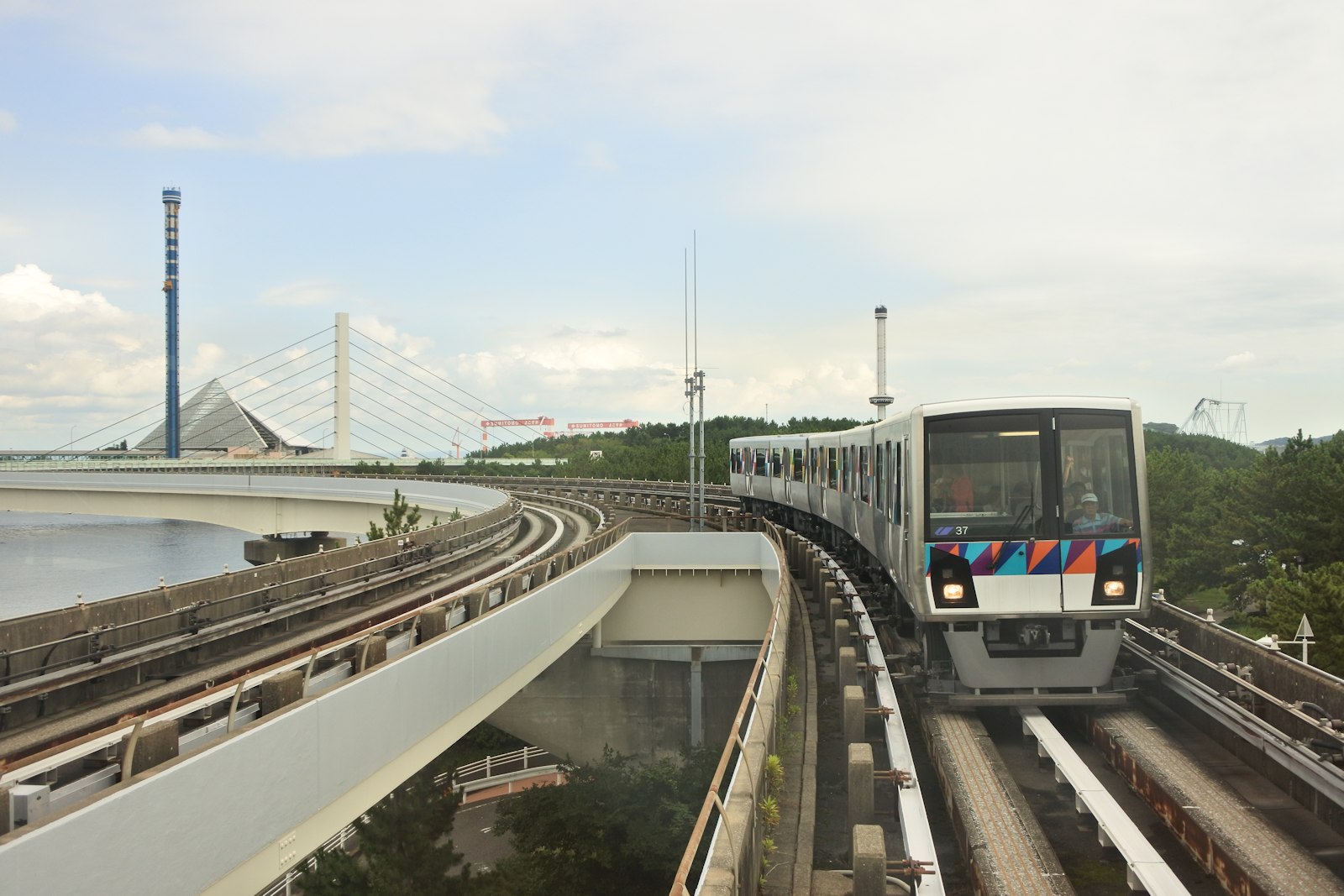
横浜・八景島シーパラダイスを背景に走る横浜シーサイドライン2000形
相鉄本線に続いては、横浜シーサイドライン金沢シーサイドラインへ。金沢シーサイドラインでの撮影は横浜新都市交通時代の2009(平成21)年以来で、2000形は初めての撮影となる。金沢シーサイドライン沿線の最大の観光地といえば、横浜・八景島シーパラダイス。ということで、同パークを背景に八景島駅へと入線する金沢八景行き列車を撮影。「ブルーフォール」「サーフコースター リヴァイアサン」「シーパラダイスタワー」といったアトラクションや、三角屋根の水族館の建物もしっかりと入れた構図で、これらのアトラクションや建造物がなるべく列車で隠れないようにして狙った。列車が来たときにちょうど、パークのアトラクションの1つ、「ブルーフォール」も上昇中だった。Following Sotetsu Main Line, I also photographed Yokohama Seaside Line Kanazawa Seaside Line. It was first time for me to go photographing the train on Kanazawa Seaside Line since 2009, in Yokohama New Transit period, and to do 2000 Series.I shot 2000 Series at Hakkeijima Station against Yokohama Hakkeijima Sea Paradise, an aquarium and amusement park and the most famous tourist attraction along Kanazawa Seaside Line. In the photograph, the rides, such as a free-fall ride "BLUE FALL", a roller coaster "Surf Coaster LEVIATHAN", and a revolving gyro tower "Sea Paradise Tower", and aquarium building are laid out not hidden by the train.When the train coming, "BLUE FALL", was going up.
Aug 13, 2017
コメント(0)
-
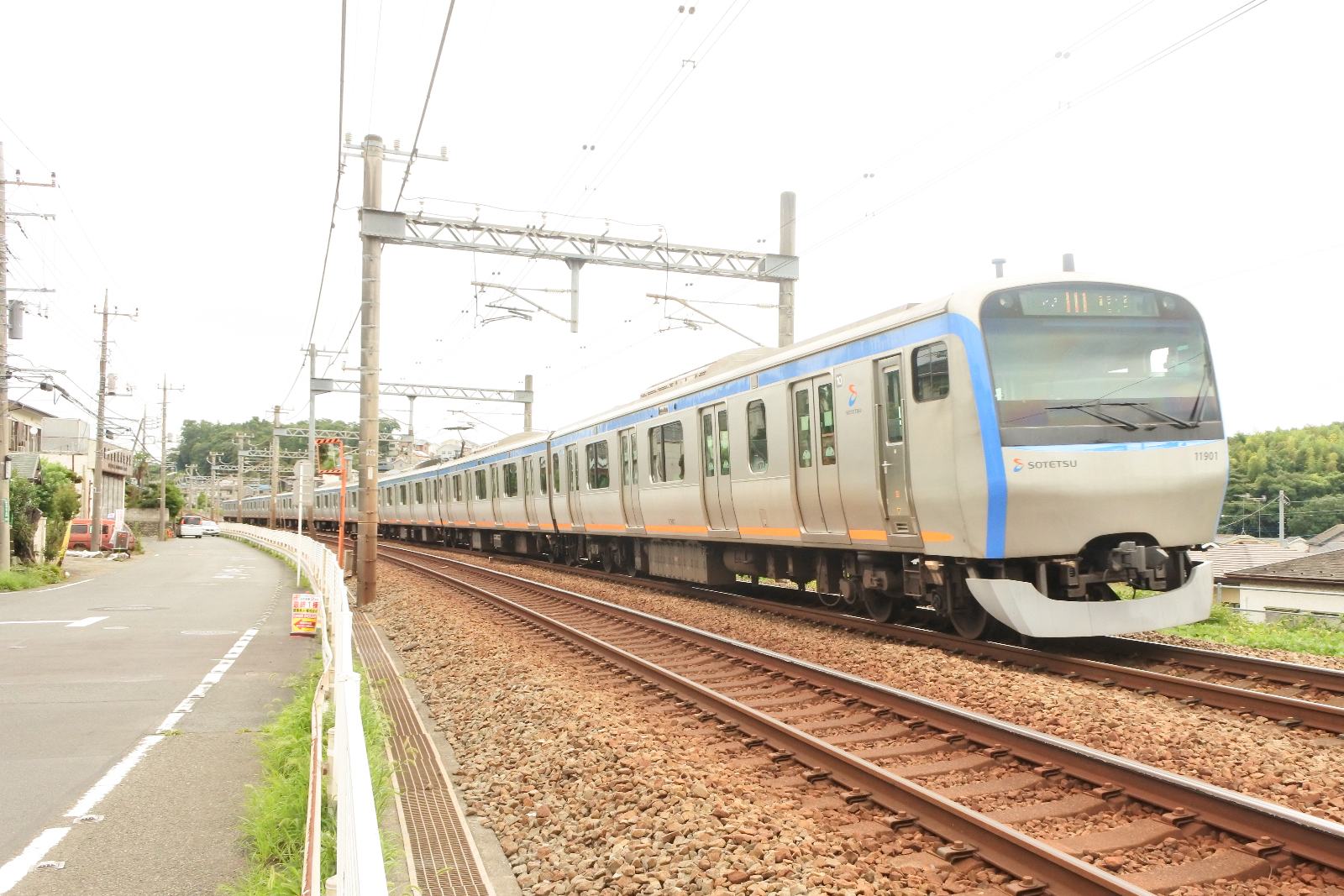
久々の相鉄電車撮影 11000系&9000系リニューアル車初挑戦
13日、2008(平成20)年以来9年ぶりに相鉄電車を撮影してきた。今回のメインターゲットは、デビュー以降1度も撮れていない11000系と9000系リニューアル車だが、8000系や7000系も併せて撮影した。撮影はすべてかしわ台駅~海老名駅間にて。11000系 11000 Series相鉄のゆるキャラ、そうにゃんのイラストがラッピングされた4代目「そうにゃんトレイン」となった11004F。 11004F set having livery of mascot of Sotetsu "Sonyan".9000系リニューアル車 refurbished 9000 Series沿線の住宅地を背景に横浜行き特急列車を撮影。横浜駅と横浜の郊外を結ぶ相鉄電車を表現。 Refurbished 9000 Series running toward Yokohama against the residences, which makes the image of the suburban railway connecting to/from Yokohama.この日は2017(平成29)年6月にリニューアルを終えたばかりの9702Fが本線の特急列車として運用されていた。 On that day 9702F set was in service as limited express train.8000系 8000 Series7000系 7000 Series2008(平成20)年に撮影した時には、「相鉄グループカラー」と呼ばれる灰色・青色(相鉄ブルー)・オレンジ色(相鉄オレンジ)の2017(平成29)年現在多数派を占める塗装が「新塗装」だったが、2016(平成28)年に「デザインブランドアッププロジェクト」が始動、それに伴って次の「新色」であるYOKOHAMA NAVY BLUEが登場したことから、こちらのほうが「新塗装」となってしまった。相鉄としても9000系リニューアル車のほか、2017(平成29)年12月にデビューが予定されている20000系の増備と併せて、2019年までの間に車両の塗装をYOKOHAMA NAVY BLUEに統一する方針でいることから、2008(平成20)年からの「相鉄グループカラー」は10年余りで姿を消すことになりそうだ。On 13th, I went photographing the trains on Sotetsu Main Line. This time the car which I would like to photograph was 11000 Series and refurbished 9000 Series, but I also another, such as 8000 Series and 7000 Series.All of these pictures above are photographed between Kashiwadai Station and Ebina Station.The last time I photographed in 2008, the majority body colour in 2017, gray, blue, and orange, used to be said the new colour, but in 2016, the car in new colour called "YOKOHAMA NAVY BLUE" appeared as a part of the company's "design brand-up project". The body colour of existing cars is also changing to the new one by 2019 as well as refurbished 9000 Series and newly-built 20000 Series starting regular service on December, 2017.相模鉄道 ニュースリリース 2015年11月5日 「相鉄グループ100周年と都心相互直通運転に向けて 「デザインブランドアッププロジェクト」が本格始動 」
Aug 13, 2017
コメント(0)
-
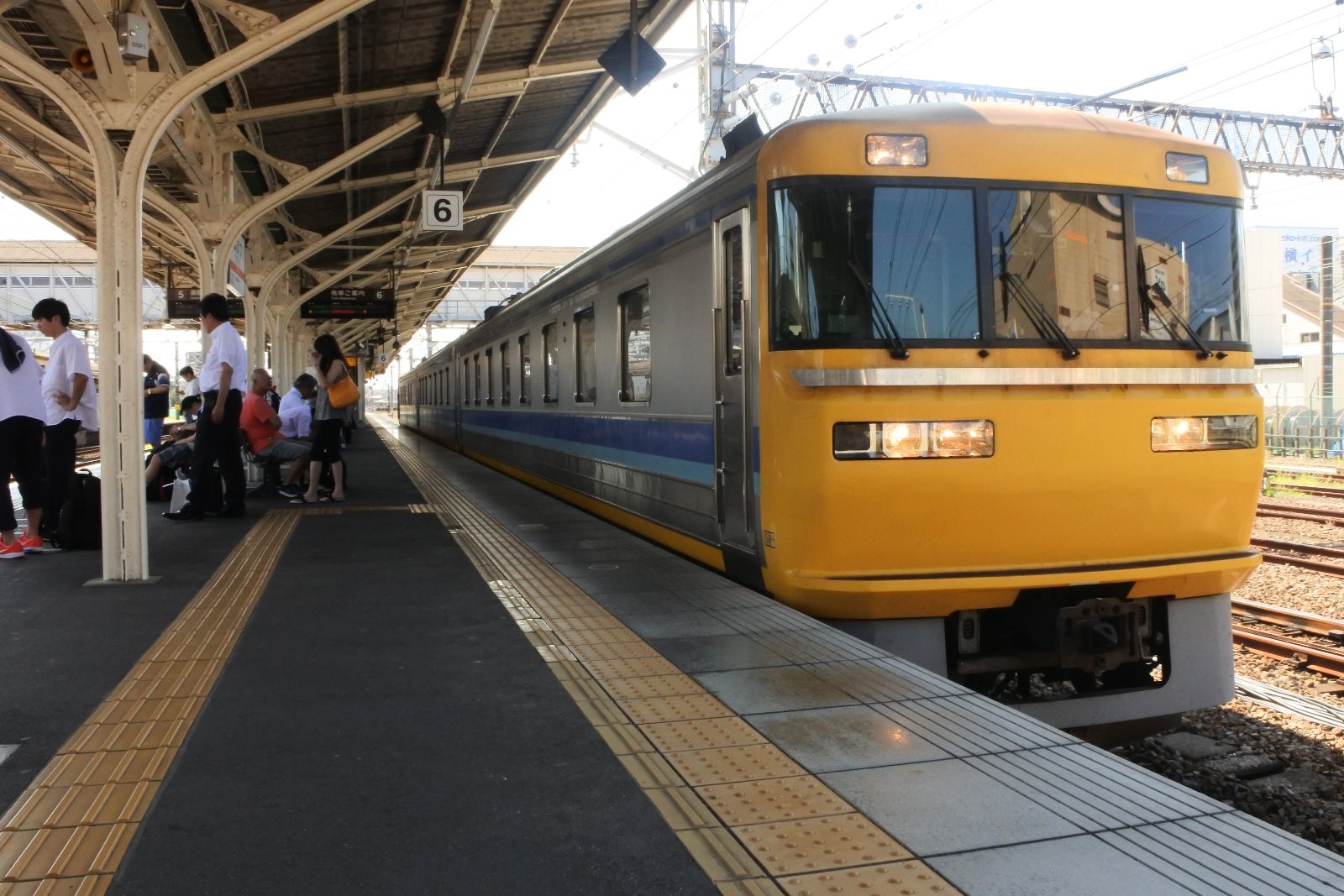
キヤ95系「ドクター東海」に遭遇
沼津駅での衝撃的な出会い、それはJR東海の在来線軌道・架線検測気動車、キヤ95系「ドクター東海」との出会いだった。この日は御殿場線を検測していた模様で、6番線ホームに入線した。キヤ95系はしばらく停車した後、再び御殿場・国府津方面へ引き返して行った。キヤ95系に遭遇するのは今回が初めてであったうえ、今回の場合は、伊豆長岡駅行きのバスに乗っていたら出会えなかっただけに、この出会いはとても印象深かった。I said something unexpected happened at Numazu Station. What I met was Kiya 95 Series, the car for inspection of railway and electric wire and is nicknamed "Doctor Tokai". It could be under inspection on Gotemba Line and came to track 6.Stopping a couple of minutes, it went back toward Gotemba and Kozu again.Because of not only first time, but if I had chosen to ride the bus for Izu-nagaoka Station, I couldn't have met it, it was all the more impressive.
Aug 6, 2017
コメント(0)
-
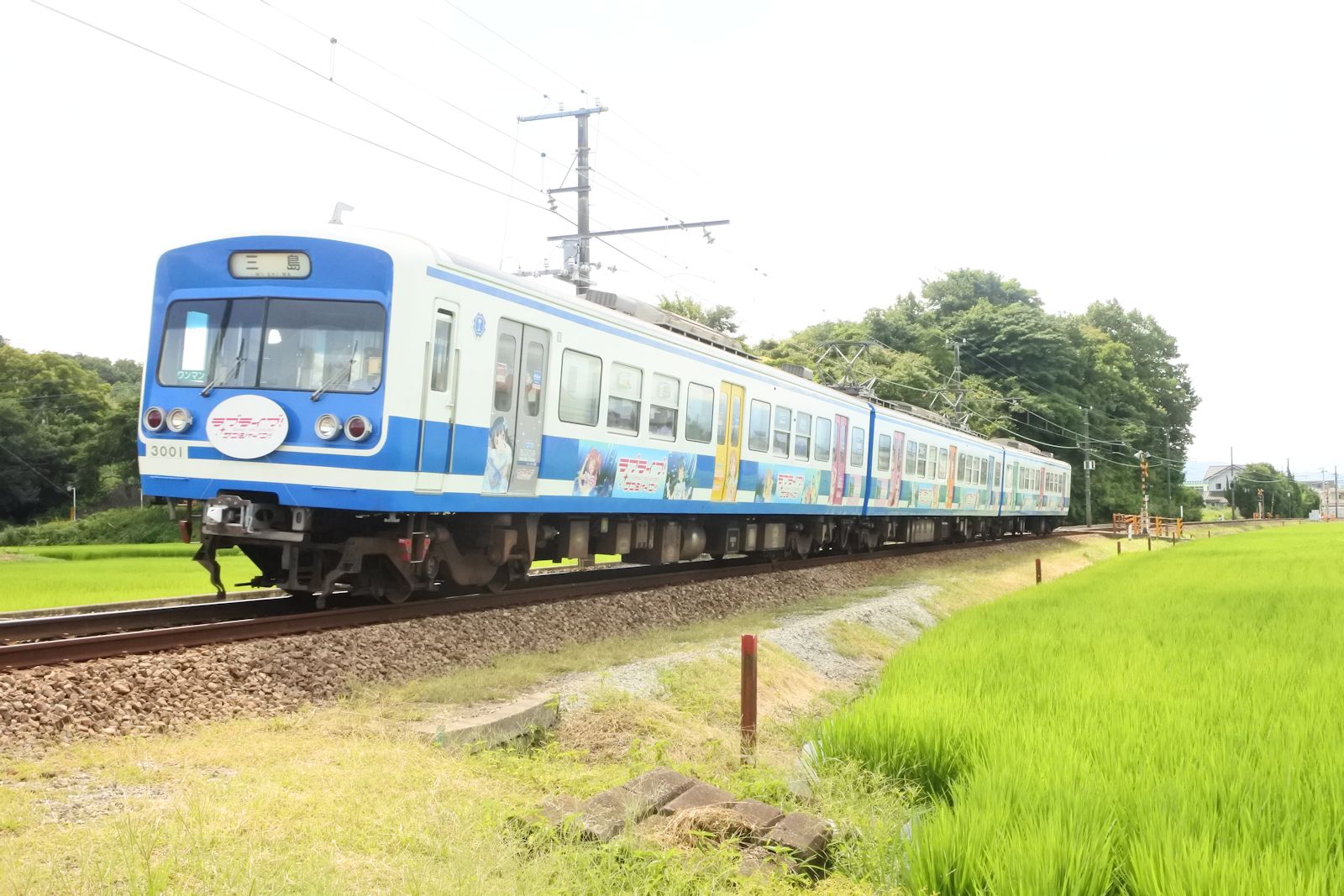
伊豆箱根鉄道駿豆線を撮る 3506F以外の車両達
3000系ステンレス車3506F以外にも、今回の旅で撮れた駿豆線の車両達も。I would like to show you the photographs of the other cars on Sunzu Line.3000系普通鋼車 3000 Series carbon steel body3501F 三島二日町駅~大場駅間 3501F set between Mishima-futsukamachi Station and Daiba Station3501F&3503F 修善寺駅 3501F set and 3503F set at Shuzenji Station1979(昭和54)年に、それまで在籍していた17m級車両を置き換え、車両の20m級化と冷房化を目的に登場。1982(昭和57)年までに3両編成4本が登場した。前面デザインは、同じ20m級3扉車両であり、伊豆箱根鉄道の親会社である西武鉄道の101系初期グループ(旧101系)に似た、2枚窓・中央配置の行き先表示を持つ。座席はセミクロスシート配置だが、3501Fのモハ3002号車のみ後に転換クロスシートに改造された。ちなみに同車が登場した1979(昭和54)年は、前年にプロ野球のライオンズが西武鉄道に売却され、福岡県福岡市から埼玉県所沢市に本拠地を移し、「西武ライオンズ」となって初めてのシーズンを迎えた年で、同車は西武鉄道グループの鉄道事業者の車両として、初めて「ライオンズブルー」をラインカラーとして採用した。3000 Series (carbon steel body version) debuted in 1979 to replace old 17-metre/669.3-inch-long cars without air conditioners.Design of its front is similar to Seibu 101 Series (first-made model) , having two glasses and destination indicator above the glasses laid out on its centre. Longitudinal seatings for two and transverse seatings for four facing two and two are laid out, but only those in Moha 3002 of 3501F set are changed to the ones with reversible backrest.Those cars first partly painted in "Lions Blue", which is the symbol colour of a Japanese baseball team, Saitama Seibu Lions, which was acquired by Seibu Railway, the biggest shareholder of Izu Hakone Railway, in 1978 and its home stadium changed to Tokorozawa City, Saitama Prefecture, from Fukuoka City, Fukuoka Prefecture, that year, among the cars held by railway companies of Seibu Railway Group.3000系ステンレス車 3000 Series stainless steel body3505F 三島駅 3505F set at Mishima Station1987(昭和62)年に旧型車両の置き換えを登場。3000系の増備車ではあるが、3504Fまでの編成とは違い、車体がステンレス製に、前面デザインが同じ伊豆箱根鉄道の大雄山線用の5000系に似たものに、側窓が1段下降窓に変更された。1987(昭和62)年製造の3505Fと1997(平成9)年製造の3506Fの2本が在籍している。3000 Series (stainless steel body version) debuted in 1987 to replace old cars. Though it was designed as 3000 Series, the design significantly changed, not only the material of the body, but also its front looking like that of 5000 Series on Daiyuzan Line and side windows.3505F set built in 1987 and 3506F built in 1997 are existing.7000系 7000 Series7502F 三島駅 7502F set at Mishima Station7501F 三島二日町駅~大場駅間 7501F set between Mishima-futsukamachi Station and Daiba Station1991(平成3)年に、旧型車両の置き換えと一部座席指定の快速列車用の車両として登場した。セミクロスシートだった3000系とは対照的に、全席が転換クロスシートとなり、中間のモハ7300形は快速列車の指定席車両として運用することを想定し、2ドアとなった。JR東海東海道本線への直通運転にも対応できる車両としても設計されたが、直通運転は実現しなかった。また快速列車の運行も1998(平成10)年に終了している。3両編成2本が在籍。7000 Series debuted in 1991 for partly reserved-seat rapid train service. All of seatings are 2+2 transverse ones with movable backrest, and the middle car, moha 7300, equips two doors on each side to manage as a reserved-seat car.It was designed as cars available to expected going-through service to JR Central Tokaido Line on that time, but the service wasn't realized. The operation of rapid train also ended in 1998.Two three-car sets are existing.1300系(元西武101系)1302F 三島二日町駅~大場駅間 1302F set between Mishima-futsukamachi Station and Daiba Station1302F 修善寺駅 1302F set at Shuzenji Station親会社である西武鉄道から101系後期グループ(新101系)を譲受した車両で、2008(平成20)年に駿豆線での営業運転を開始した。3000系普通鋼車に準じた白とライオンズブルーの塗装を纏うが、2016(平成28)年より1301Fが西武鉄道時代の西武イエローとベージュのツートンカラーを復活させた「YELLOW PARADISE TRAIN」として運行されている。3両編成2本が在籍。1300 Series moved from Seibu Railway, used to be named 101 Series (last version), and started to be in service in 2008 on Sunzu Line.Their body colour was similar to that of carbon steel 3000 Series, white and "Lions Blue". Since 2016, 1301F set revived that when it was in service on Seibu Ikebukuro Line, yellow and beige, and is nicknamed "YELLOW PARADISE TRAIN".Two three-car sets are existing.
Aug 5, 2017
コメント(0)
-
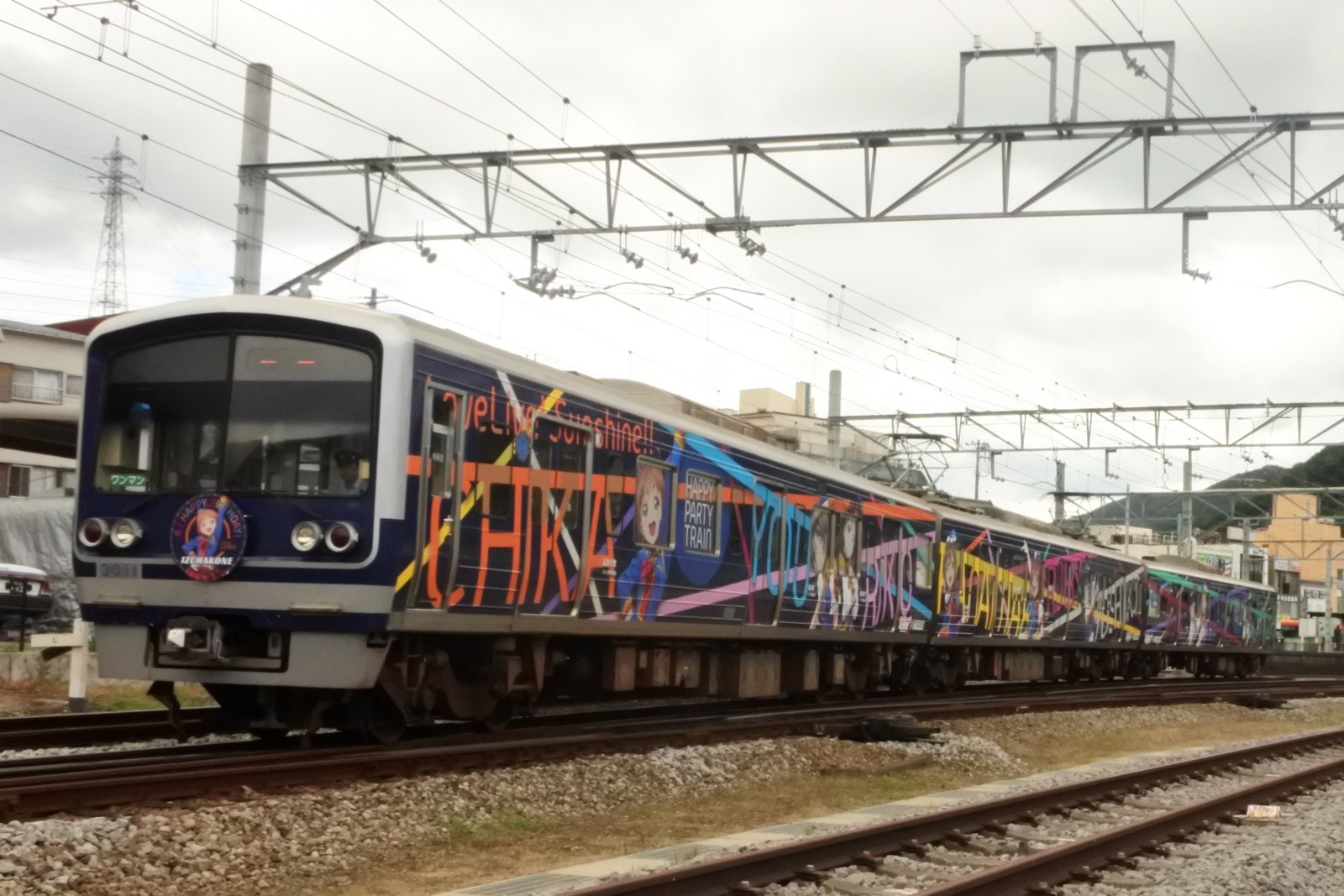
伊豆箱根鉄道駿豆線を撮る 3000系3506F
5日、伊豆箱根鉄道駿豆線へ撮影旅行しに行った。僕が駿豆線で旅をするのは、実に25年ぶりのことであるが、列車の写真を撮ることを目的に行くのは今回が初めてである。駿豆線には2017(平成29)年現在、3000系普通鋼車、3000系ステンレス車、7000系、1300系(元西武101系)の4車種が在籍し、これらすべての車種を撮りたいところだが、今回のメインターゲットは、駿豆線用の新造車としては最新の1997(平成9)年製であり、2017(平成29)年4月より、伊豆箱根鉄道が運営する水族館、伊豆・三津シーパラダイスが立地する沼津市内浦地区を舞台とするアニメ「ラブライブ! サンシャイン!!」(原作:公野櫻子先生)のラッピング車両として運行されている3000系ステンレス車3506F。僕が以前乗った時には影も形もなかった車両であるうえ、「ラブライブ! サンシャイン!!」のラッピング車両ともなれば、鉄道ファンとしても、公野櫻子先生の作品のファンとしても、ぜひとも乗車・撮影したい車両であった。車体には紺色を貴重に、同作のメインキャラクター9人の大きなイラストと9色のカラフルなライン(赤色、青色、黄色、紫色、灰色、青緑色、ピンク色、マゼンタ色、オレンジ色)が描かれている。よく注意して見てみると、彼女達の声を担当する声優さん(声優ユニット「Aqours」の各メンバー)によるサインや直筆メッセージも貼り付けられている。三島駅 Mishima Station三島二日町駅~大場駅間 Mishima-futsukamachi Station - Daiba Station 田京駅~大仁駅間 Takyo Station - Ohito Station牧之郷駅~修善寺駅間 Makinoko Station - Shuzenji Station修善寺駅 Shuzenji Station車内は、側扉間に2人掛けのロングシートと4人掛けのボックスシートを組み合わせた昔ながらのセミクロスシート。つり革は優先席部分を除いて、車体のラインと同様の9色に彩られている。また、編成中に18箇所ある側扉のうち9箇所には、Aqoursの各メンバーのサインが貼り付けられている。写真は伊波杏樹さん(高海千歌ちゃん役)のサインが貼り付けられた側扉 A pair of doors on which the autograph of Anju Inami, voice actress of Chika Takami, was attached.8月1日がメインキャラクターの1人、高海千歌ちゃんの誕生日ということで、7月25日から8月8日までの間、クモハ3011とクハ3506の前面には、千歌ちゃんのイラスト(車体ラッピングと同じ)が描かれたヘッドマークを付けて運行していた。On 5th, I went photographing Izu Hakone Railway Sunzu Line.It was first time in my 25 years to travel with Sunzu Line and very first time to come there for photographing.On that day, I mainly photographed 3000 Series 3506F set, which is the latest original model car build in 1997, and had a livery of "Love Live! Sunshine!!" anime or smartphone game (original work written by Sakurako Kimino) set in Uchiura, Numazu City, Shizuoka Prefecture, in which an aquarium managed by the railway company, "Izu Mito Sea Paradise" is located. Because I love both railway and Sakurako Kimino's novel, I had wanted to travel with and photograph it.The livery on the car body was coloured in navy blue and picture of nine main characters of the work and lines in nine colours (red, blue, yellow, purple, gray, emerald green, pink, magenta, and orange) were laid out. Paying attention to details, autographs by voice actresses of the characters (nine-member group "Aqours") were attached.In the cars, longitudinal seatings for two and transverse seatings for four facing two and two are laid out. Their hanging straps were coloured in the same ones as the body line. On the nine doors, the autographs were also attached.Because August 1st was the birthday of a main character, Chika Takami, front sign with her picture, the same as the one on the body, are put on both front cars from July 25th to August 8th.
Aug 5, 2017
コメント(0)
-

仲良し姉妹風お嬢ちゃん達
仲良し姉妹風お嬢ちゃん達 | 花見 友紀 [pixiv]大阪市交通局、泉北高速鉄道・南海電気鉄道、大阪高速鉄道(大阪モノレール)のドアステッカーのお嬢ちゃんが3人揃ったイラストを描いてみた。こうして3人が揃うと、鉄道事業者は違うものの、3人が仲の良い姉妹のように見える。もしも3人が姉妹だったらと想像して、背格好や髪形から、大阪モノレールのお嬢ちゃんがしっかり者で面倒見が良い長女、地下鉄のお嬢ちゃんが明るく元気いっぱいな次女、泉北高速鉄道・南海電車のお嬢ちゃんが純真無垢でちょっぴり甘えん坊な三女といった雰囲気で描いてみた。3人のステッカーが貼られた車両が走る4事業者の路線、およびそれらの車両が直通運転する路線同士の乗換駅は多い。大阪市地下鉄と大阪高速鉄道とが接続する駅は谷町線と大阪モノレール線の大日駅が唯一であるが、大阪市交通局の車両が乗り入れる他社路線を併せて見てみると、堺筋線列車が直通する阪急京都本線が南茨木駅で、同じく堺筋線列車が直通する阪急千里線が山田駅で、御堂筋線列車が直通する北大阪急行電鉄南北線が千里中央駅でそれぞれ大阪モノレール線と接続している。さらには大阪モノレール線には2030年春頃までに門真市駅~瓜生堂駅(仮称 近鉄奈良線八戸ノ里駅~若江岩田駅間に新規開業予定)の延伸計画があり、この計画が実現すると門真南駅で長堀鶴見緑地線と、荒本駅で中央線列車が直通する近鉄けいはんな線と乗り換えられるようになる。一方の大阪市地下鉄と泉北高速鉄道・南海電車は、御堂筋線・四つ橋線・千日前線と南海本線・高野線が難波(なんば)駅で、堺筋線と南海本線・高野線が天下茶屋駅で、御堂筋線と高野線・泉北高速鉄道線が中百舌鳥(なかもず)駅でそれぞれ接続している。また同一駅での乗り換えではないが、御堂筋線・堺筋線の動物園前駅と南海本線・高野線の新今宮駅、千日前線の桜川駅と汐見橋線の汐見橋駅がそれぞれ近接している。4事業者の車両が出会う駅が多いことから、3人のお嬢ちゃんも姉妹のように仲良しなのではと想像したことから、このイラストができた。それに加えて、もともとが引き込まれ事故を警告するキャラクターであるため、泣き顔以外のお嬢ちゃん達を描いてみたかったという理由もある。僕としては、公式でも3人のお嬢ちゃんが、マスコットキャラクターのかわいらしさでは関西一とされる京都市交通局に十分対抗できるほどのよりかわいらしいデザインにリファインされてほしいと願っているが、どうもそれは難しそうである。特に近年、泉北高速鉄道と大阪高速鉄道の2事業者は、トミーテックに「鉄道むすめ」を作ってもらい、両事業者とも車両のラッピングや駅ポスターなどに積極的に使用していることから、その可能性が低くなったと見ている。そして、3人それぞれと、各事業者の路線図を描いたものも描いてみた。大阪市交通局のものは交通局の路線と相互直通運転する各線、北大阪急行電鉄南北線、近鉄けいはんな線、阪急千里線・京都本線も併せて描き、大阪高速鉄道のものは門真市駅~瓜生堂駅間、大阪市交通局のものは北大阪急行電鉄南北線の千里中央駅~新箕面駅間、それぞれの延伸計画区間も破線で描いた。I fan-art the three girls from the mind-the-doors sticker of Osaka Municipal Subway, Osaka Monorail, Semboku Rapid Railway, and Nankai Electric Railway. This time, I did that of assembling as if they are sisters. If the three were sisters, "Osaka Monorail Girl" (on the left) was the oldest, "Osaka Subway Girl" (on the right) the second, and "Semboku Rapid Railway and Nankai Electric Railway Girl" (on the centre) the youngest. I also imagine that "Osaka Monorail Girl" looks gentle, "Osaka Subway Girl" does cheerful, and "Semboku Rapid Railway and Nankai Electric Railway Girl" does innocent.I have two reasons to fan-art them, many transfer stations and the girls not weeping.I found that many transfer stations on the lines of four railway companies or that the trains go through exist. The transfer stations between Osaka Municipal Subway or the railway lines which the trains go through and Osaka Monorail are Dainichi Station, Minami-Ibaraki Station, Yamada Station, and Senri-chuo Station.The transfer stations on Osaka Municipal Subway and Semboku Rapid Railway or Nankai Electric Railway also exist; Namba Station, Tengachaya Station, and Nakamozu Station. Also, some of that on subway lines and those on Nankai Electric Railway lines stand nearby; Dobutsuen-mae [Tennoji zoo] Station and Shin-imamiya Station, and Sakuragawa Station and Shiomibashi Station.If the extension of Osaka Monorail Main Line between Kadomashi Station and newly-opening Uryudo Station is to realise by 2030, Kadoma-minami Station and Aramoto Station are to become transfer stations.I also wanted to fan-art the girls showing their smile because the signs show the girls in painful situations.I wish the girls become as adorable as those of Kyoto Municipal Subway, whose mascots are the cutest among those in Kansai area. However, the "Tetsudou-musume" characters, collaborated with Tomytec and Semboku Rapid Railway or Osaka Monorail, appeared. Some carriages have a body livery of these characters. From my point of view, the refining of the three girls can't realise.I also represented the railway network of the lines, including those through which Osaka Municipal Subway trains go and planning sections.
Jul 30, 2017
コメント(0)
-
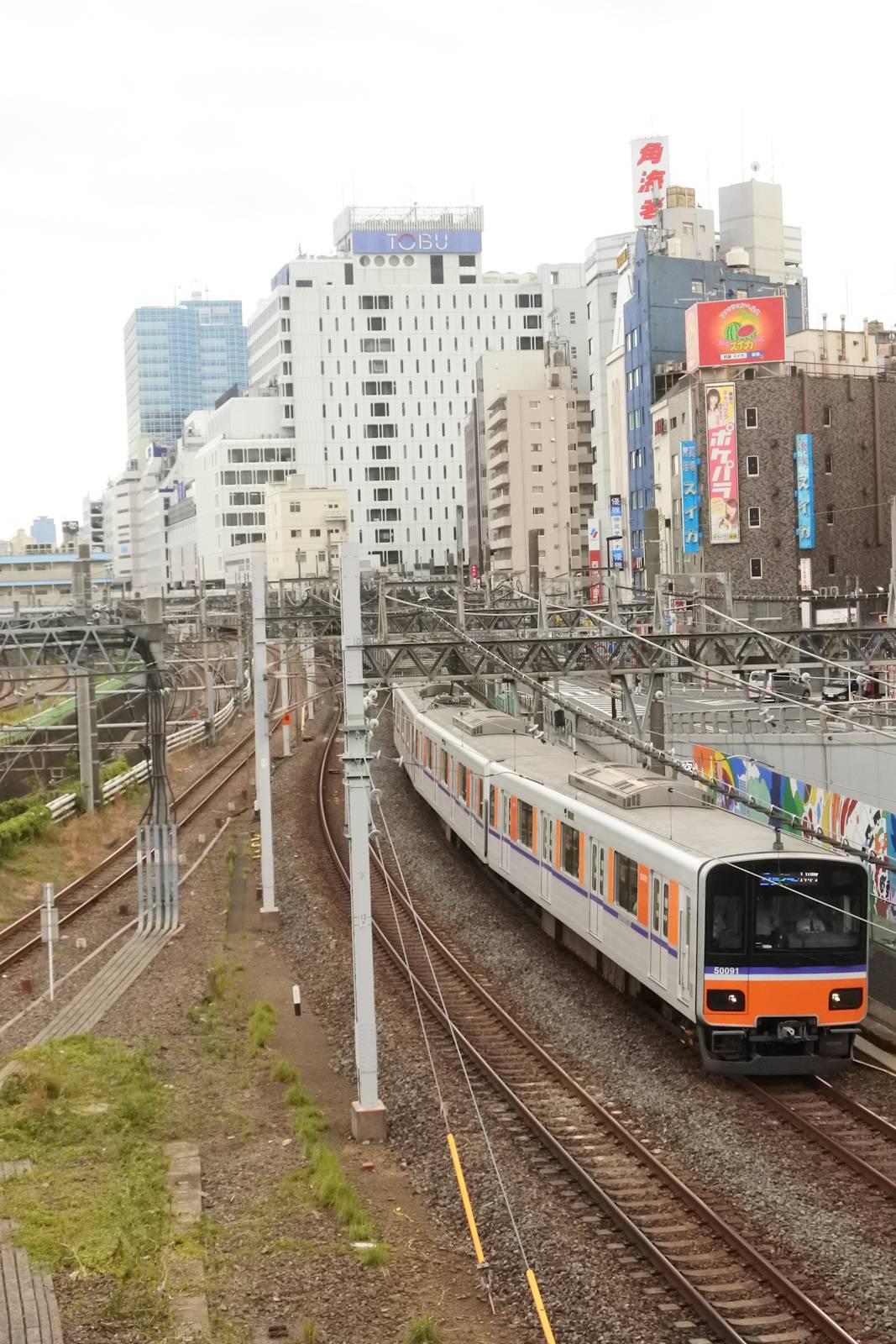
仕事帰りの乗客を送り届ける東武50090系「TJライナー」
夕方17:00、東武百貨店と池袋の雑居ビル群を背景に池袋駅を発車した東武50090系「TJライナー」を撮影。50090系はロング/クロス両用シートを備え、ロングシート状態で「TJライナー」以外の列車としても運行されるものの、「TJライナー」を主体として運行される車両として製造されたことから、「TJライナー」運用に就く姿を撮影した。この日は土曜日だったことから、乗客の多くが休日出勤で疲れていたことだろう。50090系はそんな人々に快適な必ず座れるクロスシートを用意して池袋駅で待っていた。そして乗客達をそれぞれの自宅近くの駅へと送り届ける。「TJライナー」が夕方~夜間にかけて運行されるホームライナー列車であることから、夕方池袋駅を発車して仕事帰りの乗客を送り届ける姿が、一番50090系らしいと考え、この1枚を撮った。At 5:00 PM, I photographed Tobu 50090 Series serving as "TJ Liner" against Tobu Department Store and buildings.Though 50090 Series equips convertible seatings that are configured in both longitudinal/forward-facing transverse style and runs not only as "TJ Liner" in longitudinal seatings style, I photographed it when in "TJ Liner" service because it was built as the car mainly for "TJ Liner".That day was a Saturday and the most of passengers could be holiday workers. 50090 Series waited for passengers getting tired in forward-facing transverse seatings configuration that passengers could ensure to sit on an unspecified one with additional seating fee and took them to the closest stations to their home, which could be seen for me as the best scenery of 50090 Series and "TJ Liner" train.
Jul 22, 2017
コメント(0)
-
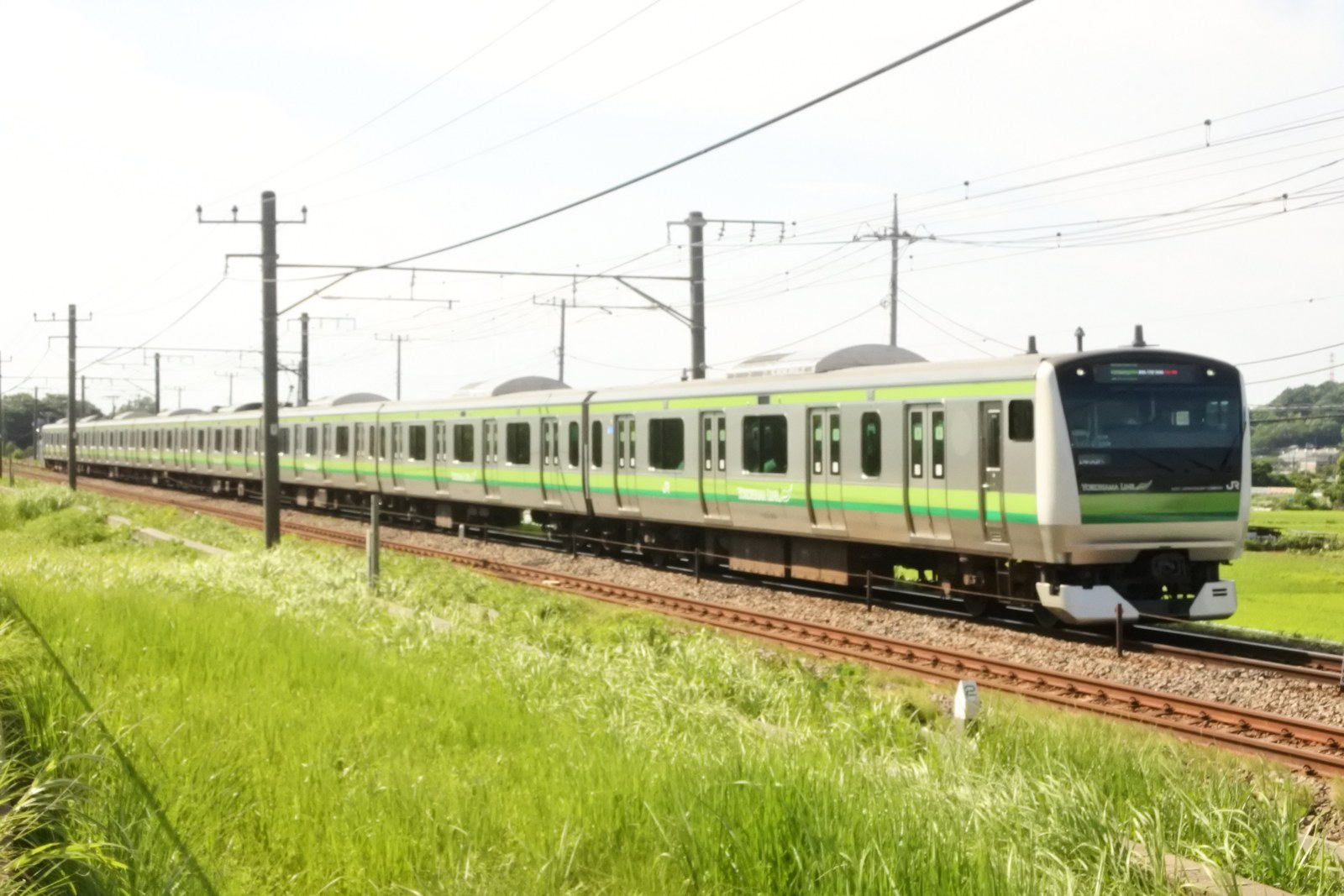
横浜線・南武線のE233系を撮る
E001系「TRAIN SUITE 四季島」に続いて、横浜線と南武線のE233系を撮影。E233系は数多くの車両基地に在籍し、僕も何度も撮影してきたが、鎌倉車両センター(横クラ)に所属する横浜線の6000番台車両と中原電車区(横ナハ)に所属する南武線の8000番台・8500番台車両はこれまで一度も写真撮影をしたことがなかった(南武線の8000番台車両についてはビデオは一度撮影している)。今回、6000番台車両と8000番台車両を初めて撮影した。6000番台車両(横浜線)十日市場駅~中山駅間ラインカラーの2色、黄緑色(黄緑6号 山手線のラインカラーと同じ)と深緑色(緑15号 埼京線のラインカラーと同じ)と調和する、沿線の農地と丘、法面に草が生い茂る盛り土の緑に囲まれた区間で撮影。8000番台車両(南武線)府中本町駅~南多摩駅間多摩川橋梁を渡る列車を、先ほどのE001系「TRAIN SUITE 四季島」と同様、川の流れと川原の草木とともに撮影。武蔵溝ノ口駅~武蔵新城駅間車両主体の構図で、左カーブに入る姿を捕らえる。これで、僕が撮影できていないE233系は南武線の8500番台車両を残すのみとなった。After photographing E001 Series "TRAIN SUITE Shikishima", I went photographing E233 Series on Yokohama Line (E233-6000) and Nambu Line (E233-8000).Though I had been photographed E233 Series many times, It was first time to photograph those on the two lines (I had recorded videos of Nambu Line's one once).The first one is Yokohama Line's one photographed between Tokaichiba Station and Nakayama Station, and when the train running on the embankment whose bushes on its foreslope harmonised with the car's line colour, light green, the same as that of Yamanote Line, and dark green, the same as that of Saikyo Line.The second is Nambu Line's one between Fuchuhommachi Station and Minami-tama Station, crossing Tamagawa River with the stream and greenery on riverbank like a photograph of E001 Series "TRAIN SUITE Shikishima".The third one is also Nambu Line's one between Musashi-mizonokuchi Station and Musashi-shinjo Station, the train is laid out on the right when it going onto a left curve.As a result, E233 Series I haven't photographed is only E233-8500 on Nambu Line.
Jul 22, 2017
コメント(0)
-

多摩川橋梁を渡るE001系「TRAIN SUITE 四季島」
5月4日に続いて、E001系EDC「TRAIN SUITE 四季島」を撮影。今回は中央本線(中央東線)立川駅~日野駅間の多摩川橋梁を渡る姿を撮影。「TRAIN SUITE 四季島」の春から秋のツアーには、3泊4日コース(上野駅→(東北本線・日光線経由)→日光駅→(日光線・東北本線・IGRいわて銀河鉄道いわて銀河鉄道線・青い森鉄道線・津軽線・JR北海道海峡線・道南いさりび鉄道線・JR北海道函館本線)→函館駅→(JR北海道函館本線・JR北海道室蘭本線)→登別駅→(JR北海道室蘭本線・JR北海道函館本線)→新函館北斗駅→(JR北海道函館本線・道南いさりび鉄道線・JR北海道海峡線・津軽線)→青森駅→(奥羽本線)→弘前駅→(奥羽本線・羽越本線)→鶴岡駅→(羽越本線)→あつみ温泉駅→(羽越本線)→新津駅→(信越本線)→東三条駅→(信越本線・上越線・高崎線・東北本線)→上野駅)と1泊2日コース(上野駅→(東北本線・東北貨物線・武蔵野線・中央本線)→塩山駅→(中央本線・篠ノ井線)→姨捨駅→(篠ノ井線・信越本線・しなの鉄道北しなの線・えちごトキめき鉄道妙高はねうまライン・信越本線・磐越西線)→喜多方駅→(磐越西線)→会津若松駅→(磐越西線・東北本線)→上野駅)があり、この日は1泊2日プランの1日目であった。この1枚は、大都会・東京を発車し、マンションと川の流れと川原・中州の緑が調和した郊外の住宅地を通り抜けて、これから各地を巡る旅へ向かう「TRAIN SUITE 四季島」を表現していると共に、暑い夏に東京近郊の川と緑と列車を入れた涼しげな写真として撮影した。写真の涼しげな雰囲気とは裏腹に、僕は暑い中、1時間以上土手でカメラを構えてE001系が来るのを待っていた。走行経路の違いから、同じ車両、同じ列車愛称でありながら、3泊4日コースと1泊2日コースとで違う背景で写真を撮ることができ、違った表情を見せてくれる点が、撮り鉄の目から見た「TRAIN SUITE 四季島」の特徴ではないだろうか。Following my blog on May 4th, I photographed E001 Series EDC (electric and diesel bi-mode car) "TRAIN SUITE Shikishima". This time where I did was a bridge crossing Tamagawa River between Tachikawa Station and Hino Station on Chuo Main Line.Two different types of tour travelling with "TRAIN SUITE Shikishima" are prepared; four-day trip toward Tohoku and Hokkaido and two-day trip toward Yamanashi, Nagano, and Fukushima, and on that day it was the first day of the two-day tour.This photograph features E001 Series running in suburb of Tokyo in which flats harmonises with river and riverside green grass when the train starting to travel toward Yamanashi Prefecture, and coolness in summer.However, in contradiction to the image of photograph, I had waited for the train for over one hour on riverbank in hot weather.From the photographer's view, two different schedules of "TRAIN SUITE Shikishima" may bring the photographers the chances to shoot pictures of the train with different scenery between them.
Jul 22, 2017
コメント(0)
-
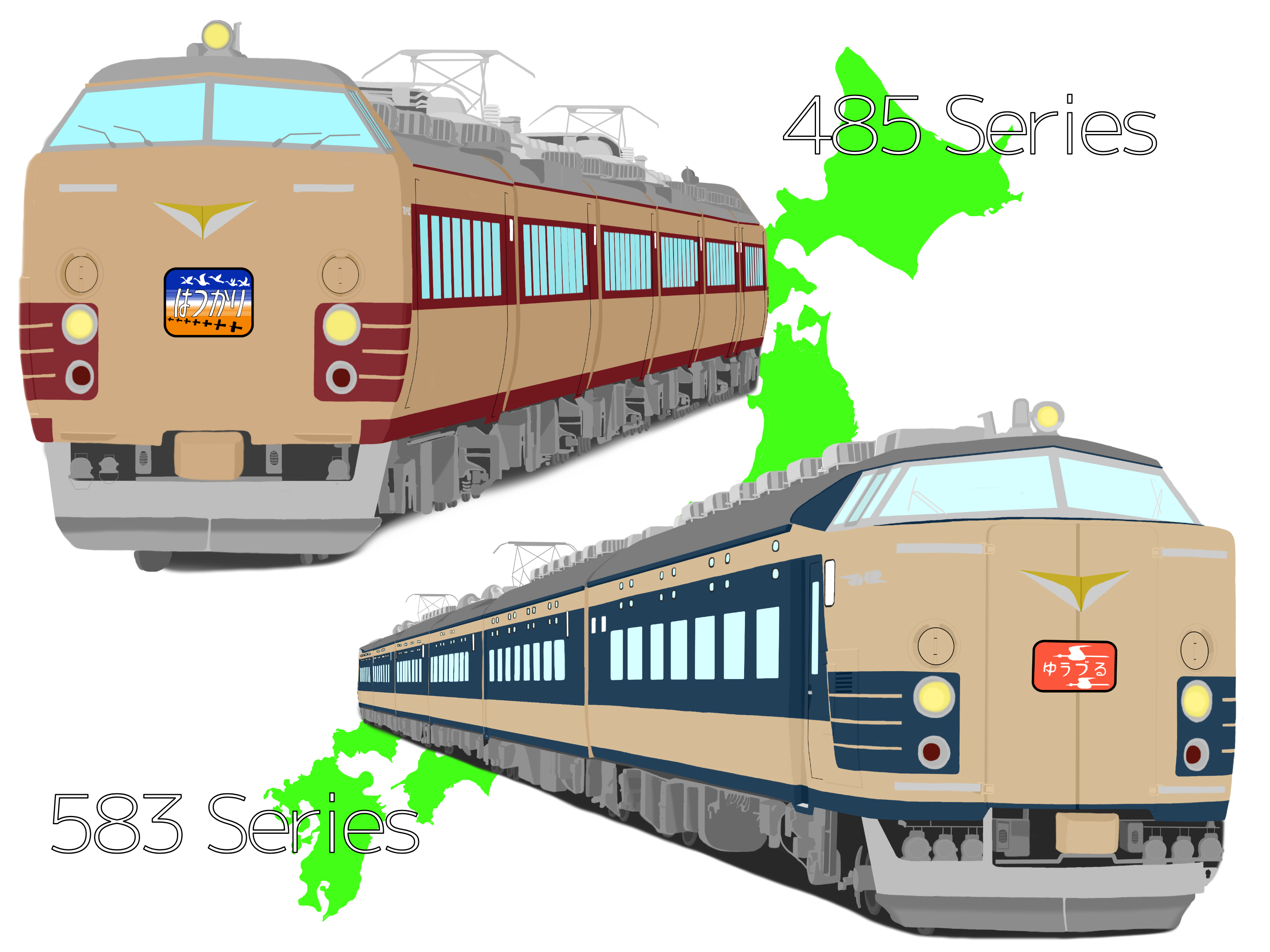
ありがとう 485系&583系
今年2017(平成29)年、国鉄時代に特急列車として日本全国を駆け巡った2車種、485系(ジョイフルトレインに改造されたものを除く)と583系が相次いで引退した。485系は、1964(昭和39)年に大阪駅~富山駅間の特急「雷鳥」としてデビューした直流・60Hz交流用の481系と1965(昭和40)年に1965年上野駅~仙台駅間の特急「ひばり」としてデビューした直流・50Hz交流用の483系の2車種を基に、国鉄の在来線で採用されていた直流・50Hz交流・60Hz交流の3種類すべての電化方式に対応した車両として1968(昭和43)年に登場した。先頭車両のデザインや耐寒・耐雪設備の有無などにより様々なバリエーションが存在し、481系・483系、そして信越本線横川駅~軽井沢駅間の碓氷峠の急勾配区間でのEF63形電気機関車との連結(協調運転)に対応した489系も含めて1,453両が製造された。一方の583系は1967(昭和42)年に大阪駅~博多駅間の寝台特急「月光」としてデビューした直流・60Hz交流用の581系を485系と同様の直流・50Hz交流・60Hz交流の3種の電気に対応した仕様に改良した車両として1968(昭和43)年登場した。昼間はボックスシートの座席車、夜間は3段(モハネ582のパンタグラフ下は2段)ベッドの寝台車として運行可能な昼夜兼用車両として、大阪~九州間、東京(上野駅)~東北間、大阪~北陸間を中心に活躍した。前述の「月光」でデビューしたことから「月光型電車」の愛称で呼ばれ、581系と合わせて434両が製造された。両車は電化されたすべての国鉄在来線を走行できる性能を最大限に活かし、数多くの特急列車として、当時電化区間がなかった四国を除く広範囲の路線で活躍した。しかし1970年代以降は新幹線の開業・延伸により、両車で運用される列車が次第に減少していく。1975(昭和50)年に山陽新幹線が博多駅まで全線が開業すると東海道本線・山陽本線から九州各地を結んだ昼行列車群が、続く1982(昭和57)年の東北新幹線大宮駅~盛岡駅間、上越新幹線大宮駅~新潟駅間の開業で上野駅~東北地方各地を結んだ昼行列車の多くが、廃止もしくは運行区間が短縮された。また583系については、これらの昼行列車の削減により、夜間の寝台特急運用が主体となり、デビュー当初の昼夜兼用のメリットも次第に薄れていった。1987(昭和62)年の国鉄民営化以降は、新幹線の開業・延伸に加えて両車の老朽化に伴う新型車両への世代交代、および夜行列車の利用客数低迷による運行本数の削減、廃車が始まる。特筆すべき変化としては、2001(平成13)年に大阪駅~青森駅間を結んだ、485系で運行される列車としては最長の1040kmを走破した特急「白鳥」が廃止に、2002(平成14)年の東北新幹線盛岡駅~八戸駅間延伸と同時に、盛岡駅~青森駅・函館駅間の特急「はつかり」が八戸駅~青森駅・函館駅間の特急「白鳥」に変更、上野駅~青森駅間の寝台特急「はくつる」の運行が終了。「はくつる」の臨時列車として運行されていた583系による寝台特急列車運用がなくなった。2011(平成23)年の九州新幹線博多駅開業と同時に九州での485系の運用が全廃、これと同時に新型車両への置き換え完了を理由に481系で初めて運行された特急列車の1つであった「雷鳥」も廃止された。2015(平成27)年の北陸新幹線金沢駅開業により新潟駅~金沢駅間の特急「北越」が廃止された。485系は新青森駅~函館駅間の特急「白鳥」が、583系は大阪駅~新潟駅間の急行「きたぐに」が、それぞれ特急・急行列車としての最後の活躍の場だった。「白鳥」は2016(平成28)年の北海道新幹線新青森駅~新函館北斗駅間の開業により廃止されたことにより、485系で運行される特急列車がとうとうゼロになった。一方の「きたぐに」は2012(平成24)年に定期運行を終え、翌2013(平成25)年には臨時列車としても廃止された。そして、2017(平成29)年、3月3日にジョイフルトレイン改造車を除く485系がえちごトキめき鉄道日本海ひすいライン・JR東日本信越本線を直通運転する糸魚川駅~新潟駅間の快速列車(毎日運行だったが臨時列車扱い)を最後に、4月9日に583系が秋田駅~弘前駅間の臨時列車「さようなら583系」号を最後にすべての営業運行を終えた。2車種の長年の活躍に感謝すべく、両車のイラストを描いた。ありがとう485系&583系 | 花見 友紀 [pixiv]日本各地を駆け巡った両車にちなみ、日本地図と共に、485系が「はつかり」、583系が「ゆうづる」のヘッドマークで描いた。「はつかり」は東京駅・上野駅~青森駅間、1982(昭和57)年の東北新幹線開業後は盛岡駅~青森駅・函館駅間を運行していた特急列車。1958(昭和33)年に東京と東北地方とを結ぶ初めての特急列車として登場した。初期は常磐線経由、1968(昭和43)年に583系が投入されてからは東北本線経由で運行された。485系は1973(昭和48)年より「はつかり」として運行されてきた。1988(昭和63)年の津軽海峡線(青函トンネル)開通時より、一部の列車が同線を経由して函館駅まで乗り入れ始めた。2002(平成14)年に運行を終了したものの、今なお東北本線を代表する特急列車のイメージが残り、東北新幹線東京駅~新青森駅間のE5系で運行される列車の愛称を一般から公募した時にも、結果は「はやぶさ」が採用されたが、最も応募数が多かったものは「はつかり」であった。「ゆうづる」は上野駅~青森駅間を常磐線経由で運行していた寝台特急列車。1965(昭和40)年に運行を開始し、583系は1968(昭和43)年から1994(平成6)年に廃止されるまで「ゆうづる」として活躍した。「ゆうづる」には583系の他、20系客車や24系客車によるブルートレインとして運行された列車もあり、国鉄時代には最大で1日に7往復も運行していた時期もあった。改めて、485系と583系の長年の活躍に、ありがとうと言いたい。In 2017, the two famous railway car for limited express trains in Japan National Railway (JNR) period, 485 Series (except converted ones for irregular or charter train) and 583 Series, retired.485 Series was built based on 481 Series, which was adapted for 1500-volt DC and 20000-volt, 60-hertz AC, and 483 Series, which was adapted for 1500-volt DC and 20000-volt, 50-hertz AC, and as the car available to be in service on all of three different kinds of electrified JNR Lines. 1,453 cars of 481, 483, 485, and 489, which could run on steep slope between Yokokawa Station, Gunma Prefecture, and Karuizawa Station, Nagano Prefecture, on Shinetsu Main Line (closed in 1997) coupled with Class EF63 electric locomotive, Series totally had been built and had variations of design of front car and snow- and cold-resistance or not.583 Series was built as an improved car of 581 Series, which was adapted for 1500-volt DC and 20000-volt, 60-hertz AC, available to be in service on all of three different kinds of electricity like 485 Series. Because of its debut as "Gekko" limited express, 583 Series used to be sometimes nicknamed "Gekko Type".583 Series is designed as the car which could be in service both on daytime and nighttime; its interior is convertible between transverse seatings and sleeper with triple-deck (partly double-deck) beds. It mainly used to be in service between Osaka and Kyushu, Tokyo and Tohoku, andOsaka and Hokuriku and Niigata. 581 Series and 583 Series had been built 434 cars.Both cars ran as many limited express trains to utilise their three-power-capable specification. However, since 1970s, as Shinkansen gradually extended farther, limited express trains on daytime stopped or decreased the number of their operation. In 1975, when Sanyo Shinkansen was extended to Hakata Station, Fukuoka Prefecture, all limited express trains on Sanyo Main Line toward Kyushu area on daytime ended their operation and in 1982, when Tohoku Shinkansen between Omiya Station, Saitama Prefecture, and Morioka Station, Iwate Prefecture, and Joetsu Shinkansen, between Omiya Station and Niigata Station, Niigata Prefecture, many limited express trains on daytime between Ueno Station, Tokyo, and Tohoku area ended their operation or shortened from/to the terminal of Shinkansen. The decrease of the daytime limited express trains also made the first design concept of 583 Series got less utilisable.After the privatisation of JNR in 1987, 485 Series and 583 Series got older and started to be replaced by new-type cars and the loss of passengers started to decrease the number of overnight trains operation, as well as the extension of Shinkansen and the decrease of daytime limited express.The notable ends of the operation of the two cars after the privatisation were "Hakucho" limited express between Osaka Station and Aomori Station, which was the longest distance, 1040 kilometre/646.2 mile, train 485 Series in service, in 2001, "Hatsukari" limited express renamed to "Hakucho" and shortened from/to Hahcinohe Station in 2002, when Tohoku Shinkansen was extended to Hachinohe Station, Aomori Prefecture, all limited express trains in Kyushu and "Raicho" limited express, which is the first train operated by 481 Series, between Osaka Station and Kanazawa Station, Ishikawa Prefecture in 2011 replaced by newer cars, "Hokuetsu" limited express between Niigata Station and Kanazawa Station in 2015, when Hokuriku Shinkansen was extended to Kanazawa Station.The last operation of 485 Series as limited express train was "Hakucho" limited express between Shin-aomori Station, Aomori Prefecture, and Hakodate Station, Hokkaido, until 2016, and that of 583 Series as express train was "Kitaguni" between Osaka Station and Niigata Station until 2013. In 2017, the two finished their operations carrying passengers; 485 Series operated as a rapid train from Itoigawa Station on Echigo Tokimeki Railway Nihonkai Hisui Line on March 3rd, and 583 Series did as a special tourist train "Sayonara 583 Series" between Akita Station, Akita Prefecture, and Hirosaki Station, Aomori Prefecture, on April 9th.To thank the two cars for their long-term service, I create a picture of them.485 Series was pictured with "Hatsukari" sign symbolising flying greater white-fronted goose and swans, and 583 Series was done with "Yuuzuru" sign symbolising flying crane."Hatsukari" between Ueno Station, Tokyo, and Aomori Station, Aomori Prefecture, started to run in 1958 as the first limited express train between Tokyo and Tohoku area. Though at first it ran via Joban Line, its route changed to via Tohoku Main Line when 583 Series debuted in 1968. 485 Series started to be in service as "Hatsukari" in 1973. When Tohoku Shinkansen opened, the train shortened from/to Morioka Station and some of them started to run to/from Hakodate via Seikan Tunnel in 1988. "Hatsukari" ended its service, but it gave railfans strong image of limited express train on Tohoku Main Line and is still beloved by railfans, which made the result on the vote of Tohoku Shinkansen train name between Tokyo Station and Shin-aomori Station that "Hatsukari" ranked the best (on that time "Hayabusa" was chosen)."Yuuzuru" was overnight train between Ueno Station and Aomori Station via Joban Line, which started to run in 1965. 583 Series had been in service between 1968 and 1994. During the height of it in JNR period, seven services of the train operated (three of them by 583 Series and the others by 20 Series or 24 Series passenger car).TOMIX Nゲージ 98961 限定 485系特急電車 仙台車両センター ・ A1 ・ A2編成 セット 6両価格:19970円(税込、送料別) (2017/7/16時点)98978 〈限定品〉JR 583系電車(ありがとう583系)セット(6両)[TOMIX]【送料無料】《12月予約》価格:17520円(税込、送料無料) (2017/7/16時点)485系物語 全国を席巻した国鉄代表形式 (キャンブックス) [ 梅原淳 ]価格:2052円(税込、送料無料) (2017/7/16時点)国鉄型車両 ラストガイドDVD1 583 系 [ (鉄道) ]価格:1028円(税込、送料無料) (2017/7/16時点)
Jul 16, 2017
コメント(0)
-

200km/h超で駆け抜けるN700系新幹線を撮る
3日、東海道新幹線のN700系を撮影してきた。東海道新幹線の車両は以前にも何度か撮影していたが、今回は200km/hを超えて走る新幹線らしい姿を撮りたいと、新横浜駅以西で狙いを定めた。今回の撮影地は神奈川県平塚市、東海道本線平塚駅より6km北上した水田が広がる場所。ここは。盛り土の上に線路が敷かれ、線路とのり面との境界近くに設けられたケーブルが少々邪魔になるが、防音壁がなく台車や床下まで奇麗に入り、16両編成の列車を端から端まで収めることができる。高速で走る新幹線の列車のスピード感を出す1枚を撮ろうと、流し撮りにも挑戦した。200km/h超のスピードで走る列車に合わせてカメラを動かすことが意外にも難しく、写真に収める対象を先頭車両1両に絞って、高速で駆け抜ける姿を捉えた。3枚目は「エアロ・ダブルウィング」と呼ばれる先頭形状を協調させた流し撮りで、N700系らしさを最大限に引き出した。On 3rd, I photographed N700 Series Shinkansen in Hiratsuka City, Kanagawa Prefecture, where the train runs at over 200km/124.3mi per hour.About 6km/3.7mi north from Hiratsuka Station on Tokaido Main Line, I found a Shinkansen track without noise barrier and 16-car sets could be photographed from the front to the end.I also tried to photograph by the method called "Nagashi Dori" that camera follows a moving subject while holding down the shutter.I felt it was little difficult to follow the high-speed Shinkansen and continued to try only the first car in the finder.The third picture, I shot the long and characteristic nose called "Aero Double-wing" to fully feature the character of N700 Series Shinkansen while running at high speed.
Jun 3, 2017
コメント(0)
-

E001系EDC「TRAIN SUITE 四季島」初撮影
4日、5月1日にデビューしたJR東日本E001形EDC「TRAIN SUITE 四季島」を初撮影。初撮影に選んだ場所は、高崎線宮原駅の1・2番線ホーム。ここの上尾方先端から、夕日を浴びながら黄金色(シャンパンゴールド)の車体を輝かせて上野方面へと向かうE001系の姿を捕らえた。撮影当日の5月4日は、3泊4日コースの4日目にあたる日。JR東日本の発表では、12:30頃に信越本線東三条駅を発車、17:20頃に上野駅に到着するダイヤが組まれていた。僕は2時間以上前から待機していた。その時はほとんど先客がいなかったが、次第に撮り鉄の姿が増えていった。16:00を過ぎた頃に、「『TRAIN SUITE 四季島』は16:42頃に当駅宮原を通過する予定です」という駅員さんのアナウンスが聞こえ、カメラと心の準備をした。通過予定時刻3分前に「上尾駅を定刻に通過しました」という駅員さんのアナウンスが流れ、いよいよ本番の時を迎える。ホームにいた撮り鉄達が一斉にカメラを構え始める。そして遂に、今回の撮影対象である高級感あふれる黄金色に輝く、そして個性的な側窓の車両が姿を現した。初めて間近に見たE001系に僕は胸を躍らせた。撮影後、僕は駅を通過するE001系に向かって手を振って歓迎した。E001系は今後、2017(平成29)年11月までは上野駅を起点・終点に、月曜日出発の3泊4日コース(上野駅~日光駅~函館駅~登別駅~東室蘭駅~新函館北斗駅~青森駅~鶴岡駅~あつみ温泉駅~東三条駅~上野駅 東北本線→日光線→東北本線→IGRいわて銀河鉄道いわて銀河鉄道線→青い森鉄道線→津軽海峡線→道南いさりび鉄道線→函館本線→室蘭本線→函館本線→道南いさりび鉄道線→津軽海峡線→奥羽本線→羽越本線→信越本線→上越線→高崎線経由)と土曜日出発の1泊2日コース(上野駅~塩山駅~姨捨駅~喜多方駅~会津若松駅~上野駅 東北本線→東北貨物線→武蔵野線→中央東線→篠ノ井線→信越本線→しなの鉄道北しなの線→えちごトキめき鉄道妙高はねうまライン→信越本線→磐越西線→東北本線経由)を運行予定。ちなみにE001形の車両番号はE001-1、E001-2のように付番されており、「クモキイテ」(モーターを搭載した運転台付き車両(制御電動車)を表す「クモ」、走行用エンジンを搭載した気動車を表す「キ」、1等(グランクラス)車を表す「イ」、展望車を表す「テ」)「モイネ」(モーターを搭載した中間車両(電動車)を表す「モ」、1等寝台車を表す「イネ」)「サイネ」(モーターを搭載しない中間車両(付随車)を表す「サ」、1等寝台車を表す「イネ」)「サイ」(モーターを搭載しない中間車両(付随車)を表す「サ」、1等車を表す「イ」)「サシ」(モーターを搭載しない中間車両(付随車)を表す「サ」、食堂車を表す「シ」)といった国鉄時代から続くカタカナ記号は使われていない。On 4th, I photographed JR East E001 Series EDC (electric and diesel bi-mode car) "TRAIN SUITE Shikishima" debuted on May 1st at Miyahara Station on Takasaki Line. In my photograph, E001 Series was running toward Ueno Station in the early evening and the sunset reflected its gold-coloured body.That day was the last day of its first four-day trip. JR East announced that the train departed from Higashi-sanjo Station on Shinetsu Main Line at 12:30 PM and arrived at Ueno Station at 5:20 PM.I've waited for over two hours before the train came, since when few photographers were stood on the end of the platform. Around 4:00 PM, a station staff announced that "TRAIN SUITE Shikishima" came there around 4:42 PM.At three minutes before the expected time when an announcement that the train passed at Ageo Station, one station before Miyahara, on time was heard, photographers including I started to be ready for shooting. Then, the train came and the photographers clicked away with their cameras.When I first saw the train, I got little excited and waved my hand to welcome it.Until November, 2017, E001 Series operates as "TRAIN SUITE Shikishima" for four-day trips from Monday toward Nikko, Tochigi Prefecture, Hakodate and Noboribetsu, Hokkaido, Aomori, Aomori Prefecture, Tsuruoka or Atsumi Hot Spring, Yamagata Prefecture, and Niitsu, Niigata Prefecture via Tohoku Main Line, Nikko Line, IGR Iwate Galaxy Railway Line, Aoimori Railway Line, Tsugaru-kaikyo Line, South Hokkaido Railway Donan Isaribi Tetsudo Line, Hakodate Main Line, Muroran Main Line, Ouu Main Line, Uetsu Main Line, Shinetsu Main Line, Joetsu Line, and Takasaki Line, and two-day trips from Saturday toward Enzan, Yamanashi Prefecture, Obasute, Nagano Prefecture, Kitakata and Aizu-wakamatsu, Fukushima Prefecture via Musashino Line, Chuo East Line, Shinonoi Line, Shinano Railway Kita-shinano Line, Echigo Tokimeki Railway Myoko Haneua Line, Shinetsu Main Line, Banetsu West Line, and Tohoku Main Line.
May 4, 2017
コメント(0)
-
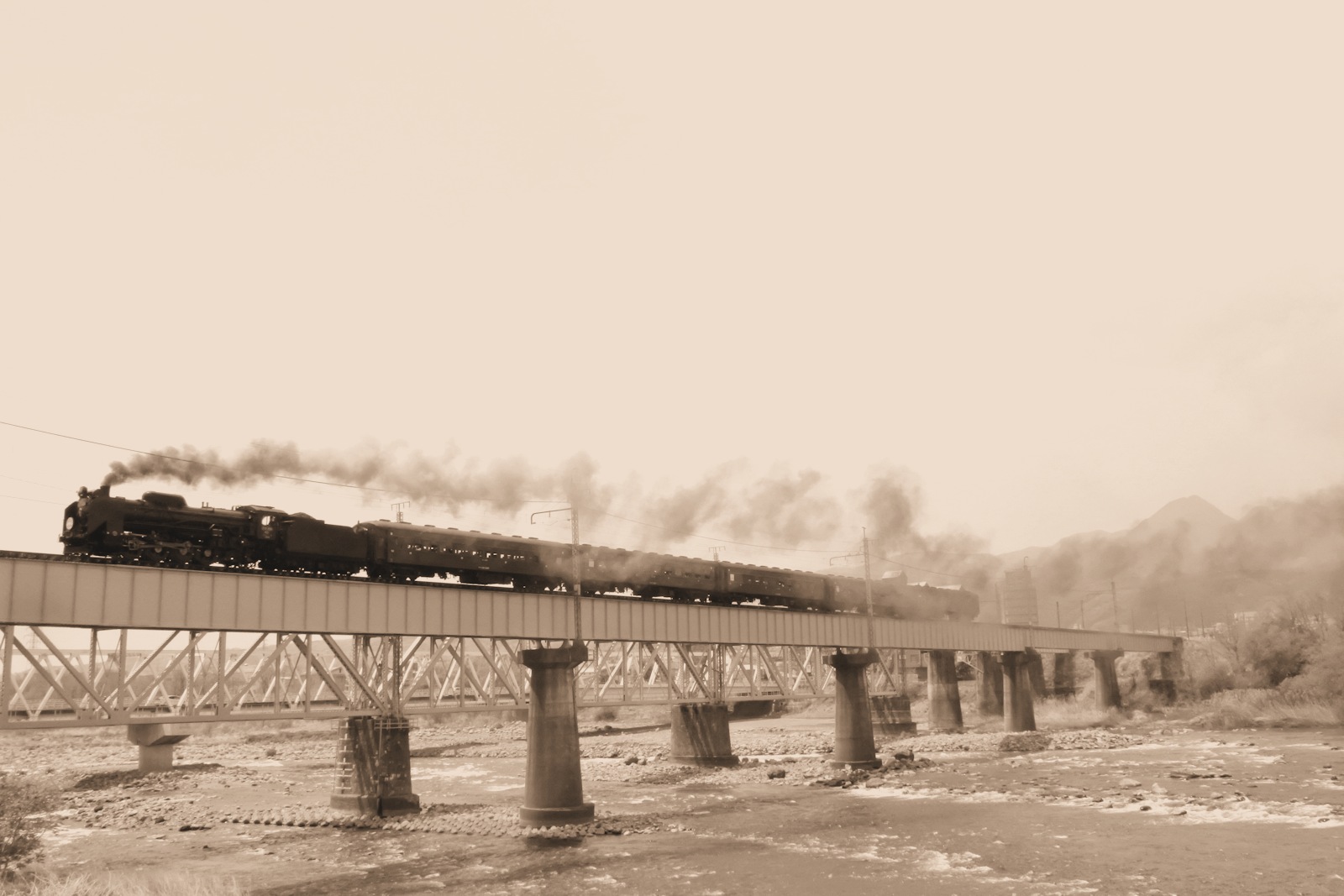
やっぱりSLには旧客が似合う
大型連休初日の29日、「SLレトロみなかみ」を撮影。以前から撮りたかった列車で、今回初めて挑戦した。「SLみなかみ」は土日・祝日を中心に上越線高崎駅~水上駅間を走る列車。高崎車両センター所属のC61形蒸気機関車またはD51形蒸気機関車が先頭に立ち、12系客車もしくはオハ47形・スハフ32形・スハフ42形・オハニ36形客車を牽引する。特にオハ47形客車等の旧型客車を連結して運行されるものは「レトロみなかみ」と呼ばれる。この日先頭に立っていたのは、日本を代表するSLである“デゴイチ”ことD51形蒸気機関車だった。今回は渋川駅~敷島駅間の利根川橋梁を渡る列車を撮影。「SLみなかみ」といえば、関東最大の川、利根川や緑豊かな自然がよく似合う列車だと思い、山々と利根川を背景に入れられる、なおかつ駅を発車してそれほど遠くない距離にあることから、SLが煙を吐きながら走る姿を捕えられることから、この場所を選んだ。そして、旧型客車を連結した「レトロみなかみ」として運行されるこの日を狙った理由は、SLが牽引する客車には12系客車や50系客車のような戦後生まれの車両よりも、旧型客車が似合うと思ったからである。そして、SLと旧型客車の古めかしい編成の列車を、より古めかしさを強調して見せるため、セピア色に加工してみた。On April 29th, the first day of holidays on April and May in Japan, I went photographing "SL Retro Minakami" on Joetsu Line, which I had longed to photograph."SL Minakami" runs between Takasaki Station and Minakami Station, Gunma Prefecture, on Joetsu Line, mainly on Saturdays, Sundays, and holidays, but not every time, by Class C61 or Class D51 Steam Locomotive hauling 12 Series or old-fashioned passenger cars, Oha 47, Suhafu 32, Suhafu 42, and Ohani 36. Especially, when the locomotives haul old-fashioned passenger cars, the train is called "Retro Minakami".On that day, Class D51 Steam Locomotive, the most famous steam locomotive in Japan, hauled the passenger cars.It was first time for me to photograph the train and where I photographed this time was a riverside street under the railway bridge between Shibukawa Station and Shikishima Station to shoot the one against the mountains and Tone River, which the train runs almost in parallel and when the locomotive bellowing steam and smoke during its acceleration because it was located not so far away from Shibukawa Station. I felt that the old-fashioned passenger cars built before World War II may be more suitable when they were hauled by a steam locomotive than the ones in the post-war period, such as 12 Series or 50 Series.I also made a sepia-colour version by retouching software.
Apr 29, 2017
コメント(0)
-
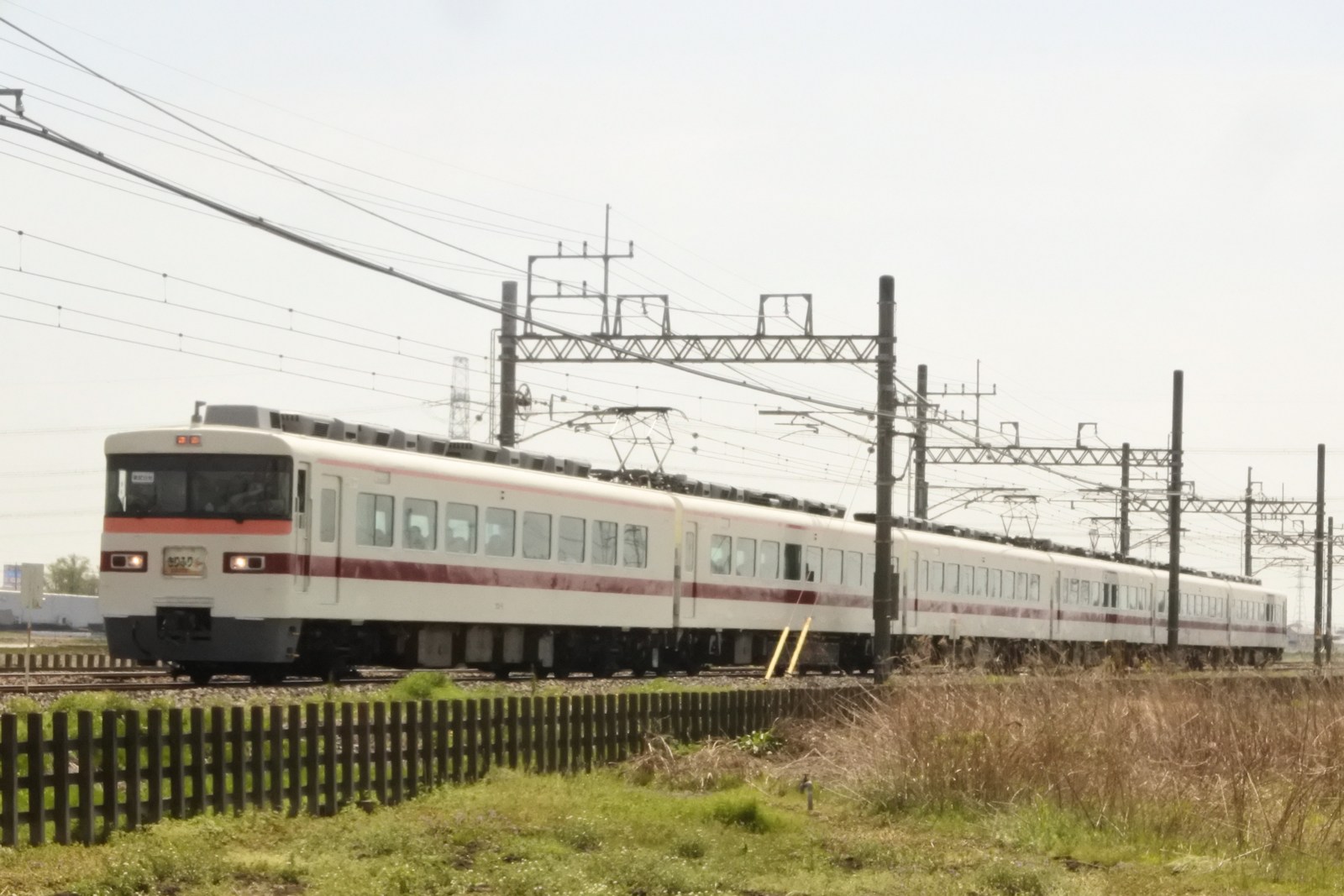
東武300系のラストランを撮る
4月16日、1991(平成3)年から東武日光線・鬼怒川線の急行(2006(平成18)年より特急に格上げ)列車「きりふり」「ゆのさと」として活躍してきた東武300系が土休日ダイヤ最後の運行に就いた(平日ダイヤは4月20日まで)。300系は1969(昭和44)年に伊勢崎線の急行列車「りょうもう」としてデビューした1800系を、急勾配区間での発電ブレーキ・抑速ブレーキの取り付けなど日光線・鬼怒川線に適合した仕様に改造した車両。6両編成だった1800系4本を6両編成2本と4両編成3本に改造し、6両編成は300系、4両編成は350系として区別され、300系は浅草駅~東武日光駅間の「きりふり」、浅草駅~鬼怒川温泉駅間の「ゆのさと」、350系は浅草駅~東武宇都宮駅間の「しもつけ」、浅草駅~会津田島駅間の「南会津」として運行された。来る4月21日のダイヤ改正で浅草駅~東武日光駅間の「きりふり」が2001(平成13)年以来16年ぶりに土休日の定期運行を再開することとなったが、これが350系での運行となり、平日夜間に運行されていた300系による浅草駅~春日部駅・南栗橋駅間の「きりふり」も500系「Revaty」もしくは100系「スペーシア」による「スカイツリーライナー」もしくは「アーバンパークライナー」に変更されるため、改正後は300系の定期運行がなくなることとなった。土休日ダイヤにおけるラストランとなった「きりふり275号」は、前面に通常の「きりふり」のヘッドマークに加えて、1800系時代の「りょうもう」での運用時を彷彿とさせる「東武日光」という行き先が書かれた板を乗務員室前面ガラスに吊り下げられていた(参考:「赤城」の行き先表示板を前面ガラス左上部に掲げる1800系「りょうもう」 Wikimedia Commonsより)。この日、駅のホームや沿線には300系の最後の勇姿を写真に収めようと、多くの撮り鉄の姿が見えた。僕は日光線東武動物公園駅~杉戸高野台駅間でカメラを構えた。線路脇に新緑が生え、季節感を出せることと、柵が車両の床下に引っ掛からず撮影することができることから、この場所を選んだ。この後東武日光駅では、列車到着後に300系の撮影会が行われた。26年間、いやより正確には44年間(300系へと改造された2本は1973(昭和48)年新造の1817Fと1818Fであるため)、お疲れさま。On April 16th, Tobu 300 Series, which had been in service as "Kirifuri" express between Asakusa Station and Tobu-nikko Station and "Yunosato" express between Asakusa Station and Kinugawa-onsen [Kinugawa Hot Spring] Station since 1991, finished its regular service on Saturdays, Sundays, and holidays (on weekdays until April 20th).300 Series had been converted from 1800 Series conformable to Nikko Line and Kinugawa Line, such as installing resistance and holding braking on steep. Four 6-car 1800 Series sets had been done into two 6-car 300 Series and three 4-car 350 Series sets, which have been in service as "Shimotsuke" express between Asakusa Station and Tobu-utsunomiya Station and had been in "Minami-aizu" express between Asakusa Station and Aizu-tajima Station until 2006.Why 300 Series retired was the car "Kirifuri", which had been in service only on high season since 2001 and restarts its regular operation on every Saturday, Sunday, and holidays from this coming April 22nd, 2017, changes to 350 Series and "Kirifuri" on weekday night is replaced by "Skytree Liner" or "Urban Park Liner" by 500 Series "Revaty" or 100 Series "SPACIA".During its operation on that day, the car showed a destination sign plate on its front, which could remind some railfans that when it used to serve as "Ryomo" before its conversion, as well as symbol illustration of "Kirifuri" (Tobu 1800 Series showing "Akagi" destination sign plate on its left from Wikimedia Commons).On that day, I saw many photographers on platforms or roadways along the railway.Where I photngraphed was between Tobu-dobutsu-koen [Tobu Zoo] Station and Sugito-takanodai Station because the embankment was little higher than fence and the green around the railway was beautiful.At Tobu-nikko terminal, a photographing event of the car was held.I would like to say goodbye and thank you to 300 Series for its 44 years (two sets had been built in 1973).
Apr 16, 2017
コメント(0)
-
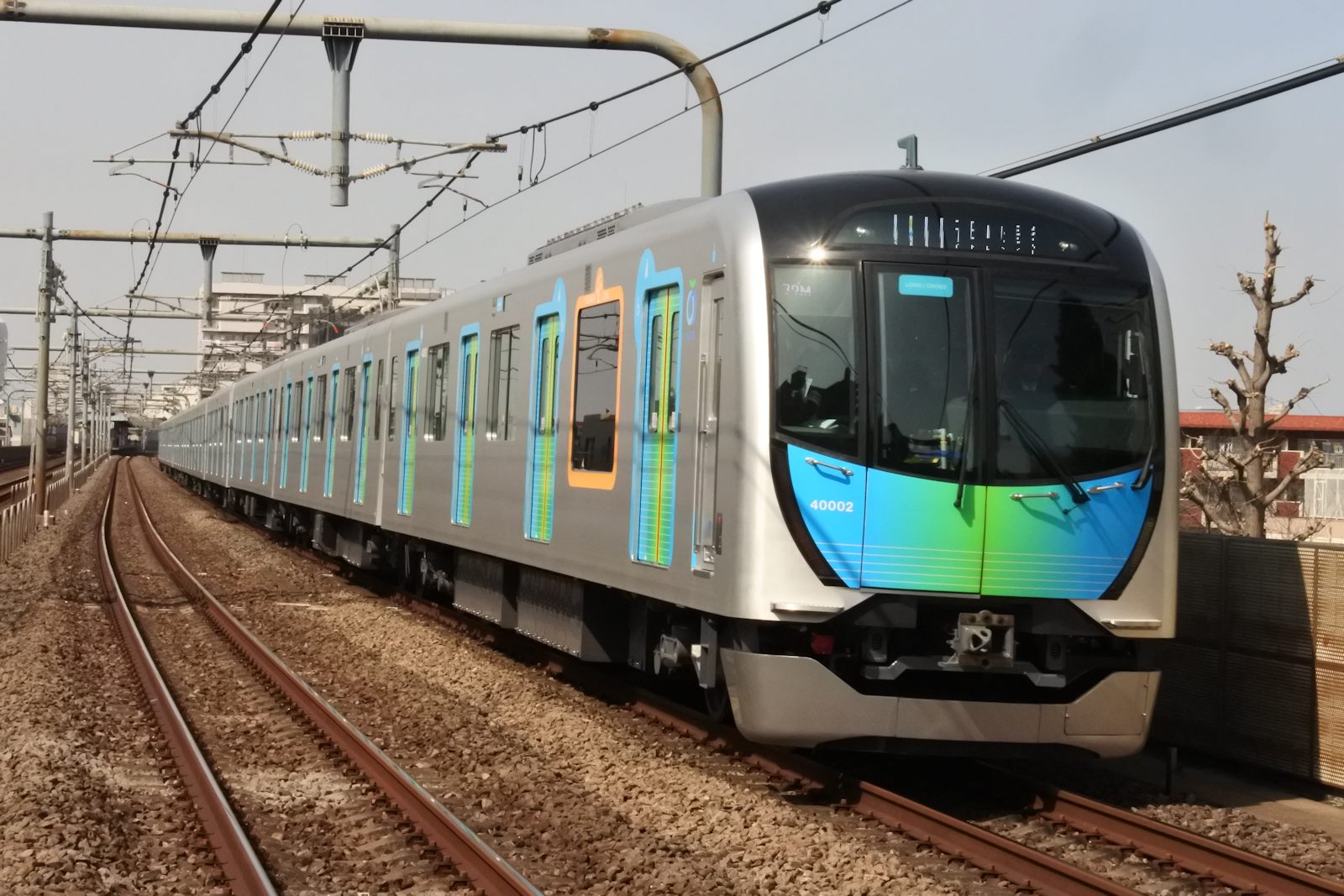
西武40000系「S-TRAIN」1番列車を撮る
25日、西武40000系による西武池袋線・西武秩父線・東京メトロ有楽町線・副都心線・東急東横線・横浜高速鉄道みなとみらい線を直通運転する座席指定制列車「S-TRAIN」が定期運行を開始した。早速僕は、元町・中華街駅発の北行き西武秩父行きと飯能駅発の南行き、それぞれの1番列車を撮影しに行った。元町・中華街駅発の西武秩父行き「S-TRAIN1号」は40101Fが、飯能駅発の元町・中華街行き「S-TRAIN2号」は40102Fがそれぞれ充当された。元町・中華街駅発西武秩父行き1番列車「S-TRAIN1号」 40101Fで運行 大泉学園駅~保谷駅間にて The first northbound "S-TRAIN" for Seibu-chichibu photographed between Oizumi-gakuen Station and Hoya Station飯能駅発元町・中華街行き1番列車「S-TRAIN2号」 40102Fで運行 中村橋駅にて The first southbound "S-TRAIN" for Motomachi-chukagai [Motomachi・Yokohama Chinatown] photographed at Nakamurabashi Station12日のお披露目イベントでは停車している40000系が中心だったが、今回は「S-TRAIN」の営業運転初日ということで、「S-TRAIN」として運行中の40000系の「一番その車両らしい姿」を撮ることができたと思う。近いうちに、横浜駅・元町・中華街駅方面か西武秩父駅方面へ40000系の「S-TRAIN」に乗って旅したいとも思う。On 25th, I photographed the first operations of Seibu 40000 Series, which started its regular service as "S-TRAIN" reserved-seating train between Motomachi-chukagai [Motomachi・Yokohama Chinatown] on Yokohama Minatomirai Railway Line and Seibu-chichibu on Seibu Seibu-chichibu Line via Tokyu Toyoko Line, Tokyo Metro Fukutoshin Line, and Seibu Ikebukuro Line, on Saturdays and holidays, or Toyosu Station on Tokyo Metro Yurakucho Line and Tokorozawa on Seibu Ikebukuro Line. I tried both northbound train for Seibu-chichibu from Motomachi-chukagai [Motomachi・Yokohama Chinatown] and southbound train for Motomachi-chukagai [Motomachi・Yokohama Chinatown] from Hanno.At the event on 12th at Sebukyujo-mae [Seibu Dome] Station, I mainly photographed the cars stopping and its interior. However, because of the first day of "S-TRAIN", I tried while the cars are in their regular services.Not only photographing, but I would like to travel with "S-TRAIN" for Yokohama or Chichibu.KATO 10-1403 西武鉄道40000系 10両セット 特別企画品 Nゲージ 動力車入り
Mar 25, 2017
コメント(0)
-
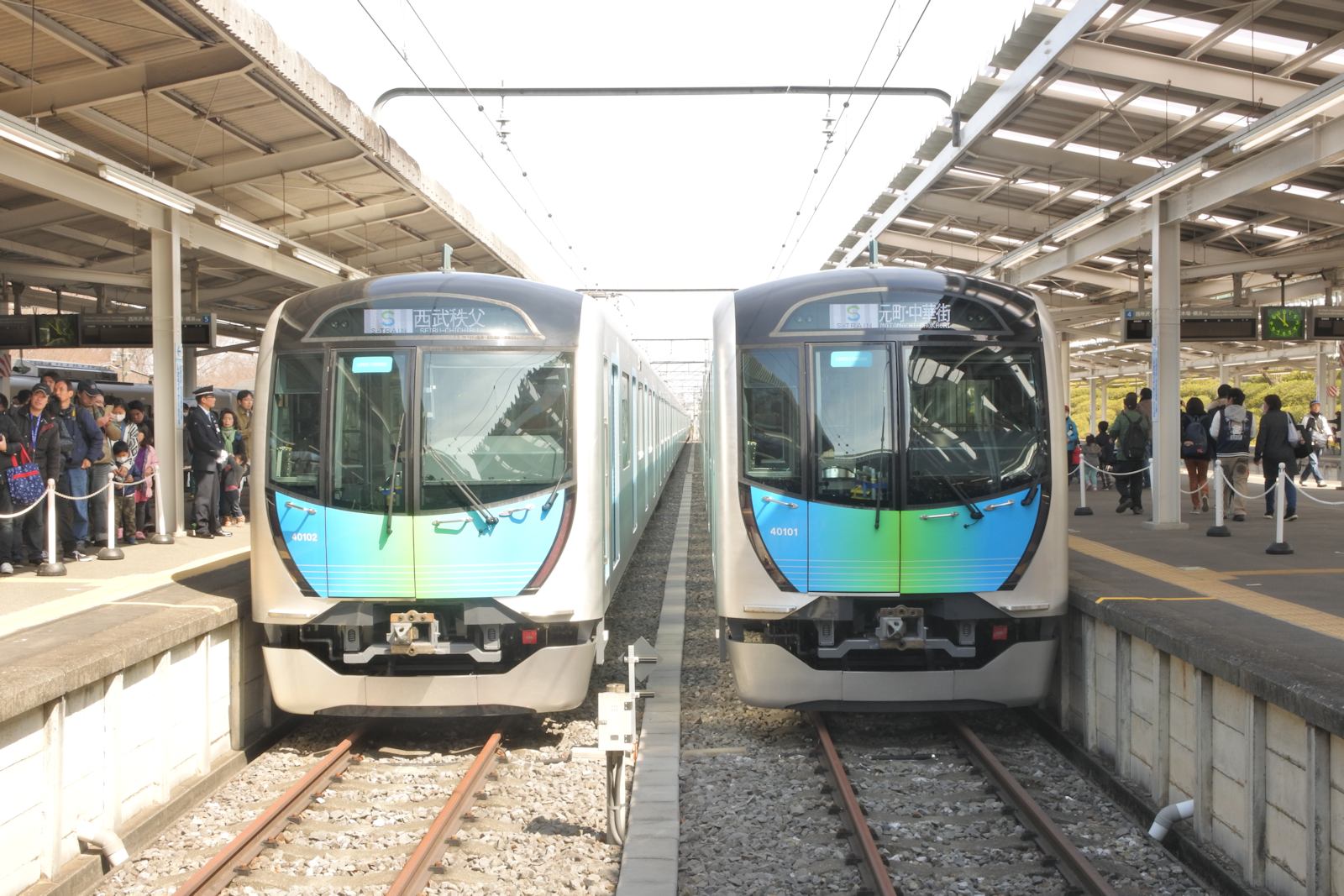
西武40000系お披露目イベントへ
12日、西武球場前駅で開催された西武40000系のお披露目イベントへ行ってきた。40000系は土休日は元町・中華街駅~西武秩父駅間、平日は豊洲駅~所沢駅間を走る座席指定列車「S-TRAIN」として来る3月25日にデビューする、西武鉄道の車両として初めてのロング・クロス転換シートを装備した車両。ロング・クロス転換シートのほかにも、電源コンセントやパートナーゾーン、トイレの設置などが目を惹く、2017(平成29)年の注目すべき車両の1つである。40000系は川崎重工業製であり、川崎重工業が西武鉄道向けに車両を新造することは、1927(昭和2)年に国分寺線・新宿線の前身である旧西武鉄道が導入したモハ550形電車以来、実に89年ぶりである。モハ550形は1966(昭和41)年に引退したことから、51年ぶりに川崎重工業製の西武鉄道の車両がお目見えすることとなった。この日はお披露目イベントと同時に、池袋駅~西武球場前駅間で40000系にとって初めてのお客さんを乗せての臨時列車が運行された。僕は初めてカメラを構える所沢駅~西所沢駅間で40000系を初撮影した。所沢駅~西所沢駅間を走る西武40000系40102F後続の各停列車で西武球場前駅に着くと、一度改札の外へ出るようにという内容の駅員さんのアナウンスが流れた。アナウンスに従い改札の外へ出てみると、イベント会場(4・5・6番線ホーム)への入場待ちの長蛇の列が。列に並ぶこと約40分、会場入口に着いた。通常使用する自動改札・有人カウンターとは別の、西武ドームでの野球の試合やイベント開催時に臨時改札口だった。4番線ホームに40101Fが「S-TRAIN 元町・中華街」の行き先を、5番線ホームには40102Fが「S-TRAIN 西武秩父」の行き先をそれぞれ掲げて停車していた。40101Fは車内見学が可能でサハ40401・モハ40501・サハ40601がロングシート、それ以外の車両がクロスシートの状態固定されていた。ドア上のスマイルビジョンは、25日以降の営業運転では見ることができない西武球場前駅発元町・中華街行きの「S-TRAIN」という設定の表示だった。40102Fはホームからの見学のみだった。ホームから西武鉄道管内にいながら、ドア上のスマイルビジョンは東急電鉄・横浜高速鉄道様式の表示で元町・中華街駅停車中の状態での「S-TRAIN 西武秩父行き」の案内を流していたのが見えた。また、時々クロスシートからロングシートへの転換の実演が行われた。それでは40101Fの車内へと入ってみよう。40101号車(飯能方先頭車)は立入禁止状態で、40201号車の連結面扉からクロスシート状態の内装を見るだけになっており、40201号車から40001号車の順番で見ていった。40000系の西武スマイルビジョンは、30000系などのドア上に加えて、クロスシート状態でも見やすいように、天井に取り付けられているものもある。40400形(飯能方から数えて4両目)の池袋・豊洲・元町・中華街方にはトイレが設置されている。特急型車両を除く西武鉄道の車両では4000系に次いで2例目であるが、4000系のものが和式であるのに対して、40000系のものは車椅子利用者も入れる広い空間の洋式である。通勤・近郊型車両のトイレとしては、JR東日本E233系(東海道本線・東北本線・高崎線・湘南新宿ライン用)のものと比べると、ベビーベッドがある分やや広く、木目調の化粧板から温かみある雰囲気を醸し出している。ちなみに車内にトイレがあるロング・クロス転換シートの車両はJR東日本仙石線の205系に次いで2例目となる。ロングシート状態の5号車と6号車に40000系を紹介するパネルが掲示され、車体の設計図や性能を知ることができた。クロスシート状態の車両の座席に座ってみた。40000系の座席にはドリンクホルダーが備え付けられているものの、あくまでも通勤型車両であるため、10000系「レッドアロー」のものようにテーブルは備え付けられていない。その一方で、クロスシート状態にある時には、特急型車両のものと同様に、回転させて向きを変えることができる。これは4人が向かい合って座れるようにするためでもあるが、元町・中華街駅~西武秩父駅間の「S-TRAIN」として運行される際に、途中の飯能駅で列車の進行方向が変わることから、進行方向に合わせて座席の向きを変えたいという乗客への気配りだと見て取れる。40000系はロング・クロス転換シート車両では初めて電源コンセントを備え、ノートパソコン、タブレットパソコン、スマートフォンなどの電源用・充電用として使えそうである。40000系の座席の座り心地は、同じロング・クロス転換シートを備える東武50090系のものと同等だった。写真は40002号車のパートナーゾーン(車外より撮影) Partner Zone of car 40002 of 40102F set photographed from a platform40000系最大の特徴と言える、大きな側窓と通路真ん中に置かれた腰掛けが特徴のパートナーゾーンはクハ40000形(池袋・豊洲・元町・中華街方先頭車)の乗務員室寄りに設置されている。両窓側はベビーカー・車椅子設置スペースとなっており、化粧板とつり革の色が他と違っている。側窓は背の小さな子供や車椅子利用者が車窓を見やすい大きさに設計されており、中央の腰掛けは互い違いに海側・山側それぞれの窓に向いており、腰掛けの裏側には車椅子用の固定器具が収納されている。イベントでも子供たちを中心に大人気だった。僕は賑わっていたパートナーゾーンを見ながら、この大きな側窓から車窓を見る子供と、後ろの腰掛けで子供を見守りながら同じ景色を見るお父さん・お母さんの姿を想像した。40000系が「S-TRAIN」として営業運転を開始したら、このほほえましい光景が見られることだろう。イベント終了後、復路(西武球場前駅発池袋行き)臨時列車が運行された。僕は石神井公園駅へ先回りし、同列車を撮影した。3月25日のデビュー前に40000系の魅力を思い切り感じ取ることができた1日だった。営業運転を開始したら、ぜひとも横浜方面へ、西武秩父方面へ乗ってみたいものだ。On 12th, I went watching the debut event of Seibu 40000 Series at Seibukyujo-mae [Seibu Dome] Station, which is starting to run as "S-TRAIN" reserved-seating train between Motomachi-chukagai [Motomachi・Yokohama Chinatown] Station and Seibu-chichibu Station on Saturdays and holidays and between Toyosu Station and Tokorozawa Station on weekdays equipped with rotating seatings that can be arranged both longitudinal and forward-facing transverse, electric sockets/outlets, a wheelchair-accessible restroom, and "Partner Zone" consisting of space for baby strollers or wheelchairs, large windows, which small children and wheelchair users can watch the view well, and small longitudinal seatings for two facing the windows.40000 Series was manufactured by Kawasaki Heavy Industry, which hadn't built any cars for Seibu Railway since 1927. The last ones were Moha 550 Series on Kokubunji Line and Shinjuku Line.On the very same day, the special first operation for 40000 Series carrying passengers between Ikebukuro Station and Seibukyujo-mae [Seibu Dome] Station. I photographed it between Tokorozawa Station and Nishi-tokorozawa Station, where I came first time.Taking a following train, I came to Seibukyujo-mae [Seibu Dome] Station. Then, I heard an announcement that people would like to join 40000 Series event should once go out of the gate and make an line. Following that, Waiting for about 40 minutes in a long line, I could enter the platform no.4 and 5 where two sets of 40000 Series, 40101F and 40102F set, and a 30000 Sereis, 30103F set functioning as the resting space, were stopping. the destination indicator of 40101F set showed "S-TRAIN for Motomachi-chukagai [Motomachi・Yokohama Chinatown]" and that of 40102F did "S-TRAIN for Seibu-Chichibu"40101F set opened up to people and its seatings in car 40401, 40501, and 40601 were set in longitudinal, and the others were transverse. Its LCDs above the doors "Smile Vision" indicated the special version, "S-TRAIN" from Seibukyujo-mae [Seibu Dome] to Motomachi-chukagai [Motomachi・Yokohama Chinatown], which people couldn't see in regular service after March 25th.40102F set was watched only from the platform. I saw that the LCDs shows in the style of Tokyu Corporation and Yokohama Minatomirai Railway, whose pieces of information were when the train stops at Motomachi-chukagai [Motomachi・Yokohama Chinatown] Station, and the seatings sometimes rotated between longitudinal and forward-facing.I started to watch the interior of 40101F set.The front car toward Hanno, 40101, was prohibited to enter and nine car, from second, 40201, to 40001, the last, were available to watch. I watched those nine cars.LCDs of 40000 Series are not only laid out above the doors like those of 30000 Series, but some of them are also on the ceiling to make easy to be watched by sitting passengers when the seatings in transverse configuration.A restroom equipped in car 40401 is designed for passengers in a wheelchair or accompanying babies. Comparing that of JR East E233 Series on Tokaido Main Line, Tohoku Main Line, Takasaki Line, and Shonan-shinjuku Line, it looks warm because of its grain-pattern colouration of the wall and little large space.40000 Series is the second car equipped rotating seatings following JR East 2005 Series on Senseki Line.The boards explaining the layout and the speculation of 40000 Series were exhibited in car 40501 and 40601.Sitting on a seating, I felt that it was as comfortable as that of Tobu 50090 Series'. I found that a table wasn't equipped on the back of the seatings unlike that of 10000 Series "Red Arrow".The seatings in transverse style, passengers could rotate it by themselves to form those for four facing two and two or to change those backward to forward at the station where the train reversed direction.40000 Series installs electric sockets to use for recharging battery of laptop computers, tablet computers, or smart phones. "Partner Zone", which attracted many passengers, especially small children, is laid out in 40001 between first door and second door from the driver's cab. While watching the space, I imagined that a young child watching the view from its large window and his/her parents sitting on the seatings and watching him/her.After the event ended, the other special train for Ikebukuro operated and I photographed it at Shakujii-koen [Shakujii Park] Station.I am looking forward to travelling with 40000 Series when going toward Yokohama or Seibu-chichibu.
Mar 12, 2017
コメント(0)
-
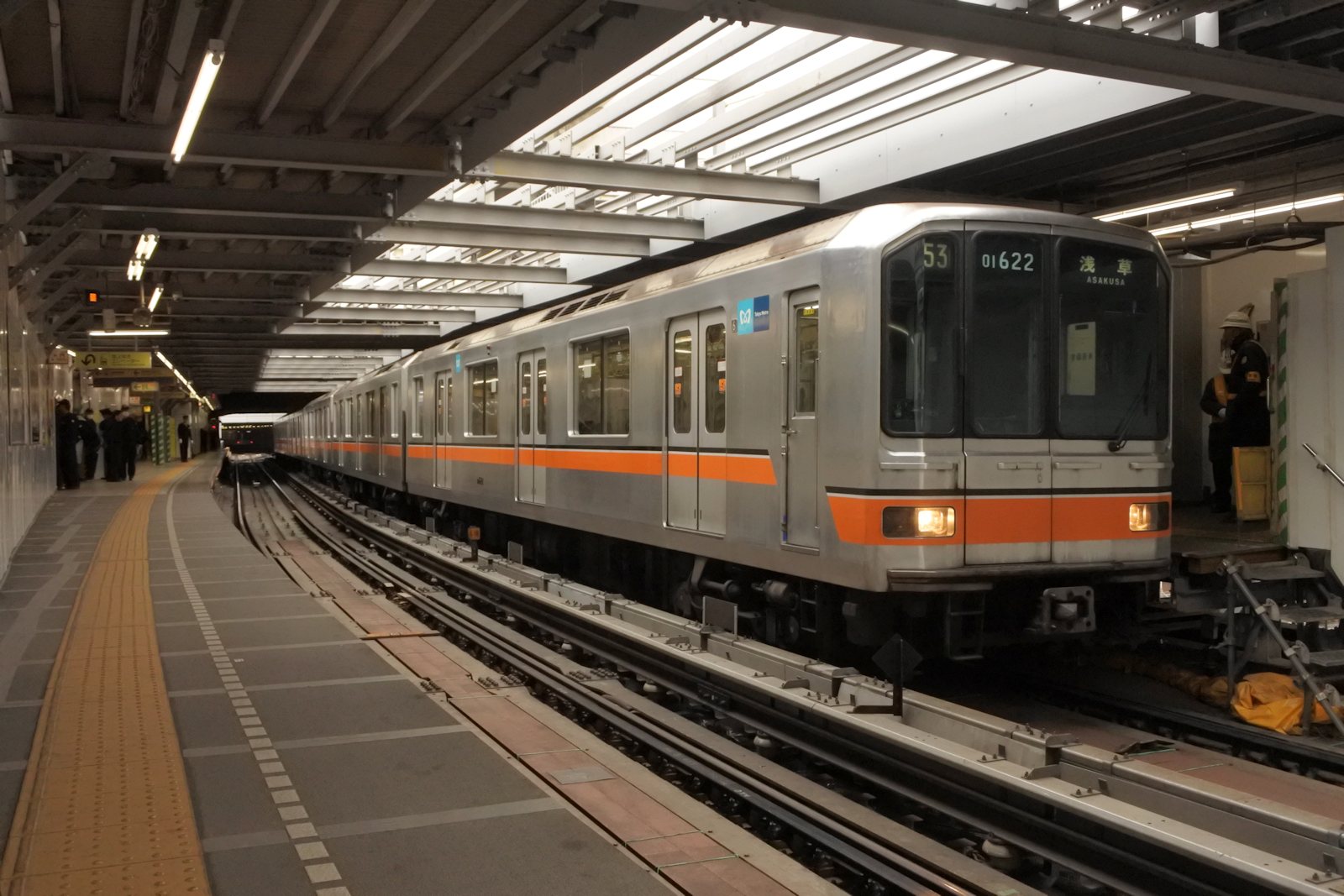
ラストラン直前 東京メトロ01系を撮る
東京メトロ1000系1139Fに乗ったのと同じ1月29日、1000系に置き換えられる形で数を減らしている01系も撮影した。01系は1983(昭和58)年から1997(平成9)年にかけて228両(6両編成38本)が製造された。01系は車体の規格が小さい銀座線に合わせて、機器の小型化・軽量化に力を入れたことが特徴。これまで千代田線用の6000系等で採用されてきた電機子チョッパ制御を、車体の長さが6000系等よりも4m短い16m級で、幅もこれらより0.25m狭い2.55mの小さな銀座線用の車両にも搭載できるように改良した、モーターの電機子(回転子)と界磁(固定子)を別々の制御装置で制御する高周波分巻チョッパ制御を採用した。発進加速時には、6000系等これまでの帝都高速度交通営団(営団地下鉄)の電機子チョッパ制御の車両とは異なる、音階で表すと、♪「ラレラー」という特徴的な音を発する。この他、ドアの開閉を音で知らせるドアチャイムやドア上鴨居に路線図式の案内表示器等、内装の接客設備も当時の最新のものを採用した。01-137Fと01-138Fは高周波分巻チョッパ制御からVVVF制御に変更して製造された。1000系の登場により引退・廃車が進み、2017(平成29)年1月現在、01-122Fと01-130Fの2編成が在籍している。このうち01-130Fは、1月1日から2月24日まで熊本県のマスコットキャラクター、くまモンがラッピングされて運行されている。熊本電気鉄道へ譲渡された車両(01-136F)にもくまモンがラッピングされており、その弟分として期間限定で銀座線でも運行されている。ラッピングのデザインは熊本電気鉄道の車両とほぼ共通のものとなっている。これら現役で残る2編成も、1000系の増備が終了することに伴い、2017(平成29)年3月10日での引退が決定している。引退した編成のうち、01-101Fは3両編成に短縮されたうえで中野車両基地で保存、01-135Fと01-136Fは熊本電気鉄道へ譲渡され、上熊本線で活躍している。上熊本線は銀座線とは集電方式と線路幅の規格が異なり、銀座線の第三軌条(サードレール)集電方式、1435mm軌間(標準軌)に対して、上熊本線は架空電車線(架線)集電方式、1067mm軌間(狭軌)であることから、シングルアームパンタグラフの設置と台車の交換が実施された。同時に高周波分巻チョッパ制御からVVVF制御へも改造された。On January 29th, the very same day as when I travelled with and photographed Tokyo Metro 1000 Series 1139F, I also photographed 01 Series, whose retirement on March 10th, 2017, had been announced.01 Series had been built 228 cars (thirty-eight 6-car sets) between 1983 and 1997.To match a small space, the underfloor equipment were designed to be emphasised on downsizing because the size of cars on Ginza Line is more 0.25-metre/0.82-foot narrow and 4-metre/13.12-foot shorter than 2.8-metre/9.19-foot wide and 20-metre/65.62-foot long 6000 Series on Chiyoda Line. 01 Series introduces the newly-developed pulse width modulation control system that voltage of field supply and armature supply circuits controlled by separated chopper. In addition, door chime and route map showing train's bound and where train runs above the doors. Different from pre-existing cars such as 6000 Series, this new-type chopper sounds like "A D A " in C major scale.The two last-made sets, 01-137F set and 01-138F set, were redesigned to adjustable voltage and frequency (AVAF) controlled car.in January, 2017, two sets, 01-122F and 01-130F, which have a livery of Kumamon, the mascot of Kumamoto Prefecture, like the ones moving to and in service on Kumamoto Electric Railway Kami-kumamoto Line between January 1st and February 24th, are existing.Among the ones already retired from regular operations, 01-101F set shortened to 3-car set and is preserved at Nakano Railyard and 01-635F set and 01-636F set moved to Kumamoto Electric Railway Kami-kumamoto Line, shortened to 2-car set, installed pantographs, and changed bogies to match 1.067-metre/42.01-inch gauge.01-122F01-130F
Jan 29, 2017
コメント(0)
-

新しいのに懐かしい 東京メトロ1000系1139Fに乗る
29日、去る1月17日より営業運転を開始した東京メトロ1000系の特別仕様車、1139Fに乗った。東京メトロ1000系は2012(平成24)年にデビューした銀座線用の車両。2組ある車軸のうち1軸にだけモーターを取り付け、モーターのない車軸の角度がカーヴの半径(R)に合わせて曲がりやすいように変わる操舵機構を採用した台車、消費電力が少ない永久磁石同期(PMS)モーター、LED車内照明・前照灯等の最新技術を導入した反面、銀座線の初代車両で、1927(昭和2)年の上野駅~浅草駅間開業時から1968(昭和43)年まで活躍した東京地下鉄道1000形に似せた黄色と茶色に銀座線のラインカラーである山吹色・白色・紺色のラインが入ったラッピングを纏った新しさと懐かしさが入り交じった車両である。これらの要素が評価され、2013(平成25)年に帝都高速度交通営団(営団地下鉄)・東京メトロの車両として初めてブルーリボン賞を受賞した。1000系の最終増備車である1139Fと1140Fの2本は、性能面ではそれまでの車両(1101F~1138F)と同様であるが、外観・内装をより東京地下鉄道1000形のそれを模した特別仕様車である。既存の編成との違いは、外観では、側面のラインを廃止し、前面の前照灯がそれまでの2灯から東京地下鉄道1000形と同じ1灯に変わった点が大きな特徴。内装では、木目調の化粧板を基調に緑色のモケットの座席、真鍮色の手すり、リコ式つり革(普段は荷棚に寄っており、乗客が手前へ引っ張って握る金属製のつり革)を模した雨粒形の持ち手のつり革、予備灯(1139F・1140Fではイベント列車として運行される時に使用。東京地下鉄道1000形ではポイント通過時等台車の集電装置(コンタクトシュー)が線路脇に設置された電気の流れているサードレールに当たっていない時に消灯する車内照明に代わって点灯した。東京メトロ1000系は集電装置がサードレールに当たっていない時には予備電源を使用するため普段は使用しない。)、東京地下鉄道1000形製造当時(1927(昭和2)年)のものを再現したメーカーと製造年次を示すプレート等、東京地下鉄道1000形の雰囲気を蘇らせている。僕は銀座線の数少ない撮影ポイントの1つ、渋谷駅の降車ホームでカメラを構え、1139Fが来るのを待った。撮影後、一度改札口を抜けて反対側の乗車ホームへと回り、上野検車区渋谷分室から折り返してきた1139Fの浅草行き列車に乗る。木目調の化粧板の車内は独特の温もりを醸し出している。Tokyo Metro ビジョンと両開きのドアから平成の東京メトロ1000系だと判別できるが、1139Fに乗った瞬間、昭和初期にタイムスリップしたかのような気持ちになれた。僕は終点・浅草駅まで乗車し、そのまま再び渋谷駅まで折り返した。2017(平成29)年12月30日、銀座線は上野駅~浅草駅間の開業から90周年を迎える。僕としては、同日に1139Fもしくは1140Fを使用した記念の臨時列車を運行してほしいところである。On 29th, I travelled with and photographed Tokyo Metro 1000 Series 1139F set, which is a special design car resembling to old 1000 Series, the first generation one on Ginza Line.Tokyo Metro 1000 Series debuted in 2012, introducing new technologies, such as bogies consisting of a motored fixed axle and a non-motored steerable axle, permanent magnetic synchronous motor, LED headlights and interior lights. On the other hand, its body colour was based on that of old 1000 Series, yellow and brown, on which three-coloured (orange, white, and navy blue) line is drawn.Evaluated in terms of these elements, 1000 Series won Blue Ribbon Prize in 2013, which was first time among cars of Teito Rapid Transit Authority and Tokyo Metro.The last-made two sets, 1139F and 1140F, are designed as the special car to recreate the atmosphere of old 1000 Series more than the existing ones.Of its exterior, the number of headlight becomes one from two and the line on the side is eliminated. Of its interior, woodtone wall panel, green-coloured seatings, brass-coloured grab handle, raindrop-shaped hanging strap designed in the image of old pivoted grab handles, and auxiliary lamps, which is for event use to copy the ones that old 1000 Series equipped lighted up when its interior got black out because its contact shoes of its bogies untouched third rail for electric supply, such as when the train switched.I waited for 1139F set coming at Shibuya Station, which is known as a rare photo spot on Ginza Line.Soon after photographing, I moved to opposite platform because the one where I photographed was arrival only.As I got on, I felt the characteristic atmosphere of its interior as if I was in 1920s or 1930s, the first ten years of Showa Period in Japan.I travelled one round trip on all line, between Shibuya Station and Asakusa Station.In 2017, Ginza Line marks its 90th anniversary since open of its first section between Ueno Station and Asakusa Station. I wish a special train to celebrate the 90th anniversary by 1139F or 1140F set between the first-opening section would operate on December 30th, its opening day.渋谷駅に停車中の1139F 1139F set stopping at Shibuya Station1139Fの内装 Interior of 1139F set製造年次・製造メーカーを示すプレート A plate showing built year and factory1139Fの座席 Seating of 1139F set1139Fの荷棚とつり革 luggage rack and hanging strap of 1139F東京地下鉄道1000形のリコ式つり革をイメージした1139Fのつり革 hanging strap of 1139F designed in the image of pivoted grab handles渋谷駅へ入線する1139Fを渋谷ヒカリエから臨む 1139F set arriving at Shibuya Station from Shibuya Hikarie
Jan 29, 2017
コメント(0)
-
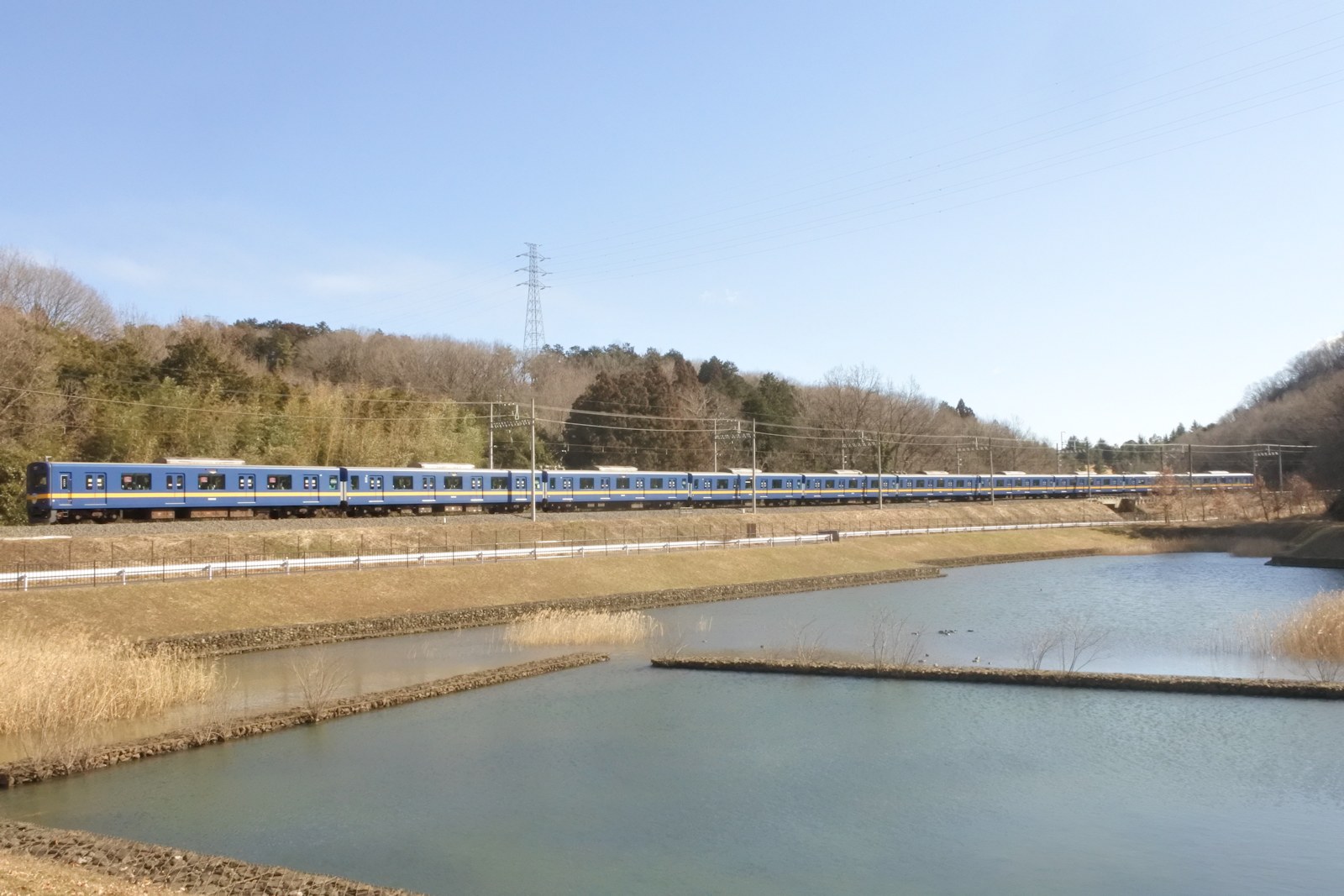
50090系51092Fの「ブルーバード」を撮る
21日、東武50090系51092Fによる池袋駅~寄居駅間の臨時列車を撮影した。今回の臨時列車は、鉄道好きアイドルの豊岡真澄さんと、豊岡さんのホリプロ所属時代のマネージャーでありながら鉄道好きタレントとしても活動する南田裕介さんをゲストに迎え、下板橋駅の留置線・高坂駅の側線・森林公園検修区といった普段営業運転では列車が走らない線路を経由して、寄居駅まで運行されたものである。51092Fは2015(平成27)年11月に東上線全線開業90周年を記念して、かつて同線で活躍した5310系「フライング東上」の塗装を再現した、青地に黄色帯のラッピングを車体に纏っている。当初は2016(平成28)年11月頃までの運行を予定していたが、2017(平成29)年1月現在もラッピングを纏い続けている。かつての「フライング東上」とは、春と秋の行楽シーズンに池袋駅~寄居駅間で運行された運行された特急列車のことである。1949(昭和24)年の運行開始当初は料金不要の急行列車として登場し、1952(昭和27)年に伊勢崎線(現在の東武スカイツリーライン区間)・日光線の特急列車として活躍した5310系が「フライング東上」用の車両として東上線へ転属し、同時に特急料金が必要な特急列車に格上げされた。「フライング東上」用の5310系は、濃紺色に黄色帯の塗装を纏い、4両編成を組んだ。このうち1両は車内スピーカーで音楽を流す「ミュージックカー」という車両だった。「ミュージックカー」は急行列車時代から連結されていた車両で、5310系の転属と同時に「ミュージックカー」の設備が同車に移設された。5310系による「フライング東上」は池袋駅~寄居駅間の運行だったが、急行列車時代は秩父鉄道秩父本線へ直通し、長瀞駅まで運行された。「フライング東上」の特急格上げ後、秩父本線への直通運転は土休日の行楽急行列車へと譲った(その秩父本線直通の行楽急行列車は、のちに料金不要の特急列車となり、「ながとろ」「みつみね」等の愛称を付けて1992(平成4)年まで運行された)。秩父本線へ直通しなくなったことから、5310系による「フライング東上」は利用者数が思わしくなく、1956(昭和31)年に料金不要の列車に格下げされたものの、車両は5310系のまま、1962(昭和37)年に伊勢崎線系統の急行列車(現在の特急「りょうもう」の前身)の増発に伴い、同線へ転属するまでの間運行された。この「フライング東上」用の5310系は団体臨時列車としても運行された。団体臨時列車として運行される時は「ブルーバード」を名乗り、沿線の学校の遠足等に利用された。今回は、「フライング東上」カラーのラッピングを纏った51092Fを使用した臨時列車ということから、5310系時代の「ブルーバード」と同様に、前面には「BLUE BIRD 青い鳥号」のヘッドマークを付けて運行された。寄居・長瀞方面への行楽列車として活躍した5310系の雰囲気を出すために、森林公園駅以北の山あいの区間を走る姿を撮ろうと臨んだ。今回の撮影場所は、東武竹沢駅~男衾駅間。沿線の緑と池と共に撮影した。池は本田技研工業(Honda)の工場の敷地内にある人工の小さな雨水調整池であるが、秩父山麓の自然と合わせると、あたかも観光地であるかのように見えてくる。51092Fは10両編成で、かつての5310系よりも長い編成であるが、10両全部を収めることができた。2005(平成17)年以降、小川町駅を境に運行系統が分断され、8000系ワンマン車の各停列車のみの運行となった小川町駅~寄居駅間に久しぶりに池袋駅からの列車が入線した。2008(平成20)年に廃止された特急に替わって新設された「TJライナー」は、夕方・夜間に(2016(平成28)年3月からは朝間時にも運行)運行される通勤客向けの着席整理券制列車で、行楽客向けだった「フライング東上」とは性格が異なる。また「TJライナー」用の50090系は、5310系とは違い、ロング・クロス両用デュアルシートで、「TJライナー」以外の料金不要の列車の運行にも就く。しかし両列車は、東上線を走る有料列車という点で共通しており、50090系が5310系の後、長いブランクを経て復活した東上線の有料列車にも使われる車両として、5310系のカラーリングを復活させるに一番ふさわしい車両だったと言えよう。実現可能な提案としては、土休日に運行される快速急行列車を、クロスシート状態にした50090系による特急料金廃止後の「フライング東上」のような列車に変更してみてはいかがだろうか。On 21st, I photographed Tobu 50090 Series being in service as a special train between Ikebukuro Station and Yorii Station on Tobu Tojo Line, featuring Masumi Toyooka, who is known as a railfan and used to be the pioneer of the railfan girls, and Yusuke Minamida from Horipro Inc., who managed Toyooka when she belonged to Horipro and known as a railfan and sometimes appeared on TV programmes.51092F set has a livery the same as 5310 Series, which used to run on Tojo Line as "Flying Tojo" limited express service in 1950s and 1960s, navy blue with yellow line since November, 2015."Flying Tojo" limited express had been in service between 1949 and 1962. At first, it ran as a express train without seating reservation on holidays in spring and autumn. In 1952, four cars of 5310 Series, a car used to be in service as limited express trains on Tobu Isesaki Line (section commonly called "Tobu SKYTREE Line" in the present) and Nikko Line between Asakusa and Tobu-nikko, moved to Tojo Line and started to operate as "Flying Tojo". At the same time, "Flying Tojo" upgraded to limited express seating reservation was required.5310 Series for "Flying Tojo" was consisted of four cars including the one called "music car", installing music audio instruments, which was moved from an old car when it operated as express."Flying Tojo" operated by 5310 Series ran Ikebukuro Station and Yorii Station, but in express train period it went through Chichibu Railway Chichibu Main Line to Nagatoro Station. Instead of "Flying Tojo", holiday express trains started to run as the going-through service to Chichibu Main Line (holiday express would change to limited express without seating reservation and continued until 1992). Because of the shortening its operating section, the number of passengers on "Flying Tojo" grew at a sluggish pace and stopped collecting additional fee in 1956. However, 5310 Series kept being in service until it moved to Isesaki Line for reserved-seat express train, become the predecessor of "Ryomo" limited express, in 1962.During 5310 Series was in service on Tojo Line, it also ran as special train for party of tourists or students.for school excursion named "Blue Bird". This time, because of a special train by the same-coloured car, 51092F set had a "Blue Bird" front sign.To photograph an image creating the atmosphere of 5310 Series running at the base of Chichibu mountains, I photographed at between Tobu-takezawa Station and Obusuma Station, an artificial pond was located in the ground of Honda's automobile factory aside of the railway. The pond functions stormwater reservoir for flood control, but photographed against the nature it looked as if it was a tourist attraction.51092F set is longer than 5310 Series, consisting of ten cars, I could shot the set from the first to the last.Since 2005, on the section between Ogawamachi and Yorii, conductorless local trains operated by 8000 Series are only in service. This time a train from Ikebukuro came there for the first time in years.Though there are some differences between "Flying Tojo" and "TJ Liner" or 5310 Series and 50090 Series such as main target, "Flying Tojo" mainly had carried passengers going on excursion but "TJ Liner" operates in the morning and evening to carry commuters, and seating layout, 5310 Series had transverse ones but 50090 Series does convertible seatings between longitudinal and forward-facing, the two services are the train additional fee is required. It can be seen that 50090 Series is the most suitable car to revive the body colour of 5310 Series.In my opinion, it may be good that 50090 Series runs as rapid express trains on Saturdays and holidays in forward-facing seating mode like "TJ Liner" after suspension of collecting additional fee.
Jan 21, 2017
コメント(0)
-

月島へ 「3月のライオン」ラッピング車両の新木場行き
新年あけましておめでとうございます。2017(平成29)年もどうぞよろしくお願いします。さて、2017(平成29)年最初の写真は、2016(平成28)年12月より「3月のライオン」のラッピングを車体に纏った西武6000系6157F。「3月のライオン」は羽海野チカ先生が描く漫画作品で、2016(平成28)年10月よりNHK総合テレビでテレビアニメが放送されている。幼いころに事故で家族を失った主人公、高校生にしてプロ将棋棋士の桐山零君が、近所に住む川本あかりさん、ひなたちゃん、モモちゃんの3姉妹と出会い、3人と触れ合っていくうちに、大切なものを取り戻していく、そして将棋を通して強くなっていく物語。6157Fの車体には零君や、あかりさん、ひなたちゃん、モモちゃんなど、「3月のライオン」の主要キャラクター達が、将棋の駒の形に切り取ったラッピングに描かれている。西武6000系は東京メトロ有楽町線・副都心線、東急東横線、横浜高速鉄道みなとみらい線へも直通運転し、運行範囲が幅広い車両であるが、「3月のライオン」は東京・月島が舞台となっているため、月島駅を通る新木場行き列車が一番似合う運用であると言いたい。僕は「3月のライオン」を見ることが最近の楽しみになっている。見ていて優しい気持ちになれるストーリーも魅力的だが、あかりさん、ひなたちゃん、モモちゃんの声を担当する茅野愛衣さん、花澤香菜さん、久野美咲さんのファンでもあり、3人の声がそれぞれのキャラクターにぴったり合っていて、それがさらに見ていて癒されてくる。ラッピングイラストの1つ 左から川本あかりさん、川本モモちゃん、川本ひなたちゃん、桐山零君(別日程での撮影) From left Akari Kawamoto, Momo Kawamoto, Hinata Kawamoto, and Rei KiriyamaHappy New Year!!My first photograph in 2017 was Seibu 6000 Series 6157F set having livery of "March comes in like a lion" comic and anime work."March comes in like a lion" is drawn by Chica Umino and animated version being broadcast on NHK from October, 2016. The hero of the comic, Rei Kiriyama, is a high-school student and a professional shogi Japanese chess player who lost his family when he was little, grows up as playing shogi and helped by his acquaintances, especially Kawamoto sisters, Akari, Hinata, and Momo.On the body of 6157F set, the illustrations of "March comes in like a lion" characters are attached, and they are in the shape of pentagonal shogi piece.Seibu 6000 Series operates a large area, not only on Seibu Ikebukuro Line, but also on Tokyo Metro Yurakucho Line, Fukutoshin Line, Tokyu Toyoko Line, and Yokohama Minatomirai Railway Line, but with the liveries, I would like to say that when it is in service as a train bound for Shin-kiba on Yurakucho Line looks good because the comic is set in Tsukishima where Yurakucho Line runs.Watching "March comes in like a lion" anime is one of my pleasure in the present because of not only a heart-warming story, but also voice of Kawamoto sisters, voiced by Ai Kayano (Akari), Kana Hanazawa (Hinata), and Misaki Kuno (Momo), which must be suitable for their characters and makes me calm while listening.西武スマイルビジョンでも放映されている「3月のライオン」のCM A commercial of "March comes in like a lion" broadcast on LCD in Seibu Railway's cars【真鍮製】 西武鉄道6000系50番代 「通常塗装」10輌セット 【エンドウ・EP150】「鉄道模型 HOゲージ 金属」価格:453600円(税込、送料別) (2017/1/2時点)6157Fがプロトタイプ 写真は黄色ラッピングだがグレー地・青帯の通常塗装 model train of 6157F set in gray colour with blue line3月のライオン 1-12巻セット価格:6278円(税込、送料無料) (2017/1/2時点)
Jan 1, 2017
コメント(0)
-

戸越銀座商店街を横切る東急池上線
戸越銀座駅を降りてすぐ、駅前から東西に広がる戸越銀座商店街の踏切を通過する東急池上線の列車を撮影。池上線の沿線には、駅前に昔ながらの商店街が広がる駅が多いが、中でも有名なのがこの戸越銀座商店街であろう。この昔ながらの商店街と、20m級車両が主流となった今でもなお18m級車両が残る池上線列車の組み合わせは、どこか哀愁を帯びて見える。近年では2007(平成19)年にデビューした7000系や2013(平成25)年に東横線から転属してきた1500系(1000系リニューアル車)が投入され、昭和30年代から活躍している7700系の本数が次第に減っているものの、池上線沿線の街には今なお昭和の面影が残る箇所があり、車両が変わりつつある今も、その光景は古めかしさを覚える。戸越銀座商店街もその1つであると言える。そして、池上線沿線の商店街といえば、西島三重子さんが歌った曲「池上線」の歌詞に♪「商店街を通り抜け 踏切渡った時だわね」という一節がある。商店街の中にある池上線の踏切を描写したこの歌詞が、この戸越銀座商店街にもよく似合うものだと感じる。かつては荏原中延駅や長原駅の付近にも商店街を横切る踏切があったと聞くが、長原駅は1973(昭和48)年、荏原中延駅は1989(平成元)年に地下化されたため、今では見ることができなくなった。Just soon after going out of the gate at Togoshi-ginza Station on Tokyu Ikegami Line, one of famous shopping area in Tokyo, Togoshi-ginza shopping district spread eastward and westward. I photographed a Tokyu Ikegami Line crossing the street beyond a gate.Along Ikegami Line, some shopping districts spread from stations, but the most famous one must be Togoshi-ginza. The combination of shopping district and Ikegami Line train, operated by 18-metre/59.05-foot long carriages, though most of carriages had 20-metre/65.62-foot long body in the present.Recently, especially from 2007, production of 7000 Series and moving of 1500 Series (refurbished 1000 Series) from Toyoko Line had been replaced 7700 Series, which had been in service since 1962, but the scenery still had something nostalgic reminding people of their old time. Togoshi-ginza shopping district could be called one of them.Speaking of a shopping street along Ikegami Line, a lyric of a song sung by Mieko Nishijima "Ikegami Line" portrayed a shopping dictrict and a railway crossing, which recalled a scene like this photograph.In the old time, Ebara-nakanobu Station and Nagahara Station also used to have a crossing in front of or nearby the gate, but the two were relocated to underground.
Dec 29, 2016
コメント(0)
-

N700系新幹線 東京駅まであと15km
JR東海東海道新幹線新横浜駅~品川駅間を走るN700系新幹線を撮影。実際の走行距離(実キロ)でも、運賃計算で使う営業キロでも1000km以上離れた福岡県・博多駅から約5時間の道のりを走り抜け、多摩川橋梁を渡り東京都内へとやって来た列車の姿を、再開発が著しい武蔵小杉の街を背景にオーバークロスする道路上と多摩川河川敷から撮影。列車が200km/hを超えるスピードで走るのも、東海道新幹線では新横浜駅まで。新横浜駅~東京駅間は、騒音公害への配慮から110km/hという新幹線としてはゆったりとしたスピードで、東京駅までの残り約15km(道路に取り付けられた金網に東京駅からの距離が「15K137M」という看板が掲げられていた)に向けてラストスパートをかける姿を捕えた。1枚目の道路上から撮ったものは金網越しになったが、金網がレンズに入り込まず、列車と背景の高層マンションを収めることができた。2枚目の河川敷から撮ったものは16両全部入らなかったことが残念だが、高層マンション群と多摩川を入れることで、神奈川県から東京都へとやってきた列車を表現した。I photographed N700 Series Shinkansen running between Shin-yokohama Station and Shinagawa Station on Tokaido Shinkansen.From Hakata Station, the train had run over 1000km long and it took about 5 hours to come to Tokyo Metropolitan area. These two were the train running last 15 kilometres/9.32 miles of the way to Tokyo (a board on the wire fence said that there was 15km and 137m away from Tokyo Station) like a long-distance runner putting out a last spurt at a speed of about 110km/68.35mi per hour, which was low as a Shinkansen to reduce the wind noise for residential, from a road bridge over the railway and Tamagawa riverbank and against the background of high-rise apartments in Musashi-kosugi area, Kawasaki City, Kanagawa Prefecture.The first one was taken beyond a wire fence, but the wire wasn't imaged.Though full-length carriage set (16 carriages) couldn't be imaged, the second one was imaged the train crossing Tamagawa river, which was bordered between Kanagawa Prefecture and Tokyo Metropolitan area.
Dec 29, 2016
コメント(0)
-
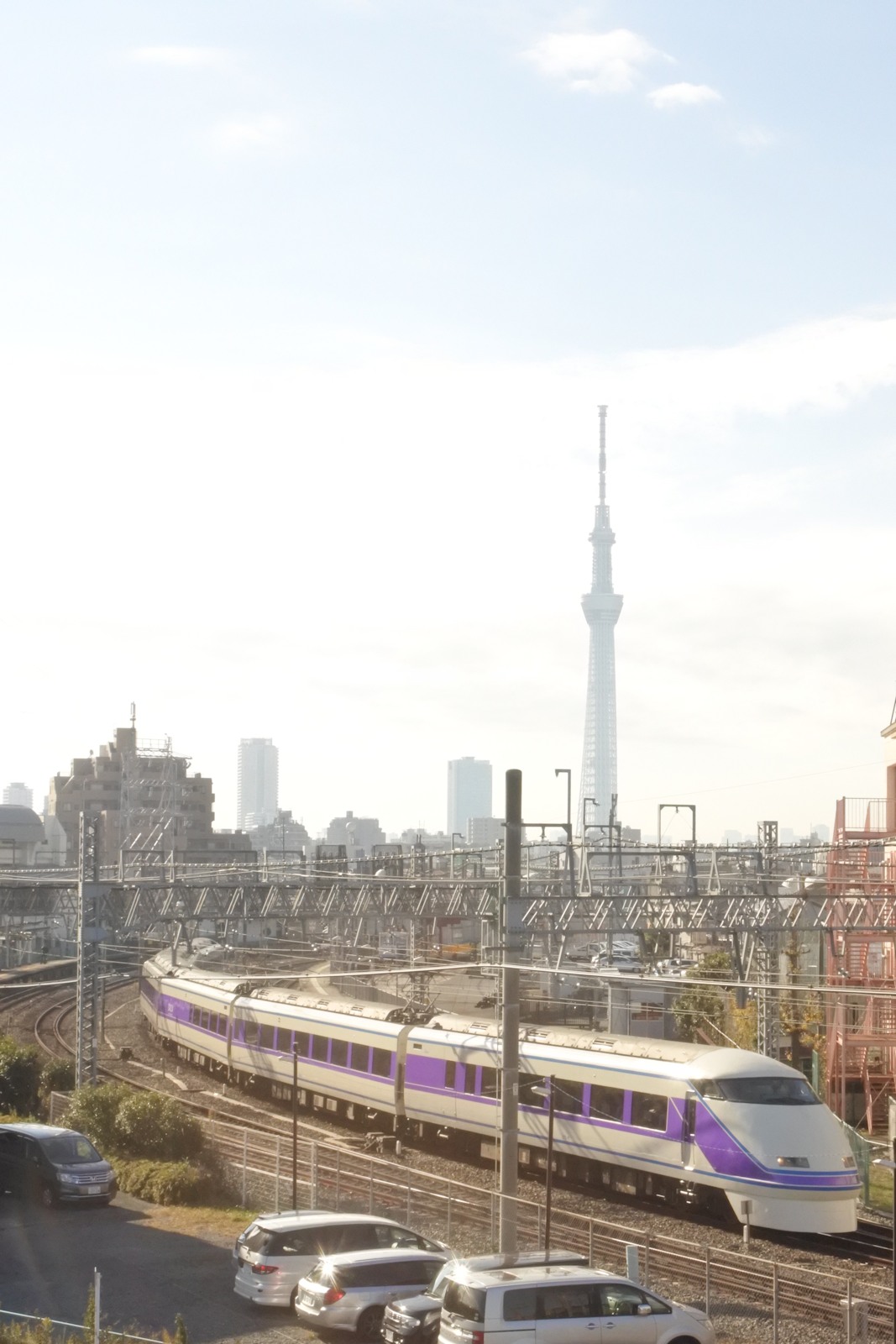
東武100系「スペーシア」と東京スカイツリー
18日、10年目の年間テーマである「一番その車両らしい姿」の写真を撮りに行った。鐘ヶ淵駅を見下ろす荒川土手は、東武スカイツリーラインの列車と東京スカイツリーとのツーショットを撮るおすすめスポットの1つ。晴れた日にはこの写真のように、東京スカイツリーを最も高い634m地点までしっかりと写真に収めることができる。今回は東武スカイツリーライン鐘ヶ淵駅付近の荒川土手から、東京スカイツリーを背景に東武100系「スペーシア」を撮影。東京の新たな観光スポットとして、そして東武鉄道の新たなシンボルである東京スカイツリーと、そのイルミネーションの色に合わせた「雅」塗装(紫色)の編成(105F)の組み合わせ。東武100系といえば、かつては終着駅に近い日光・鬼怒川温泉の風景が似合う印象の車両であったが、デビュー当時のサニーコーラルオレンジとパープルルビーレッドから「粋」塗装(青色)やこの「雅」塗装へと塗り替えられた編成は、やはり東京スカイツリーとの組み合わせがよく似合う。100系「スペーシア」で運行される「けごん」「きぬ」は浅草・東京スカイツリーと日光・鬼怒川温泉という日本国内のみならず海外からの人気も高い2つの観光地を結ぶ列車へと変貌を遂げたことを改めて実感した。On 18th, I went photographing Tobu SkyTree Line train under the theme of "suitable operation and background for each carriage". This time I represent a photograph of "Miyabi" purple-coloured Tobu 100 Series "SPACIA" and Tokyo SkyTree, one of the most famous new sightseeing spot in Tokyo and the new symbol of Tobu Railway. The photograph was shot from Arakawa river bank near Kanegafuchi Station where Tokyo SkyTree was seen from the bottom to the top in a sunny day.Tobu 100 Series "SPACIA" used to be against the background of mountains around Nikko or Kinugawa hot spring area, but after its body colour changed to "Iki" blue or "Miyabi" purple inspired by illumination of Tokyo SkyTree, it looks good with Tokyo SkyTree. While shooting, I also see "Kegon" and "Kinu" limited express operated by 100 Series "SPACIA" changed the train not only to go toward Nikko or Kinugawa hot spring area, but the two also function the ones connecting two famous tourist attractions in the present.
Dec 18, 2016
コメント(0)
-
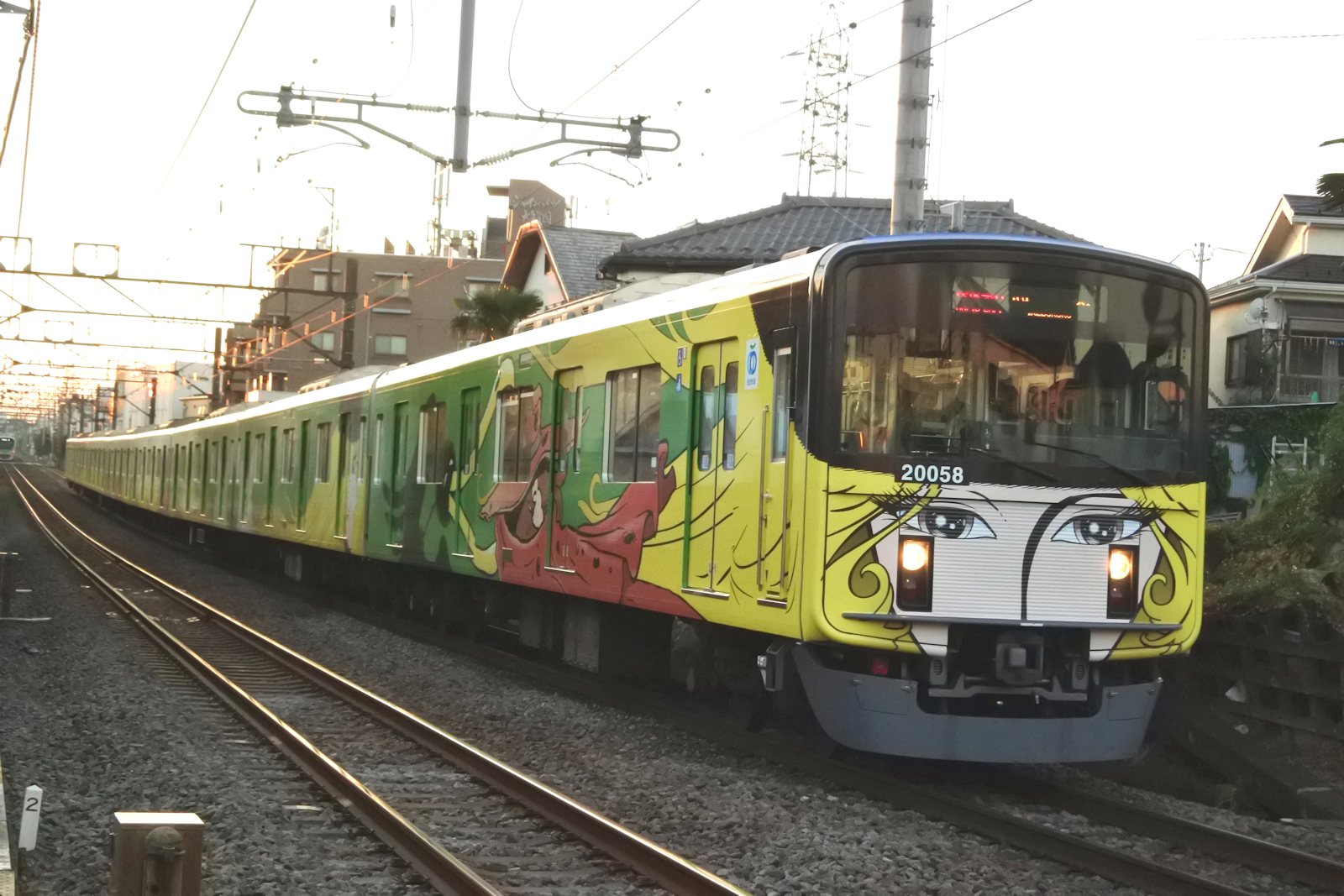
新しい「銀河鉄道999」デザイン電車を撮る
メーテルが大きく描かれた池袋・西武秩父方先頭車両 20058号車車掌さんが大きく描かれた飯能方先頭車両 20158号車(後追い)5日、去る10月8日より運行を開始した西武池袋線・西武秩父線の2代目「銀河鉄道999」デザイン電車(ラッピング車両)を撮影した。新しいデザイン電車に抜擢されたのは、西武20000系の20158F。初代の3000系3011Fと同様に、前面は同作のキャラクター、メーテル(20058号車 池袋・西武秩父方)と車掌さん(20158号車 飯能方)が大きく描かれ、側面にも2人に加えて主人公の星野鉄郎が描かれているが、初代には描かれなかったキャラクターも追加されているほか、側面の地色も初代は宇宙を思わせるような濃い青色であったのに対して、2代目は緑色となっている。この緑色は、練馬区が展開する「YoriDoriMidori(よりどりみどり)練馬」プロジェクトにより開発された練馬区オリジナル色の「NERIMA GREEN(ねりまグリーン)」と呼ばれるものの1つ「Nerima Green Town」である。「銀河鉄道999」の作者であり、デザイン電車の復活を強く望んでいた練馬区大泉学園在住の松本零士先生と、沿線地域の活性化と共生を目指す西武鉄道、アニメによる地域活性化を目指す練馬区、3者の思いが合致し、さらに沿線地域の協力の下で、今回の復活が実現した。この日は横瀬車両基地で開催された「西武トレインフェスティバル2016 in 横瀬」に合わせて池袋駅~横瀬駅間で運行された臨時列車(往路・事前応募制の団体専用列車 復路・快速急行列車)と同イベントでの撮影会に2代目「銀河鉄道999」デザイン電車となった20158Fが起用された。今回僕は横瀬へは行かなかったが、2代目「銀河鉄道999」デザイン電車は撮影したかったことから、復路の快速急行列車として運行されている姿を捕った。On 5th, I photographed Seibu 20000 Series 20158F set, starting to run as a special carriage having "Galaxy Express 999" livery from October 8th, following 3000 Series 3011F set retired in 2014.20158F set also has big illustrations of "Galaxy Express 999" characters such as Tetsuro Hoshino (on its side), Maetel (on its front of 20058 and side), and Conductor (on its front of 20158 and side) are printed, but some new characters are on its side, too. In addition, the back colour of its side are different from the first; first was dark blue but second is green, which is one of Nerima-ku's original colour called "Nerima Green Town" created as part of project "YoriDoriMidori Nerima".The three wishes of Galaxy Express 999's creator , Leiji Matsumoto, Seibu Railway, and Nerima-ku for reappearance and regional promotion using anime works.On that day, "Seibu Train Festival" was held at Yokoze Railyard. 20158F set operated as a charter train for the event and a special rapid express train and photographing event of it was held.This time I didn't go there but wanted to photograph 20158F. The two photographs were shot when it served as a rapid express train.参考:初代「銀河鉄道999」デザイン電車 3000系3011F(2014(平成26)年12月に引退) First generation Galaxy Express 999 livery carriage 3000 Series 3011F set
Nov 5, 2016
コメント(0)
-

東武1800系&350系の臨時列車を撮る
3日、秋の行楽シーズンに合わせて運行された東武日光線の2本の臨時列車、1800系の快速列車と350系の特急「きりふり」を撮りに行った。今回の撮影場所は初めて行くことになった東武動物公園駅~杉戸高野台駅間。写真はあえて逆光にして、朝日を浴びながら田園風景を走る列車の雰囲気を出した。1800系とその改造車である300系・350系は、古いもので車齢が40年を超えており(351F・353F(元1816F・1813Fのクハ1810形・モハ1820形・モハ1830形・クハ1860形)が1969(昭和44)年新造、301F・302F(元1818F・1817F)が1973(昭和48)年(300-4形・300-5形(元サハ1840形・モハ1850形)は1979(昭和54)年)新造、352F(元1816F・1813Fのサハ1840形・モハ1850形)が1979(昭和54)年新造、1819Fが1987(昭和62)年新造)である。これらはわずかに定期列車(朝・夕方の「しもつけ」1往復と平日夜の「きりふり」2本)での運行が残るものの臨時列車での活躍が目立っていることから、老朽化と運用の減少による引退が近づいていると、かねてから言われてきた。先日「Revaty」という愛称が決定した500系24両(3両編成×8本)が2017(平成29)年3月にデビューすることから、在籍両数が同じ24両(6両編成×2本と4両編成×3本)である300系・350系が500系に置き換えられる可能性が高くなってきた。300系・350系は以前にも何度か撮影したことがあったものの、今のうちにもう一度撮影しておきたかった。On 3rd, I photographed Tobu 1800 Series and 350 Series between Tobu-dobutsu-koen (Tobu Zoo) Station and Sugito-takanodai Station.Taking against the sun, I represented images of the carriage under the sun in the morning.The oldest carriages of 1800 Series, and two carriages converted from 1800 Series, 300 Series, and 350 Series, had been built over 40 years before; 351F set and 353F set (former four carriages of 1816F and 1813F) had been in 1969, 301F set and 302F set (former 1818F and 1817F) in 1973 (two middle carriages, type Saha 300-4 and Moha 300-5 (former type Saha 1840 and Moha 1850), in 1979), 352F set (former two middle carriages, Saha 1840 and Moha 1850, of 1816F and 1813F) in 1979, and 1819F set in 1987. These carriages mainly serve as on-season or chartered train, though doing as some regular trains, "Shimotsuke" limited express in the morning and evening and "Kirifuri" limited express on the weekday evening. decrease of made up a rumour that these would be retired among railfans. It might be said that 24 newly-built carriage (eight 3-carriage sets) for limited express train, 500 Series "Revaty", would replace 300 Series and 350 Series, which exist the same number totally.Though I have photographed 300 Series and 350 Series several times, I did again before retirement.
Nov 3, 2016
コメント(0)
-

3年ぶりのトウ545編成撮影
「ニューなのはな」撮影後は山手線へ移動し、E231系トウ545編成を撮影。トウ545編成といえば、2013(平成25)年に、103系のデビューによって山手線のラインカラーが黄緑色(黄緑6号)と定められてから50年を迎えたことを記念して運行された「みどりの山手線」ラッピング車両に抜擢された編成である。そのトウ545編成が、2016(平成28)年9月16日~9月30日までの間、「μ's Final LoveLive!トレイン」として運行され、3年ぶりに注目を集めた。「μ's Final LoveLive!トレイン」は2015(平成27)年のNHK紅白歌合戦に出場したことで一躍その名が日本中に知られるようになった、人気アニメ「ラブライブ!」の登場キャラクターの声と主題歌・挿入歌を担当する女性声優9人組グループ、μ'sの2016(平成28)年3月に開催されたライブ映像を収めたBlu-rayディスクの発売を記念して運行されたラッピング・車内広告統一車両。車体のドア(2番ドア・3番ドア)横には「ラブライブ!」のキャラクター達が2~10号車の車両ごとに1人ずつ大きく描かれたラッピングが、1号車と11号車には「μ's Final LoveLive! μ'sic forever」のロゴが描かれたラッピングが貼られていた。2号車(モハE230-635)のラッピング livery on carriage number 2 (Moha E230)1号車(クハE230-545)のラッピング livery on carriage number 1 (Kuha E230)車内には、2~10号車の中吊りには各キャラクターのイラストとキャラクターの集合イラストが、荷棚上と1・11号車の中吊りには各キャラクターとその担当声優の写真が、ドア横の広告枠にはこれまでμ'sが歌ってきた「ラブライブ!」の主題歌・挿入歌の歌詞がそれぞれ掲げられていた。この日は日曜日であったこともあり、「ラブライバー」と呼ばれる同作品のファンが多く乗車している様子が見受けられ、彼らを含めた老若男女ほとんどの乗客がカメラやスマートフォンを車内広告に向け、お気に入りのキャラクターの中吊りを前に自撮りしていた。品川駅を発車するトウ545編成 Tou 545 set departing from Shinagawa StationAfter photographing "New Nanohana", I also went photographing E231 Series Tou 545 set on Yamanote Line, which had had a full-length and full-height light-green-coloured body livery on its side to mark the 50th anniversary of establishment of line colour of Yamanote Line in 2013 conjuring up image of an old carriage in Japan National Railway Period, 103 Series.Tou 545 set drew renewed attention from not only railfans but also people called "Love Liver", who loves "Love Live!" anime or smartphone game because it had liveries on its body and advertisements in its interior of "μ's Final LoveLive!", Blu-ray disc video of a concert of μ's, 9-membered voice actress group who sings songs and each member voices each main character on the anime or game, being held on March, 2016.On the side of the two middle doors, large-size illustration of each character (carriage number 2 - 10) and "μ's Final LoveLive!" logo (carriage number 1, 11).In the carriage interior, all of advertisements were illustration of characters, photographs of μ's members while singing, and lyrics of theme or inserted songs in the anime or games.On that day, because of a Sunday, I saw that many passengers shot pictures of advertisements or body liveries or selfie with them by camera or smartphone.HO-053 JR E231-500系通勤電車(山手線)基本セット(4両)(再販)[TOMIX]《取り寄せ※暫定》価格:39470円(税込、送料別) (2016/10/2時点)
Sep 25, 2016
コメント(0)
-
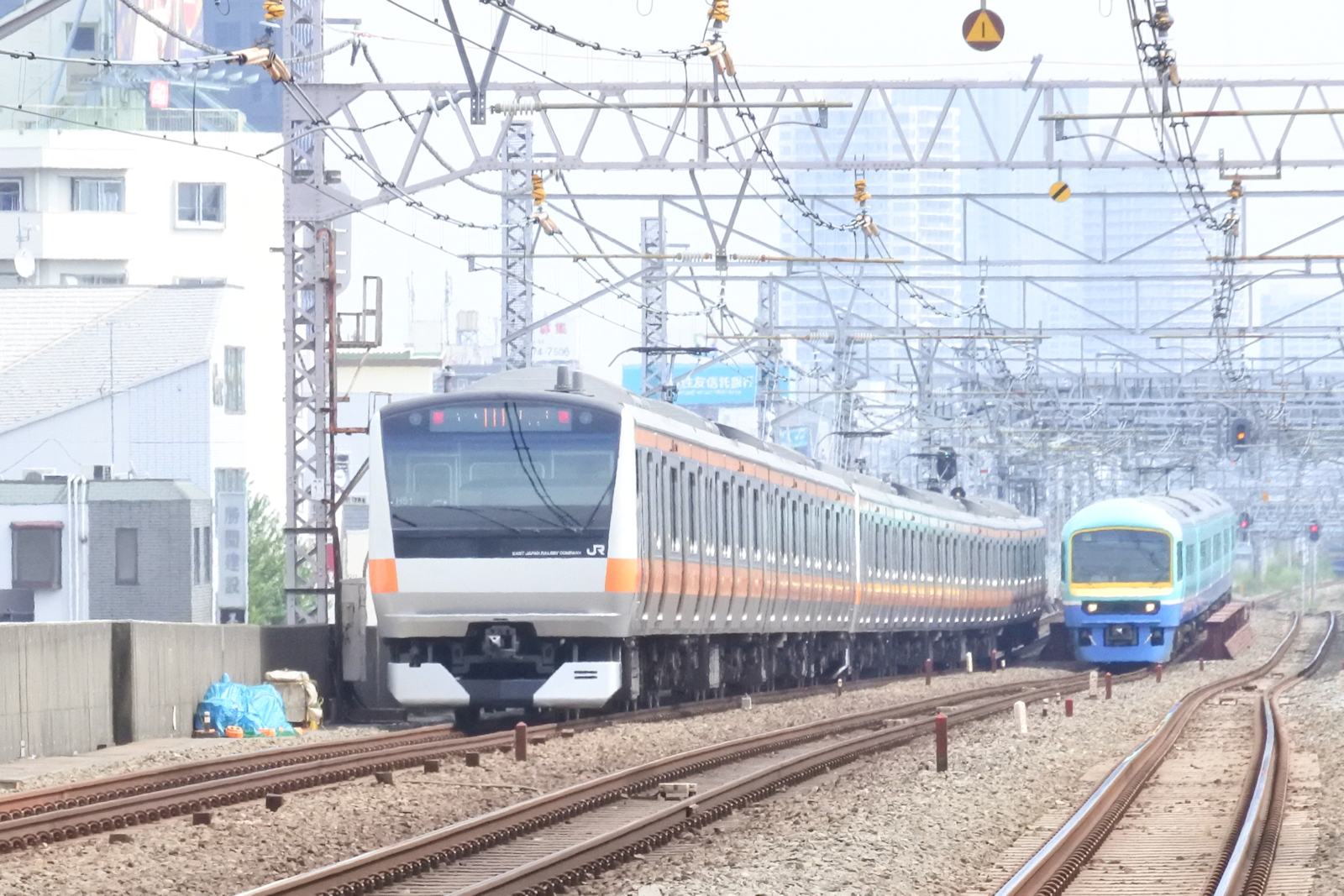
さようなら「ニューなのはな」
2016(平成28)年8月28日をもって引退した、幕張車両センター(千マリ)所属の485系改造車「ニューなのはな」の長野総合車両センターへの廃車回送を撮影。「ニューなのはな」は「宴」「華」に続く485系を改造したお座敷電車として1998(平成10)年に登場した。車体のカラーリングは房総半島を取り囲む海をイメージした濃淡2色の水色を基調に、名前の由来となった千葉県の花、ナノハナをイメージした黄色が前面窓下に入る。先に登場した「宴」「華」がお座敷専用だったのに対して、「ニューなのはな」はお座敷にも座席(クロスシート)にもなる車両として登場した。デビュー以来、お座敷をセットした状態では団体臨時列車、座席をセットした状態では千葉県内を発着する臨時列車として活躍してきた。しかし近年では「あやめ」の廃止や「さざなみ」の運行区間短縮の影響を受けて、東京駅から房総半島各地へと走る特急列車として活躍しているE257系の編成本数に余裕が出始め、臨時列車に回せる編成が増えたものとみられる。このことを受けて、「ニューなのはな」は「宴」「華」よりも先に引退することとなってしまった。当初は8月27日と28日に運行された団体臨時列車が乗客がいる状態でのラストランとみられていたが、9月25日の廃車回送を急遽ツアー旅行として売り出すこととなり、同日幕張車両センター~長野総合車両センター間(ツアー旅行としての客扱いは錦糸町駅~長野駅間)で運行された。8月の団体臨時列車を撮影することができなかった僕にとっては、今回の廃車回送のダイヤ公開は願ってもいなかった「ニューなのはな」の最後の勇姿を見られるチャンスだった。僕は中央・総武緩行線高円寺駅でカメラを構え、中央東線を走る「ニューなのはな」を待った。E233系の東京行き快速列車とすれ違う。 Meeting E233 Series on rapid service train.僕よりも前にいた撮り鉄さんの腕が写り込んでしまったが、そこはそれだけ撮影者がいたという証拠だと思っている。 Though a photographer's arm interrupted, it became an evidence that many photographers stood by.撮影後、ホームにいた別の撮り鉄さん達と同時に、「ニューなのはな」に向かって「ありがとう。」と手を振った。実は廃車回送される車両を撮影したことは今回が初めてである。今回の「ニューなのはな」は団体臨時列車も兼ねていたが、大義名分は廃車回送である。On 25th, I photographed 485 Series "New Nanohana" during its last run to Nagano railyard for scrap."New Nanohana" had been converted from 485 Series following "Utage" and "Hana". Its body colour could conjure up image of the sea surrounding Boso Peninsula in Chiba Prefecture, Pacific Ocean and Tokyo Bay, and under its front glass a yellow line coming from the image of rape flower, the symbol flower of Chiba Prefecture and the carriage was named after ("Nanohana" means rape flower in Japanese), was laid out. Different from "Utage" and "Hana", whose interior have high-decked tatami mat floor, "New Nanohana" had a convertible interior; tatami mat from/to transverse seatings.Since 1998, "New Nanohana" had served as special trains on high season or for tourists mainly in or from/to Chiba Prefecture. However, in recent years, suspension of "Ayame " limited express' operation and shortening of distance of "Sazanami" limited express made more sets of E257 Series, carriage for limited express trains between Tokyo Station and Chiba Prefecture, stay at railyard, which may make more sets for special operation prepared and trigger the ealier retirement than "Utage" and "Hana".At first, the last operation carrying passengers was on August 28th, but the out-of-service operation became the tourist train. it carried tourists from Kinshicho Station to Nagano Station.Because I couldn't go photographing it on August, this additional tour was last chance for me to shoot "New Nanohana". I waited for it running on Chuo East Line at Koenji Station on Chuo Sobu Line local service, which runs in parallel with Chuo East Line.Soon after shooting, photographers including me shouted "Thank you and Good Bye!" to the carriage.It was also first time for me to shoot at a train on the way for scrap.
Sep 25, 2016
コメント(0)
-
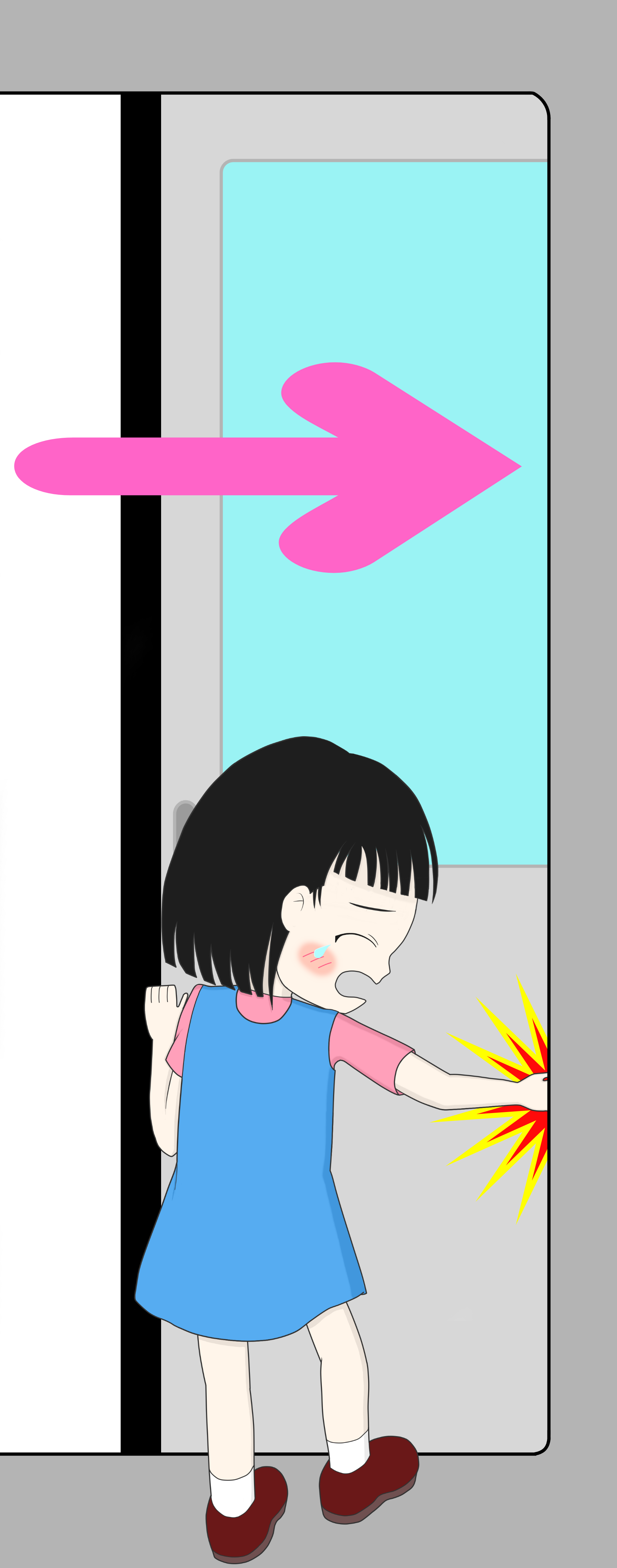
"地下鉄のお嬢ちゃん"の友達
関西圏の民鉄には、大阪市高速電気軌道(Osaka Metro)の“地下鉄のお嬢ちゃん”以外にも、もう2人側扉戸尻(戸袋寄り)に貼り付けられた引き込まれ注意ステッカーに描かれたお嬢ちゃんがいる。“泉北高速鉄道・南海電車のお嬢ちゃん ”と“大阪モノレールのお嬢ちゃん ”である。“泉北高速鉄道・南海電車のお嬢ちゃん ”と“大阪モノレールのお嬢ちゃん ”も僕のタッチで描いた。泉北高速鉄道・南海電気鉄道のドアステッカーのお嬢ちゃん | 花見 友紀 [pixiv] 泉北高速鉄道・南海電車のお嬢ちゃん Semboku Rapid Railway and Nankai Electric Railway Girl関西民鉄のドア戸尻に貼られているステッカーのキャラクターとしてはデビューが最も早いのが"泉北高速鉄道・南海電車のお嬢ちゃん"。髪型はおかっぱでピンク色のTシャツと青色のワンピースを着ている。2008(平成20)年10月、大阪府都市開発時代の泉北高速鉄道の車両に登場した。後に泉北高速鉄道の列車が直通運転を実施している南海電気鉄道の車両にも貼り付けられている。デビューは最も早いが、後に登場した大阪モノレールや大阪市交通局のお嬢ちゃんと比べると、ドアとの対比での身長と等身が一番低く、幼い印象を受ける。大阪モノレールのドアステッカーのお嬢ちゃん | 花見 友紀 [pixiv] 大阪モノレールのお嬢ちゃん Osaka Monorail Girl泉北高速鉄道・南海電車に続いて登場したのが"大阪モノレールのお嬢ちゃん"。2010(平成22)年2月に登場した。髪型はポニーテールで、ピンク色のキャミソールワンピースと群青色のジーンズを着ている。安全報告書のイラストではポニーテールの髪をまとめているものがボール付きのヘアバンドなのかシュシュなのか判らなかったが、僕はシュシュっぽく描いてみた。ドアとの対比での身長と等身が先に登場した泉北高速鉄道のお嬢ちゃんや後に登場する地下鉄のお嬢ちゃんよりも高めで、3人の中では一番歳上のように見える。地下鉄のお嬢ちゃんにとっては、デビュー時期でも見た目の年齢でも、お姉さんのような存在なのかもしれない。この2人のお嬢ちゃんも、地下鉄のお嬢ちゃんと同様に可愛がっていきたい。大阪市交通局の"地下鉄のお嬢ちゃん"以外にも、関西地方の民鉄にはもう2人ドア戸尻に貼られているステッカーに描かれた女の子がいる。泉北高速鉄道・南海電車と大阪モノレールのお嬢ちゃんである。僕は地下鉄のお嬢ちゃんを描いたことは2度あるが、泉北高速鉄道・南海電車と大阪モノレールのお嬢ちゃんは描いたことがなかったため、泉北高速鉄道、大阪高速鉄道両社の安全報告書に載せられていたイラストを参考にしながら、地下鉄のお嬢ちゃんと同様に花見友紀のタッチでリファインしてみた。As well as "Osaka Subway Girl", two more girls are in the mind-the-doors signs showing on the doors of railway carriages in the Osaka area, Semboku Rapid Railway, Nankai Electric Railway, and Osaka Monorail. I tried to fan-art both of the two, watching the annual reports of those companies, but little refined with my touch. Though I have drawn "Osaka Subway Girl" twice, it was my first time drawing them.Among the characters in the signs on the tail of the door panel, Semboku Rapid Railway and Nankai Electric Railway Girl, who appeared in October, 2008, was the first one. She wears pink-coloured T-shirts and light-blue-coloured one-piece, and her hair in a bob. A few months later, it also spread to the carriages of Nankai Electric Railway, on which some Semboku Rapid Railway trains go through.She looks the youngest among the three girls because of her body shape and height compared with the door.Following Semboku Rapid Railway, Osaka Monorail Girl appeared in February, 2010. She wears a pink-coloured camisole one-piece and navy-blue-coloured jeans, and her hair is pulled back in a ponytail.I couldn't distinguish what her hair ties, maybe band with balls or scrunchy. I did a scrunchy.She looks senior to Semboku Rapid Railway Girl and Osaka Subway Girl. Osaka Subway Girl can be like a younger sister because of her looks and her date of appearance.I also want to adore the two girls like "Osaka Subway Girl".泉北高速鉄道 安全報告書 2016年版大阪高速鉄道 安全報告書 2015年版
Sep 19, 2016
コメント(0)
-

大阪市地下鉄のドアステッカーの女の子の呼び名
大阪市地下鉄・ニュートラムのドアステッカーに描かれている女の子。手を戸袋に引き込まれ、涙を流している姿が痛々しい反面、見ていて慰めてあげたくなるようなかわいらしいキャラクターである(と思っているのは僕だけであろうか…)。2011(平成23)年より彼女が描かれたステッカーが大阪市地下鉄・ニュートラムのドアに貼られているが、彼女は大阪市交通局の公式マスコットキャラクターではないため、登場から5年が経った今年2016(平成28)年になっても名前がない。そのため僕は、彼女をどう呼ぼうか考えていた。鉄道事業者のマスコットキャラクターとしては、JR東日本のSuicaのペンギンは公式のマスコットキャラクターでありながら名前がなく「Suicaのペンギン」もしくは単に「ペンギン」と呼ばれている。これを参考にして、名前がないなりの呼び方を考えてみた。考えた結果、僕はこれから、彼女のことを親しみを込めて"地下鉄のお嬢ちゃん"と呼ぶこととした。同様に他の鉄道事業者のドアステッカーに描かれている女の子のキャラクターに対しても"○○(鉄道事業者名もしくは路線愛称)のお嬢ちゃん"と呼んで、かわいがっていきたい。The girl in the mind-the-doors sign on the doors of Osaka Municipal Subway carriages, weeping with injury on her hand, arouse passengers' feeling of pity to give comfort to her (at the very least, I feel).The sign has been showing on the doors since 2011, but she still is unnamed because she isn't official mascot. I have thought about how I call her for a long time.Among the mascots of railway companies, the penguin on JR East's Suica smartcard isn't also unnamed, which is called "Suica's Penguin" or just "Penguin". By the same way, I want to call her with a nickname respecting her unnamedness.I decided that I call her "Osaka Subway Girl" in affectionate. I also want to call the other girls in the signs "(name of the railway company or line) Girl" as well.
Sep 17, 2016
コメント(0)
-

大阪市地下鉄のドアステッカーの女の子 再び
大阪市営地下鉄のドアステッカーの女の子 2 | 花見 友紀 [pixiv] 大阪市地下鉄のドアステッカーの女の子のデビュー5周年を記念して、彼女を再び描いた。原作と同様の手を戸袋に引き込まれないように警告するメッセージを大切にしながらも、前回よりも彼女をかわいらしく描くことを意識した。車両は今回も原作と同様に御堂筋線の21系をイメージしているが、実車がリニューアルされたことを反映させて、リニューアル車を想像させる黄緑色の化粧板のドアに変更した。女の子がデビューしたのは2011(平成23)年9月のこと(同年9月7日付けの大阪市交通局のプレスリリースで車両ドアへのステッカー貼り付けが発表された。)。大阪市交通局に寄せられた「子供が戸袋に手を挟まれないよう、扉に注意喚起のシールを貼ってはどうか。」という利用者の声に応える形でステッカーが制作され、大阪市地下鉄とニュートラムの車両のドアの戸袋寄り(戸尻)、小さい子供でも見やすいガラスの下部R付近の高さに貼り付けられている。関西地方の私鉄では、ドアの窓ガラスに加えて、戸尻部分にも近年ステッカーが貼られる車両が増えている。大阪市交通局のものに似た、女の子のキャラクターがデザインされたステッカーは、関西の私鉄では泉北高速鉄道・南海電車、大阪モノレールで先行して導入されている。この類のステッカーは大阪を訪れた観光客からも「かわいい」「解りやすい」といった声がブログに、ステッカーの写真と共に載せられている事例が散見される。僕の個人的な意見としても、単純で無個性な指差しの絵柄(特に関西地方の民鉄・地下鉄では、大阪市地下鉄・ニュートラムのドアガラスに貼られているものも含めて、人差し指が戸袋方向を指す赤色のディフォルメされた手の絵柄のものが多い)のものよりも伝わりやすいうえに、かわいらしいデザインからメインターゲットである子供達はもちろんのこと、大阪市地下鉄・ニュートラムを利用している様々な人々に親しみやすいものであると考えている。僕としては、大阪市交通局のものに似たデザインのステッカーがより多くの鉄道事業者に広がること、別の言い方をすると彼女の"友達"が増えることを願っている。彼女自身は痛い思いをしながらも、地下鉄・ニュートラムに乗っている子供達が引き込まれ事故に遭わないように、いつも見守っている。僕は大阪市地下鉄・ニュートラムには1度も乗ったことがないため、ぜひとも乗って、本物の彼女に会ってみたい。ステッカーの文面にGoogle・AdobeのNoto Sans CJKを使用しています。I fan-art the girl in the mind-the-doors sign on Osaka Municipal Subway carriages to mark the fifth anniversary of its appearance on September 7th, 2011.Respecting the message to prevent the injury at door pockets, I tried to represent it more cartoonishly. The train interior resembles that of 21 Series on Midosuji Line (like the original), but I chose that of refurbished carriages with green-coloured doors. The sign is put at the height of little children's eyes to reflect passengers' voices.Around Osaka, Kyoto, and Kobe, the mind-the-doors signs showing at the door tail are increasing. The similar-looking signs show on Semboku Rapid Railway, Nankai Electric Railway, and Osaka Monorail carriages.Some people travelling around Osaka shoot a picture of the sign and show it on their blog, Twitter, or SNS. They also appreciated it as cute and understandable.The signs look more understandable and adorable than those featuring the pictogram of hands whose fingers point toward the door pockets. Those with red-coloured hands are popular among many carriages around Osaka.I wish these types of signs were shown in more carriages. In other words, more of her friends appear all over Japan.She always watches the children in the Subway and Newtram train to warn them not to injure their hands.Because I haven't travelled on Osaka Municipal Subway and Newtram, I want to do with them and to see her in the original work.Noto Sans CJK produced by Google and Adobe is used as the message in the picture.
Sep 7, 2016
コメント(0)
-
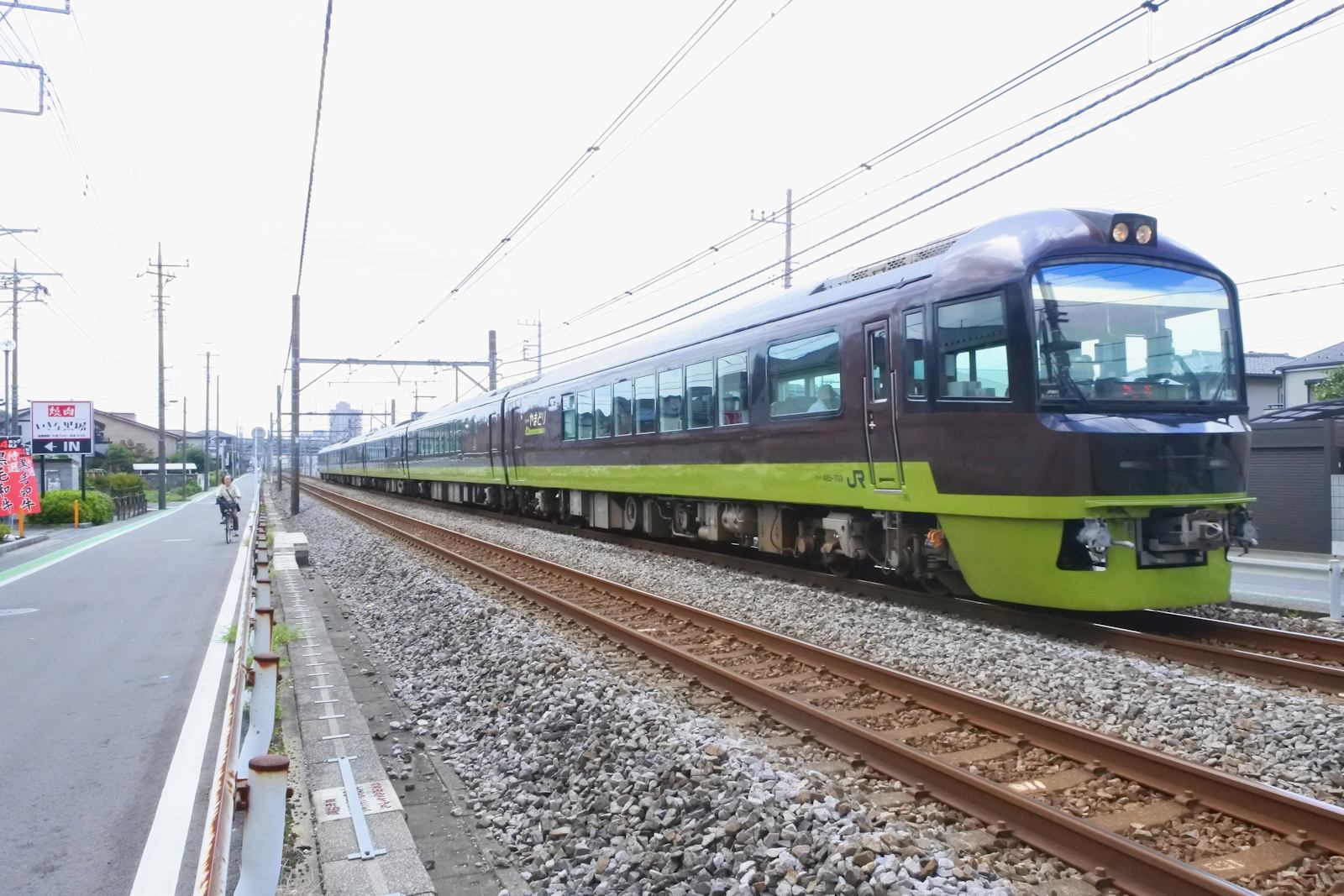
高崎線で「リゾートやまどり」を撮る
3日、2012(平成24)年2月11日以来2回目となる「リゾートやまどり」の撮影に挑戦した。「リゾートやまどり」は2011(平成23)年のJR東日本と群馬県の共同観光キャンペーン「群馬デスティネーションキャンペーン」の開催に合わせて登場した485系の改造車。6両1編成を組み、2001(平成13)年よりお座敷電車「せせらぎ」として運行されてきた車両4両1編成に、1998(平成10)年より同じくお座敷電車「やまなみ」として運行されてきた車両4両のうち中間車2両を組み込み、座席車に再改造した(ちなみに「やまなみ」の先頭車両2両は盛岡車両センターに転属し、「ジパング」の先頭車両に再改造された)。キャンペーン期間中は新宿駅~長野原草津口駅間の特急「リゾート草津」や吾妻線の快速列車として、キャンペーン終了後は、土休日を中心に大宮駅~長野原草津口駅(万座・鹿沢口駅まで運行されていた時期もあった)の快速列車など、群馬県内を始発・終着とする臨時列車として活躍している。僕は熊谷駅付近で「リゾートやまどり」を撮影しようと予定を立てていた。しかしこの日は、あいにく朝7:44にその高崎線熊谷駅~行田駅間で発生した人身事故が発生し、高崎線の列車が上野東京ライン東京駅~高崎駅間で運転見合わせとなってしまった。僕は乗った高崎線の列車が行田駅の手前で運行が打ち切られることも想定し、急遽撮影場所を宮原駅~上尾駅間に変更した。当然「リゾートやまどり」も影響を受け、本来ならば8:52に大宮駅を発車するダイヤが組まれていたが、高崎車両センターからの送り込みが遅れた。「リゾートやまどり」が臨時列車であることから、運休になってしまう可能性もあったものの、粘り強く列車が来ることを待った。結果として、高崎線列車の運休は約90分間続き、この日の「リゾートやまどり」は本来のダイヤから約120分遅れで運行された。On 3rd, I photographed "Resort Yamadori". It was second time for me."Resort Yamadori" debuted in 2011 a campaign by JR East and Gunma Prefecture to draw tourists to Gunma. The set is consisted of 6 carriages and refurbished from two sets used to be named "Seseragi" and "Yamanami" having Japanese-style interior with tatami mat floor to the normal seatings (two front carriages of "Yamanami" moved to Morioka railyard and were refurbished to "Zipangu").During the campaign, "Resort Yamadori" operated as a limited express train between Shinjuku Station and Naganohara-kusatsuguchi Station on Agatsuma Line and as a rapid train on Agatsuma Line. After the campaign it do as a rapid train between Omiya Station and Naganohara-kusatsuguchi Station (for a while terminated at Manza-kazawaguchi Station on Agatsuma Line).The picture was photographed between Miyahara Station and Ageo Station on Takasaki Line. I first planned to photograph it near Kumagaya Station on Takasaki Line, but changed there because of an accident happened between Kumagaya Station and Gyoda Station on Takasaki Line around 7:44. Takasaki Line trains had suspended the operation between Tokyo Station on Ueno-tokyo Line and Takasaki Station for about one and half hours.According to the timetable, "Resort Yamadori" departed from Omiya Station at 8:52. However, the train delayed about 2 hours on that day.
Sep 3, 2016
コメント(0)
-
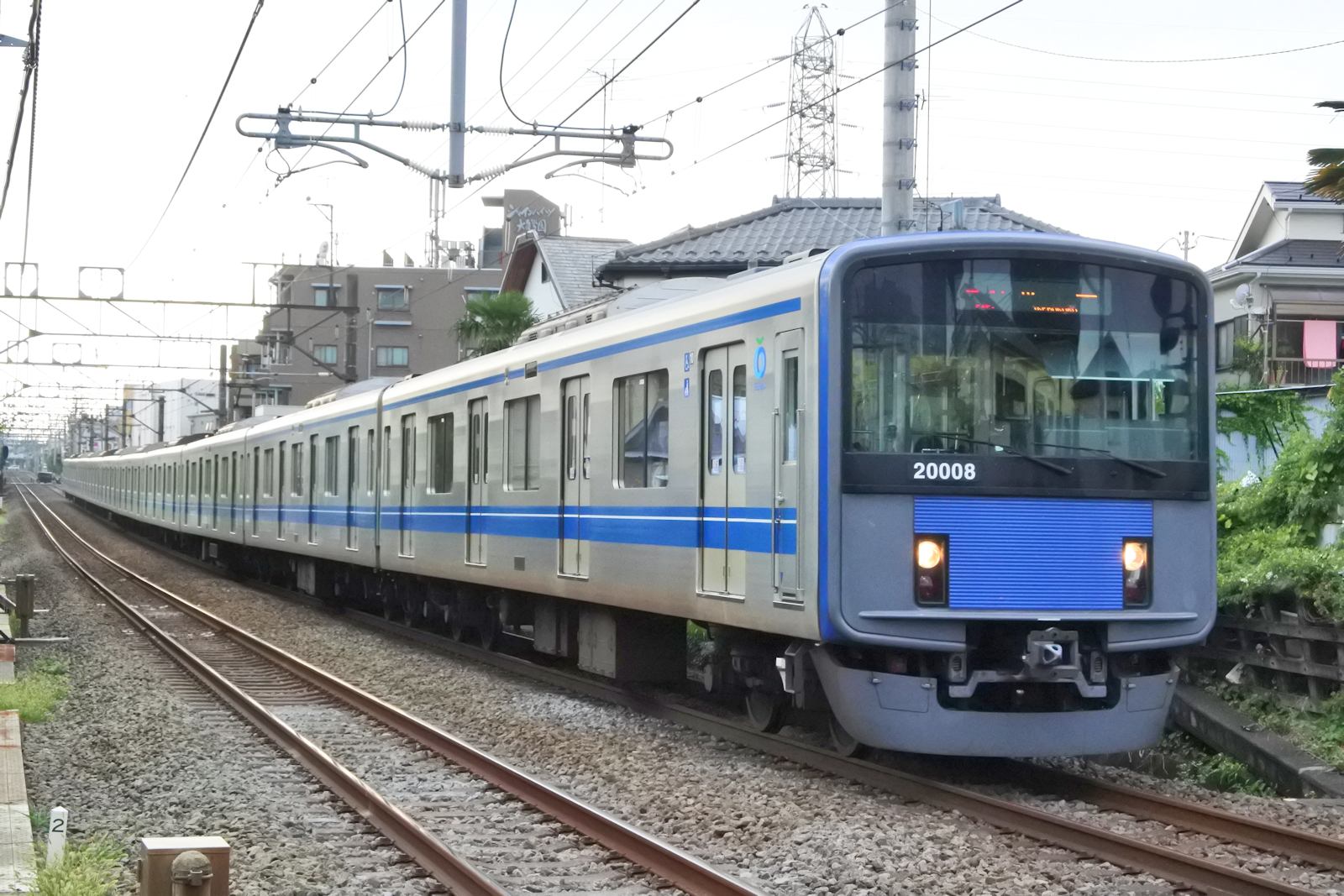
久々に池袋線を走る西武20000系20108F
14日、西武20000系20108Fが久々に池袋線を走る姿を撮影した。20108Fは2005(平成17)年に製造され、最初は池袋線に投入された。2006(平成18)年から2007(平成19)年にかけて、新宿線に在籍していた6000系(6103F~6107Fの5本)を東京メトロ副都心線への直通運転に対応させる改造を施したうえで池袋線へと転属させ、それと入れ替わりに池袋線に在籍していた20000系10両編成5本が新宿線へと転属していったが、この時には20108Fは池袋線に残った。しかし2010(平成22)年に20108Fは新宿線へと転属した。今回20108Fが池袋線を走ることはこの2010(平成22)年の転属以来6年ぶりだという。池袋線在籍の9000系9101F「KPP TRAIN」が7月30日~9月29日までの間、新宿線に貸し出されることから、これと入れ替わりに20108Fが池袋線へと貸し出された。9101Fのラッピング解除・池袋線への復帰までの間とみられるため、20108Fが池袋線を走る姿を見ることができる期間は9101Fが新宿線で見られる期間よりも少しだけ長いとみられる。On 14th, I photographed Seibu 20000 Series 20108F set, which temporary moved to Ikebukuro Line in exchange for 9000 Series 9101F set "KPP TRAIN".20108F originally was built in 2005 for IKebukuro Line. When 5 sets of 6000 Series belonging to Shinjuku Line were converted to adapt going through operation toward Tokyo Metro Fukutoshin Line and transferred to Ikebukuro Line, the same number of 20000 Series on Ikebukuro Line moved to Shinjuku Line in exchange. However, 20108F kept being in service on Ikebukuro Line. In 2010, 20108F moved to Shinjuku Line.The days 20108F in service on Ikebukuro Line may be little longer than 9101F in service on Shinjuku Line as "KPP TRAIN" because of the taking off the livery of 9101F's.
Aug 14, 2016
コメント(0)
-
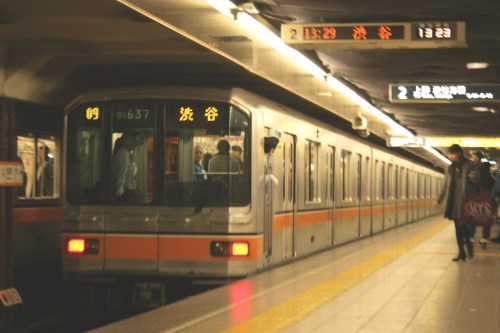
廃車直前に乗車・撮影した東京メトロ01系01-137F
先日のブログで、2015(平成27)年12月20日に東京メトロ6000系6102Fに遭遇できなかったと書いたが、この日は1日東京メトロを楽しんできた。この日乗車・撮影した車両の1つが、6000系と同様に廃車が進んでいる銀座線で活躍する01系の01-137Fである。同車は01-138Fが廃車されたことから当時01系唯一のVVVF制御の編成となっていた。写真は浅草駅を発車する姿を捕えたもの。後になって知ったことだが、01-137Fはそのおよそ1ヶ月後の2016(平成28)年1月に廃車・解体されていた。【廃車解体27編成目】東京メトロ 銀座線01系 01-137F 廃車 渡瀬北留置線 azumatakeshiさん投稿 A YouTube video by azumatakeshiこれで01系のVVVF制御車は2編成とも廃車となり、姿を消した。01-137Fは1993(平成5)年製であることから、22年という短い生涯に幕を下ろした。この時が01-137Fへの最後の乗車・撮影となろうとは、僕は予想だにしていなかった。As mentioned on a blog several days ago, I couldn't photograph Tokyo Metro 6000 6102F on December 20th, 2015. On that day I enjoyed travelling on and photographing Tokyo Metro carriages.One of the carriages I rode on and photographed was 01 Series 01-137F set, which was only one variable-frequency drive system set of 01 Series on that time because of the retirement of 01-138F set.This photograph was taken at Asakusa Station from the back when departing to Shibuya Station.After a couple of months later, I knew that 01-137F was scrapped on January, 2016.Two sets of 01 Series installed variable-frequency drive completely disappeared. 01-137F set, built in 1993, had had run for 22 years.I didn't expect it was last chance for me to travelled with and photograph 01-137F set.
Jul 24, 2016
コメント(0)
-
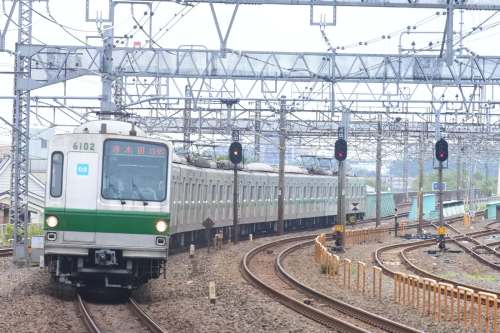
千代田線の生き字引 東京メトロ6000系6102F
小田急4000形に続いて、廃車が進む東京メトロ6000系の中で現役最古参の6102Fが撮れた。6102Fは1970(昭和45)年、川崎重工業製。日本初の電機子チョッパ制御を採用した電車、帝都高速度交通営団(営団地下鉄)6000系の量産車第一号として誕生した。6000系のうち、かつて綾瀬駅~北綾瀬駅間で活躍した6000-1・6000-2・6000-3号車(通称「ハイフン車」)が1次試作車、2016(平成28)年5月に運用離脱した6101Fが2次試作車と位置付けられていることから、6102Fが1次車最初の編成である。新造当時と比べて、制御装置がVVVFに変更された他、内装がリニューアルされ、側窓も上段下降・下段上昇の田の字型のものから1段下降式のものになるなどの変化が見られるものの、ドアチャイム・ドア上のLED案内表示器はなく、側ドアガラスも一回り大きいものに変更されているが、小型ガラスが残り、昭和の営団地下鉄の雰囲気を今に伝えている。6000系は鉄(普通鋼)と比べて錆びることがなく超寿命であるアルミ合金製の車体を採用し、製造当初から40年程度の使用を想定していたが、2016(平成28)年時点でデビューから46年が経過し、目標が達成された。2016(平成28)年7月時点で6102Fは1次車の中では唯一現役である。実は2015(平成27)年12月20日にも6102Fへの撮影・乗車に挑戦しようとしたが遭遇できなかった。今回再挑戦を試みたところ、撮影・乗車することができた。Following Odakyu 4000 Series, I also photographed Tokyo Metro 6000 Series 6102F set, which is the oldest set of 6000 Series in service.6102F set was built in 1975 at the factory of Kawasaki Heavy Industry in Kobe, Hyogo Prefecture, as the first mass-production model. Among 6000 Series, the first amature chopper control carriage in Japan, 6000-1, 6000-2, and 6000-3, which consists of 3-carriage set and used to be in service between Ayase Station and Kita-ayase Station, were first trial-made model, and 6101F set, 10-carriage which used to be in service until May, 2016, was second trial-made model.Compared with when the set debuted and in the present, its control system changed to variable-frequency drive. Its interior was also refurbished. Specifically, the side windows and the size of door glass are changed, but door opening and closing chime isn't installed and small-size door glasses remains, which creates the atmosphere of the subway train in Showa period.Introducing aluminium body, 6000 Series was specified to endure estimated 40-year use at first, but in 2016, it has been in service for 46 years, which means the first plan was already achieved. 6102F is only one set of 6000 Series having been in service since Chiyoda Line's open on July, 2016.I tried to photograph and ride on 6102F on December 20th, 2015, but I couldn't. It was my retry.KATO 10-1143 営団地下鉄千代田線 6000系 6両基本セット Nゲージ 動力車入り価格:13824円(税込、送料別)
Jul 16, 2016
コメント(0)
-
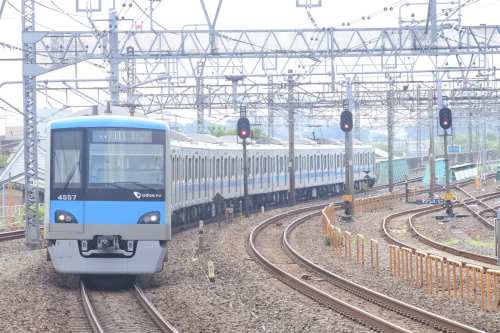
常磐緩行線を走る小田急4000形
583系撮影後は常磐緩行線金町駅へ移動。そこで初めて常磐緩行線を走る小田急4000形を撮影することができた。東京メトロ千代田線の列車はJR東日本常磐緩行線と小田急小田原線・多摩線へ直通運転を実施しているが、それまで小田急電鉄の車両はJR東日本常磐緩行線には乗り入れず綾瀬駅で折り返し、JR東日本の車両は小田急小田原線・多摩線に乗り入れずに代々木上原駅で折り返し、3社の路線を通しで運行できる車両は東京メトロの車両(2016(平成28)年5月まで運行されていた6000系6101Fを除く)に限られていた。しかし2016(平成28)年3月26日のダイヤ改正より、小田急電鉄とJR東日本の車両も3社の路線で運行できるようになり、常磐緩行線を走る小田急4000形や小田急小田原線・多摩線を走るJR東日本E233系2000番台の姿を見ることができるようになった(JR東日本209系1000番台は小田急小田原線・多摩線乗り入れ対応改造されていない)。ちなみに小田急4000形はJR東日本E233系をベースに設計された車両であることから、JR東日本と小田急電鉄で車両の仕様が揃えられている。After 583 Series, I moved to Kanamachi Station on Joban Line local service, and there photographed Odakyu 4000 Series. I've photographed Odakyu 4000 Series several times, but it was first time to photograph it on Joban Line.The trains on Tokyo Metro Chiyoda Line go through Joban Line, Odakyu Odawara Line, and Odakyu Tama Line. However the carriages available to run on all of those lines used to be Tokyo Metro's ones (except 6000 Series 6101F set retired on May, 2016) only, Odakyu's ones don't used to go farther than Ayase Station and JR East's ones don't used to do father than Yoyogi-uehara Station. Since March 2016, Odakyu's ones and JR East's ones (except 209 Series) can operate on all of the four lines.In addition, Odakyu 4000 Series was built based on JR East's E233 Series, which makes the same specification between the two carriages on the same line. ★男の子クーポン対象★小田急 4000形 基本セット価格:14904円(税込、送料無料)
Jul 16, 2016
コメント(0)
-
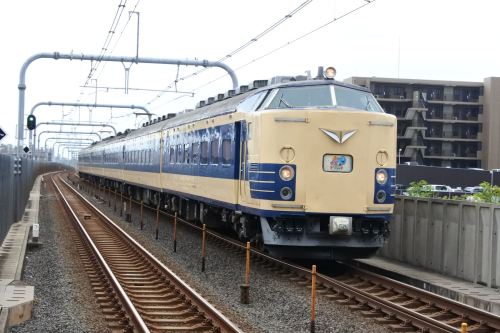
これがラストチャンスか? 583系
16日、2016(平成28)年7月現在、唯一現役の583系である秋田車両センター(秋アキ)所属のアキNー1・Nー2編成を撮った。これで僕が583系を撮るのは今回で5回目となる。今回の撮影場所は越谷レイクタウン駅である。1968(昭和43)年の「ヨンサントオ」ダイヤ改正でデビューしてからまもなく半世紀を迎える583系。2012(平成24)年にJR西日本に所属する車両によって運行された急行「きたぐに」の廃止で定期運行がゼロとなったが、JR東日本ではこのアキN-1・N-2編成は現役最後の583系として、秋田駅~舞浜駅(武蔵野線・京葉線経由)の「わくわくドリーム号」、全国高校野球選手権での秋田県代表校の応援団輸送、そして磐越西線の快速列車「あいづライナー」などの臨時列車として活躍している。国鉄時代に共に全国の特急列車として活躍した485系も特急列車としての定期運行を失い、去る2016(平成28)年6月19日を以て最後の国鉄色の485系であった仙台車両センター所属のセンA-1・A-2編成が引退し、国鉄時代のありし日を思い起こさせてくれる車両が、特急型車両ではこの583系アキN-1・N-2編成だけとなってしまった。僕は583系の全盛期を知らないが、583系は好きな車両である。国鉄民営化からまもなく30年という節目を迎えようとしている今日まで583系が現役で走り続けている姿を見ることが、そして写真に収めることができることには、ファンとしては驚きと嬉しさでいっぱいである。2016(平成28)年4月に開館した京都鉄道博物館にも583系(クハネ581形)は展示されており、その姿を見ることができるが、やはり現役の車両がいるうちは現役のものを間近に見てみたいものだ。On 16th, I photographed 583 Series Aki A-1・A-2 set, which was only one existing set on July, 2016, at Koshigaya Laketown Station on Musashino Line. It was fifth time for me to photograph 583 Series.583 Series has been in service since 1968 and is going to mark its 50th anniversary. Though its regular operations, the last one, "Kitaguni" express between Osaka and Niigata operated by ones belonging to JR West, had finished in 2012, This set remains as the last one set of 583 Series and keep operating as the special trains for tourists, such as the one between Akita Station and Tokyo Station named "Waku Waku Dream" like in this photograph, the one carrying the cheering party of a high school in Akita Prefecture for Japan's National High School Baseball Tournament, and rapid train on Banetsu West Line "Aizu Liner".Among the JR cars for limited express trains, the ones keep existing and reminding railfans of the days in Japan National Railway period is also this set only after the retirement of Sen A-1・A-2 set of 485 Series, which used to run all over Japan as limited express trains on Japan National Railway together with 583 Series, on June, 2016.Though I don't know the golden age of 583 Series, it is one of my favourite carriages. I'm surprised and deeply moved to see and photograph it until the present, having been about 30 years since JNR's privatization.A front carriage of 583 Series (Kuhane 581) started to be exhibited at Kyoto Railway Museum, but I prefer to see the running ones as I can. 98608 JR 583系電車(JR東日本N1・N2編成・床下黒色)セット (6両)[TOMIX]《10月予約》価格:16580円(税込、送料別)
Jul 16, 2016
コメント(0)
-
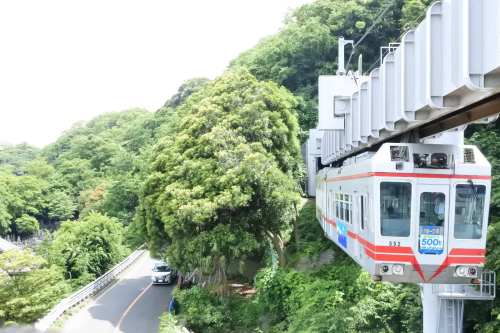
湘南モノレール500形のラストランを見届ける
6月26日、湘南モノレール500形のラストランを見に行った。500形は1988(昭和63)年に登場した、湘南モノレールの3代目車両。3両編成6本(18両)が製造され、1970(昭和45)年の開業時から活躍してきた300形を置き換えた。湘南モノレール初の冷房車でもある。最後の1編成となった551Fは1991(平成3)年に製造された。大船駅でJR東日本横須賀線の列車を降り、湘南モノレール江の島線ののりばへ向かうと、運良く551Fが停車していた。まずは終点の湘南江の島駅まで一通り乗車した。僕と同様に最後に500形に乗っておきたいと思しき鉄道ファンで車内は混雑していた。乗車に続いては撮影に移った。On June 26th, I went watching the final run of Shonan Monorail 500 Series, which had been in service since 1988 as third generation carriage on Shonan Monorail Enoshima Line running in Kamakura and Fujisawa Cities, Kanagawa Prefecture. Six 3-carriage sets were built and replaced the first generation 300 Series. It also installed cooler and heater first time among Shonan Monorail carriages.The last remained set, 551F, were built in 1991.As coming to the platform of Enoshima Line, 551F was stopping and ready to depart. Riding on it, I went to Shonan-enoshima terminal to enjoy my last trip. In the train was crowded by many persons, maybe they were railfans who had the same thought as me. After the train approaching the terminal, I started photographing of 551F. 湘南江の島駅にて leaving from Shonan-enoshima Station湘南町屋駅にて approaching Shonan-machiya Station以上の2枚は横の構図で撮ったものの、懸垂式(三菱サフェージュ式)モノレールである湘南モノレールの車両を魅力的に撮るには、やはり高さを強調させることだと思い、軌道直下の道路から縦の構図でも撮影。These two were photographed with lateral shooting, but I noticed that it was preferable way to photograph Shonan Monorail carriage, hanging-style (Mitsubishi SAFEGE), to feature the height of the structure. I also photographed from the roadway under the railway structure.片瀬山駅~西鎌倉駅にて Between Kataseyama Station and Nishi-kamakura Station富士見町駅~大船駅間にて Between Fujimicho Station and Nishi-kamakura Station551Fは12:37大船駅発の湘南深沢行き(通常ダイヤでは湘南江の島行きであるが、551Fによる運行は湘南深沢駅で打ちきり。同駅で5000系5601Fに車両交換)を以てすべての営業運行を終えた。12:48、551Fは湘南深沢駅付近の車両基地へ最後の帰宅をした。車両基地では特別撮影会が開催され、多くの撮り鉄が詰めかけた。551F finished its regular operation, which departed at 12:37 from Ofuna (according to the timetable the operation was bound for Shonan-enoshima Station as usual but the carriage for it was changed to 5000 Series 5601F set at Shonan-fukasawa). At 12:48, 551F came to the railyard near Shonan-fukasawa Station, where a photographing event was held. Many photographers came there to take images and say good-bye to the carriages.僕にとって、湘南モノレールの車両と言えば500形のイメージが強かった。僕はかつて神奈川県・藤沢に住んでいたことがあり、その当時の主力車両が500形であり、東京に移ってからも何度か江ノ島・鎌倉方面へ行くことがあったが、その時に乗った車両も500形だった。そんな慣れ親しんだ500形の最後の雄姿を一目見たかった。500形の姿を見られなくなる、カーヴが多く高低差の変化も激しい江の島線特有の線形からの乗車時の激しい揺れももう味わえないとなると、寂しさで胸がいっぱいになった。500 Series gave me the image of Shonan Monorail carriage in my mind. In my childhood, living in Fujisawa City, Kanagawa Prefecture, I had travelled with 500 Series several time, and after moving to Tokyo, I rode on it every time I travelled in Kamakura and Enoshima area. To watch its last day, I remembered these travels in the past and my stable image.I felt desolate that it was last chance to see 500 Series and feeling the swing coming from many curves and steep slopes.
Jun 26, 2016
コメント(0)
-
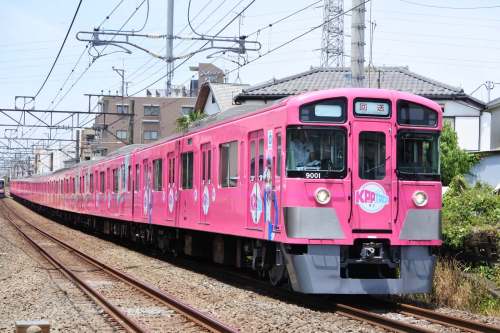
ピンク色の西武9000系「KPP TRAIN」登場!!
6月4日、ピンク色のラッピングの「KPP TRAIN」となった西武9000系9101Fを撮影。西武9000系のラッピング車両は9103F「RED LUCKY TRAIN」、9108F「L-train II」に続いて3編成目となる。「KPP TRAIN」はファッションモデルや歌手として活躍するきゃりーぱみゅぱみゅさんとタイアップした、きゃりーさんの歌手デビュー5周年を記念した特別車両。「ポップ&カラフルな夢のような車両」がコンセプトであり、ピンク色地にきゃりーさん本人の写真をデザインした外観だけでなく、内装もきゃりーさんがこれまでに歌った楽曲の世界観をイメージしたものとなっている。ちなみに9101Fの10両のうち、クハ9101、モハ9201、モハ9301、クハ9001の4両は、きゃりーさんと同い年の1993(平成5)年生まれである。この日は9101Fが「KPP TRAIN」として初めて営業運行される日であり、池袋駅ではきゃりーさんと西武鉄道の後藤高志会長が出席しての出発式が執り行われた。「KPP TRAIN」一番列車は事前応募制の臨時列車として運行され、きゃりーさんも乗車した。これら2枚の写真は武蔵丘車両基地から池袋駅への回送運転時に撮影したものである。この「KPP TRAIN」は2016(平成28)年9月29日まで運行される予定。On June 4th, I photographed Seibu 9000 Series 9101F set, which had a pink-coloured livery. It was third time that Seibu 9000 Series having special livery appeared, following 9103F "RED LUCKY TRAIN" and 9108F "L-train II".The carriage is named "KPP TRAIN", tied up with Kyary Pamyu Pamyu, a Japanese fashion model and singer to mark 5th anniversary of her career as a singer. The concept of carriage design is "pop & colourful". Not only the livery with Kyary's portrait, but the interior of the carriages are also decorated under the concept of world of Kyary's music.By the way, four carriages, two front ones, Kuha 9101 and Kuha 9001, and two middle ones, Moha 9201 and Moha 9301, were built in 1993, the same year Kyary was born.On that day, 9101F started its service as "KPP TRAIN" and a ceremony which Kyary and Seibu Railway's Chairman, Takashi Goto, attended, was held at Ikebukuro Station. The first operation of "KPP TRAIN" ran as a special train for persons applied for observing the ceremony and Kyary also rode on.These two were photographed when the set ran as an out-of-service train before its first run carrying passengers from Musashigaoka railyard.9101F set is being in service until September 29, 2016 as "KPP TRAIN".
Jun 4, 2016
コメント(0)
-
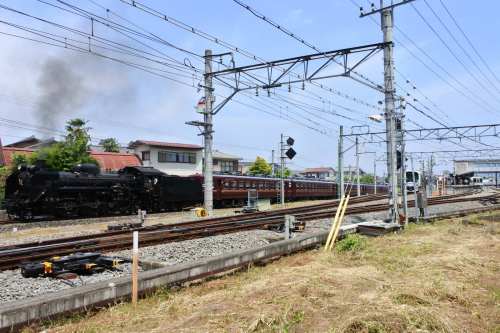
SLパレオエクスプレス 西武秩父駅に入線
5月29日、秩父鉄道の「SLパレオエクスプレス」として運行されているC58形蒸気機関車と12系客車が初めて西武西武秩父線の西武秩父駅に入線する臨時列車が運行された。On May 29th, I went seeing first running of Class C58 steam locomotive and 12 Series passenger carriage hauled the locomotive between Seibu-chichibu Station on Seibu Seibu-chichibu Line and Mitsumineguchi Station on Chichibu Railway Chichibu Main Line to Seibu-chichibu Station.この日は回送列車として広瀬川原の車両基地から秩父本線を走ってきたC58形蒸気機関車と12系客車が西武秩父駅の脇を通過する。列車は一度影森駅まで回送された。Though the train carries passengers on weekend and holiday operation, but on that day it came as an out-of-service train. The train once went to Kagemori Station.西武秩父駅には転車台がないため、通常運行時の熊谷駅入線の時と同様に、最後尾にデキ200形電気機関車を連結して、同機に牽引されながらC58形蒸気機関車が最後尾となって影森駅~西武秩父駅間を走り、西武秩父駅構内の渡り線に入線した。西武鉄道の4000系が秩父鉄道秩父本線へと直通運転するのに対して、秩父鉄道の車両が西武西武秩父線に直通することはないため、秩父鉄道の車両が西武鉄道の線路を走った初めての瞬間となった。Ten or twenty minutes later, The train went back hauled by Class Deki 200 electric locomotive because the steam locomotive couldn't go to the opposite end of the passenger carriages from the other at Seibu-chichibu Station. Though Seibu 4000 Series go through Chichibu Main Line from Seibu-chichibu Station or Ohanabatake Station, Chichibu Railway carriages don't go onto Seibu-chichibu Line, so it was first time that Chichibu Railway carriage ran on Seibu-chichibu Line. 列車は西武秩父駅の2番線に停車し、3番線に先に入線していた、これまた臨時で運行された西武10000系特急レッドアローと並ぶ。The train came to track 2 and met Seibu 10000 Series "New Red Arrow" stopping at track 3.普段秩父鉄道の車両が入線しない西武秩父駅に停車している様子が解るように、脇の秩父本線を走る秩父鉄道6000系急行「秩父路」と一緒に1枚。To photograph easily-understandable image of Class C58 steam locomotive stopping at Seibu-chichibu Station, I shot that the locomotive with Chichibu Railway 6000 Series passing next to the station.臨時列車は定時に西武秩父駅を、三峰口駅に向けて発車した。The train left Seibu-chichibu Station on time.
May 29, 2016
コメント(0)
-
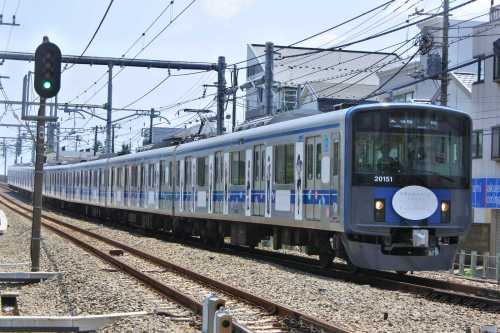
西武20151F 写真追加
西武20000系20151F「ずっと前から好きでした。」ラッピング車両と再び遭遇し、写真も新しいものが撮れた。I would like to show more photographs of Seibu 20000 Series 20151F set having "I want to let you know that I love you" anime livery.編成全体像 Whole sets主人公の榎本夏樹ちゃん。お団子ヘアが特徴のピュアな女の子。担当声優は“はるちゃん”や“とまっちゃん”の愛称で呼ばれる、4人組ユニット、スフィア(アニメのエンディングテーマ歌唱も担当)のメンバーとしても活躍する戸松遥さん。「妖怪ウォッチ」などの人気アニメへの出演や「○○!投稿DO画」などのナレーションのほか、のと鉄道や伊豆急行の列車の車内アナウンスや、近年では京都市地下鉄東西線の列車が太秦天神川駅に到着する前に流れる京都学園大学のコマーシャル放送も担当したことでも知られる。A livery pictured Natsuki Enomoto, the heroine of this work. She is voiced by Haruka Tomatsu, who is known as a member from "Sphere", is voice-cast on "Yo-kai Watch" and more famous animes and as a narrator on some TV programme in Japan, and whose voice has been also used as announcements on some railway carriages, such as those on Noto Railway, on Izu Kyuko, and commercial announcement of Kyoto Gakuen University played in Kyoto Municipal Subway Tozai Line.車内も中吊りのみではあるがアニメのものに統一されていた。All of the advertisements hung from the ceiling are the anime's one.
May 29, 2016
コメント(0)
-

「西武 旅するレストラン」初撮影!!
4月17日にデビューした西武4000系改造車「西武 旅するレストラン」を初めて撮影した。大泉学園駅直結のリズモ大泉学園4階のテラスから、テラス内の植え込みを入れて高架区間から駆け下りる列車を撮影。「西武 旅するレストラン」は関東の大手私鉄初の観光列車として誕生し、土休日を中心に池袋駅~西武秩父駅間、西武新宿駅~西武秩父駅間、西武新宿駅~本川越駅間を運行している。車両デザインに東京・南青山の根津美術館や京王高尾線高尾山口駅のデザイナー・隈研吾さん、車内BGMに九州新幹線の発車メロディと車内チャイム、東急東横線渋谷駅の発車メロディを作曲した向谷実さん、車内で提供される食事メニューの総合監修につきぢ田村の三代目で、NHKの料理番組でも活躍する田村隆さんという豪華メンバーが集結した。僕も「西武 旅するレストラン」に乗りたいところだが、多くの観光列車が旅行商品として売り出されているため、予約は最低でも2人からという場合が多く、1人では乗れないところが悩ましい点である。On April 17th, I photographed Seibu 4000 Series 4009F "Fifty two Seats of Happiness" first time from the terrace of LIZMO Oizumi-gakuen."Fifty two Seats of Happiness" is refurbished from Seibu 4000 Series and debuted as the first comfortable travel use carriage from Tokyo Metropolitan Area, which operates mainly Saturdays, Sundays, and holidays between Ikebukuro and Seibu-Chichibu, Seibu-shinjuku and Seibu-Chichibu, and Seibu-shinjuku and Hon-kawagoe.The carriage is designed by Kengo Kuma, who is also known as the designer of Nezu Museum in Minami-aoyama, Tokyo, and Takao-sanguchi Station on Keio Takao Line, its interior BGMs are composed by Minoru Mukaiya, known as the composer of music in the trains or at the stations, such as the one on Kyushu Shinkansen trains and stations and Shibuya Station on Tokyu Toyoko Line, the dishes are supervised by Takashi Tamura, cook at Tsukiji Tamura and sometimes appears on NHK's cooking programme.Though I also want to travel with "Fifty two Seats of Happiness", it is uneasy to do because most of these kind of trains including it sell as a part of a package tour for two or over.
May 28, 2016
コメント(0)
-

東京メトロ10000系フルカラーLED車に遭遇!!
5月10日、行き先表示がフルカラーLEDに変更された東京メトロ10000系に遭遇した。東京メトロでは東西線を走る15000系から本格採用されているフルカラーLEDの行き先表示が有楽町線・副都心線を走る10000系にも取り付けられた。フォントも3色LEDの明朝体に対して、15000系、16000系、1000系と同様のゴシック体となっている。同様に副都心線を走る東急5050系・4000系、西武6000系、東武9000系・50070系の行き先表示がフルカラーLEDであったのに対して、東京メトロ10000系は3色LEDであったことから、3月のダイヤ改正から種別が増え(Fライナーと東上線快速急行が追加)たこともあり、遠目から見ても一目で種別が判るようにするための措置と見られる。横浜高速鉄道Y500系は種別表示が幕式であるため、種別表示の見えやすさという点ではフルカラーLEDと同等と言える。まだ全編成に取り付けられている訳ではないが、今後多くの編成に取り付けられるであろう。On May 10th, I saw Tokyo Metro 10000 Series whose destination indicator changed to full-colour LED.Among Tokyo Metro carriages, full-coloured LED had been introduced since 15000 Series on Tozai Line as the destination and operation kind sign on carriage's front and side. Though the sign of 10000 Series' could only indicate orange-, green-, and blue-coloured letters, it changed to the new one, and the font on the sign also did to gothic typeface, the same as 15000 Series, 16000 Series, and 1000 Series, from Ming-style.From March, 2016, new operation kind on Fukutoshin Line and Tobu Tojo Line, F-Liner and rapid express, appeared and it might become little difficult that people could identify the indication, compared to full-coloured ones.From the viewpoint of colour identification, rollsign of Yokohama Minatomirai Railway Y500 Series couldn't be inferior to full-colour LED.Though all carriages of 10000 Series don't equip the full-coloured one in the present, it can be assure to increase the set having full-coloured indicators.
May 10, 2016
コメント(0)
-
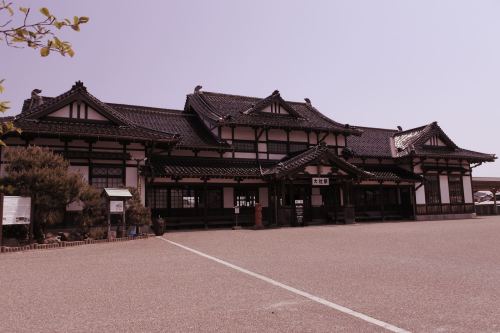
壮麗な鉄道遺産 旧大社駅を見る
出雲大社から神門通りを15分程歩いて、鉄道ファンとしては見逃せないものを見に行く。かつて出雲大社前駅とともに多くの参拝客を迎え入れた、旧大社駅である。Taking about 15-minute walk from Izumo Taisha Shrine, I next watched old Taisha Station on closed JR Taisha Line.大社駅は国鉄(→JR西日本)大社線の終着駅として1912(明治45)年に路線の開通と同時に開業した。大社線はかつて出雲市駅~大社駅を結んだ営業キロ7.5kmの路線で、東京駅から急行「出雲」(寝台特急「サンライズ出雲」の前身)が、名古屋駅から急行「大社」が、京都駅・大阪駅から急行「だいせん」「しまね」が、乗り入れ、出雲大社への参詣路線として賑わった。しかし「出雲」が特急格上げと同時に、行き先を大社駅から浜田駅に変更したことに始まり、他の列車も行き先の変更や廃止となったため、1985(昭和60)年には大社線を走る急行列車がなくなった。大社線は国鉄再建法に基づく第3次特定地方交通線(1日あたりの利用客が4,000人以下の路線)に指定された。1990(平成2)年、宮津線(北近畿タンゴ鉄道に譲渡された後、2015(平成27)年よりWILLER TRAINSに運行を移管 現在のWILLER TRAINS宮舞線・宮豊線)、鍛冶屋線と共に特定地方交通線として最後の廃線となった。大社線廃線後も、その壮麗な佇まいから、大社駅は保存され、その姿を見ることができるだけでなく、中に入ることもできる。2004(平成16)年に国の重要文化財に、2009(平成21)年には経済産業省の近代化産業遺産に指定されている。保存されている駅舎は1924(大正13)年に改築された2代目であり、当時の鉄道省神戸鉄道管理局の丹羽三雄(にわ・みつお)技手の設計による、出雲大社の門前町にふさわしい、平屋建ての瓦葺き風木造建築。駅舎正面に向かって、中央にコンコース(三等待合室)ときっぷ売り場(出札口)が、右側に二等・一等待合室が、左側に貴賓室(戦後にきっぷ売り場に改装)と駅長室が配置されている。駅舎の設計は、辰野金吾設計の奈良ホテル(当時鉄道省直営 現在はJR西日本ホテルズ・都ホテルズ&リゾーツ系列)や二条駅駅舎(京都鉄道博物館に展示・保存)を参考にしたとも言われている。Taisha Station opened in 1912 at the same time as Taisha Line between Izumoshi Station and there, which was 7.5km (4.66mi) -long and on which express trains terminated there had run from Tokyo, Nagoya, and Kyoto until 1985, but closed in 1990 as one of the last unprofitable lines carrying under 4,000 passengers a day, as well as Kajiya Line in Hyogo Prefecture and Miyazu Line in Kyoto and Hyogo Prefectures, which was inherited by Kitakinki Tango Railway and now operated by WILLER TRAINS since 2015.However, after the close of Taisha Line, Taisha Station have been preserved and open to the public. This preserved station building was rebuilt in 1924 designed by Mitsuo Niwa, an assistant engineer working at Railway Ministry. The building consists of concourse for regular class passengers and ticket vending booth at centre, that for second (Green Car in the present) or first class passengers on the right, and VIP room and station master's room on the left. It is said that the design of the building is inspired by Nara Hotel, which Railway Ministry used to run and now an affiliate company of JR West and Kinki Nippon Railway (Kintetsu), and Nijo Station building, which is preserved at Kyoto Railway Museum.コンコース(三等待合室)には、和風建築であるにも関わらず柱がなく、天井の高さも相まって広い空間を創り出している。一般的な和風建築では、梁に対して垂直に入る束と梁(天井)下の柱で屋根の垂木を支える構造が採られることが多いが、大社駅では梁、束と、梁に対して左右斜め方向に伸びる筋交を屋根の垂木の直下に配された合掌に固定させて屋根を支える「トラス構造」を採り入れたことで、柱のない広いコンコースを実現できたという。コンコースの天井には行燈風のシャンデリアが吊り下げられ、これもまた和の趣を醸し出している。I first saw the normal class concourse. In most cases of ordinary Japanese-style buildings, their roof is supported by strut at right angle with beam and column under the beam or ceiling, but Taisha Station introduces truss structure for roof carcass, which made a columnless space. Ceiling lamp looking like paper-covered lantern also makes Japanese atmosphere.きっぷ売り場は2箇所あり、入口を入って正面に見える木の温もりが漂う改築当初からのものと、左側にある戦後に貴賓室の一部を改装したものとがある。The concourse has two ticket vending booths, the one in the normal class concourse beside a platform, which warmth of wood since its rebuild, and the one on the left of the concourse was converted from a part of VIP room.木製の改札口の上には、大社線最末期の時刻表が掲げられている。1990(平成2)年当時は、15本の出雲市行き普通列車が運行されていた。Above a wooden gate, a timetable when Taisha Line closed was shown. There were 15 trains, all of which were local for Izumoshi.改札口を通り抜けてホームに出る。改札は3箇所あり、駅舎の三等待合室側には駅舎の風格に合わせた木造のものが2箇所と、二等・一等待合室側には、現代的な金属製のものが並ぶ。後者は駅舎に入ることなく直接外へと出ることができる。入口と出口で使い分けていたのか、常設のものと三箇日などの多客期用の臨時のものとして使い分けていたのかは解らないが、ローカル線の駅でこれだけの数の改札口が並んでいたということからも、大社駅が出雲大社へとお参りする人々で賑わっていたことを物語っているようにも見えた。I next saw the platforms, going out of a gate. The station has three gates, two of them are wooden framed and matches the building, and the other is modern one made of metal, which passengers go out of the station directly, which may signify that the station used to be used by many people visiting Izumo Taisha Shrine. I don't know how those gates used in the old time, weather for going in or out, or for regular use and only for on season such as new year's day.ホームは2面3線の、いわゆる「国鉄型配線」となっている。かつて線路が出雲市駅へと伸び、キハ58系などの車両が行き来していたことを想像しながら、ホーム先端から1枚。The station has two platforms and three tracks. Standing on the end of one of them, I imagined that Kiha 58 Series diesel carriage used to run on Taisha Line and shot the scenery toward Izumoshi Station.ホームにはD51形蒸気機関車も保存されていて、往時の列車が停車していた頃を想像させる。On the platform, Class D51 steam locomotive is also preserved, which shows the train stopped there in the old time.二等・一等待合室には、大社線関連のグッズや記念きっぷの他に、タブレット閉塞器が2器1組展示されていた。大社線は列車交換(すれ違い)が可能な中間駅が存在しなかったことから、出雲市駅~大社駅間全線が1つの閉塞区間と扱われ、全線で1本の列車しか走らせることができなかった。そのため1器は「大社」と書かれていたことから大社駅に、もう1器は出雲市駅に置かれていたものとみられる。In the second and first class concourse, a couple of tablet token instrument is displayed, as well as the goods and special tickets related to Taisha Line. The one of the instrument on which the station name "大社 (Taisha)" was written seemed to be installed there, and the other at Izumoshi Station because Taisha Line had no middle stations at which the trains could meet.参考資料テレビ東京 「美の巨人たち」 旧大社駅 2016年1月30日放送 TV Tokyo "Bi no Kyojin Tachi" on January 30th, 2016
Apr 30, 2016
コメント(0)
-
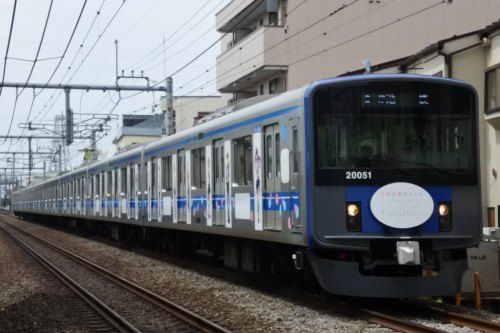
「西武鉄道からのプレゼント!」西武20000系20151F
4月23日、2016(平成28)年4月18日よりアニメ「ずっと前から好きでした。~告白実行委員会~」のラッピング車両となった西武20000系20151Fを池袋線保谷駅~大泉学園駅間の踏切で撮影。ちなみに20151Fの撮影は行き先表示がフルカラーLEDに変更されてから初めてである。車体には、「あの花」ラッピングだった2013(平成25)年の6000系6157Fや、「ここさけ」ラッピングだった2015(平成27)年の6000系6156Fと同様に、各ドア横に登場キャラクターのイラストが大きく描かれ、車体全体にはピンク色と水色のシャボン玉模様をちりばめた、華やかでかわいらしいイメージになっている。シャボン玉模様は、どこかかつての東急9000系9013Fを想像させ、僕にはどこか懐かしい雰囲気だった。撮影前にも1度遭遇し、車内を見たところ、中吊り広告もアニメのもので揃えられていたことに加えて、6000系や30000系の西武スマイルビジョンでも同作品のCMが放映されている。僕はよく知らないアニメであるが、車両にラッピングされただけに、少々気になっている。On April 23rd, I photographed Seibu 20000 Series 20151F set having the livery of "I want to let you know that I love you" anime between Hoya and Oizumi-gakuen. It also be firist time to me after its destination indicator changed to full-coloured LED.On its body the illustration of characters next to each door, the same as 6000 Series 6157F set in 2013 having "Anohana ~the flower we saw that day~" livery and 6156F set in 2015 having "The Anthem of Heart -Beautiful Word Beautiful World-" livery, and pink- and light-blue-coloured bubbles are laid out, which has a similar atmosphere to Tokyu 9000 Series 9013F set having colurful bubble livery in the old time on Toyoko Line.All of the hanging advertisements in these carriages are also the one of this work and, on the LCD display above the doors of 6000 Series and 30000 Series, the commercial movie of this work was played.I don't know much about this work, but the train made me pay attention to it.
Apr 23, 2016
コメント(0)
-

「Fライナー」渋谷駅発車
渋谷駅を発車する東急4000系の「Fライナー」(東横特急)のビデオを撮影。「Fライナー」に指定されている東横特急の種別表示は、旧来のオレンジ色地に白文字の「特急」の表示に加えて、「Fライナー」を示す黄緑色地に「F」をあしらったマークが描かれている。列車は渋谷駅の地下化、東京メトロ副都心線との直通運転開始と同時に導入された向谷実さん作曲の発車メロディ「Departing from New Shibuya Terminal」を合図に元町・中華街駅へと旅立つ。やはり東急4000系に一番似合う発車メロディは、東横線の起点を彩るこの曲であろう。At Shibuya, I shot videos of Tokyu 5050-4000 Series in F-Liner(limited express) service departing.On Toyoko Line, indicators of F-Liner train shows "LTD. EXP." in an orange rectangle, which has been using since limited express service started in 2001, and F-liner logo, white F in a green square, added in the rectangle.Station melody "Departing from New Shibuya Terminal",having been used since the track moving to underground and starting going-through service to Tokyo Metro Fukutoshin Line, played, the train was ready to leave to Motomachi-chukagai [Yokohama Chinatown] Station. From my point of view, it is the best music becoming Tokyu 5050-4000 Series.
Apr 2, 2016
コメント(0)
-
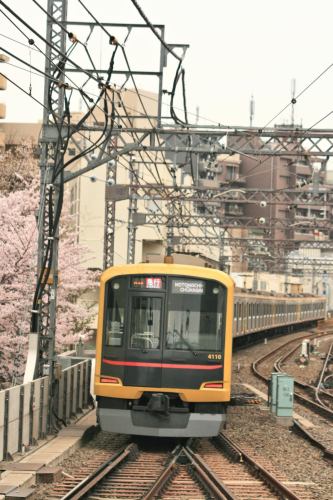
東急電車とサクラを愛でる
東京でサクラの見頃を迎えたことに次いで、横浜でもサクラが満開となった4月2日、東急電車とサクラの組み合わせの写真を撮りに行った。東横線中目黒駅中目黒駅の代官山方直下の目黒川は東横線沿線きってのサクラの名所。田園都市線池尻大橋駅付近から目黒線・JR東日本山手線目黒駅付近にかけて約800本ものサクラの木が花を咲かせる。川沿いの歩道や橋から高架線を走る列車をサクラと共に見えるのはもちろんのこと、ホームからも見事に咲き誇るサクラを見下ろすことができる。僕が撮影した写真は、上から高架付近のサクラと後追いの4000系「Shibuya Hikarie号」、宝来橋から臨む5050系、高架下から見上げるサクラと4000系、1番線に入線する4000系と高架下の目黒川のサクラ。東横線・目黒線多摩川駅~新丸子駅間多摩川の川原近くに位置する多摩川台公園の多摩川側のスロープの途中にあるサクラと、その枝の隙間から覗くようにして多摩川橋梁を渡る東横線・目黒線列車と共に撮影した。東急多摩川線多摩川駅~沼部駅間多摩川駅の地下へと潜る手前、バス停付近の踏切から、7700系の多摩川行き列車とサクラを撮る。大井町線緑が丘駅緑が丘駅の溝の口方先端から、大井町方面行き列車と高架横に植えられたサクラの写真を。9000系の各停列車と6000系の急行列車を1枚ずつ。池上線石川台駅~洗足池駅間サクラの木が植えられた切通しから列車を見下ろす。ここは東急電車ファンの間では有名なサクラスポットであったが、木の高齢化による倒木の危険性が出てきたため、そのほとんどが伐られ、以前ほどの華やかさが見られなくなってしまった。伐られた木に代わって新しく植えられたと思われるサクラと1000系の1枚を。池上線五反田駅五反田駅も東横線中目黒駅と同様に目黒川のサクラと列車のツーショットが撮影可能である。池上線の車両が18m級3両編成のため、広角レンズを使って撮ると、編成全体をファインダーに収めることができる。写真は橋梁を渡り五反田駅へと入線する1000系。田園都市線すずかけ台駅すずかけ台駅のつくし野方にサクラの木植えられている。渋谷方面行き列車とそのサクラを、線路をオーバークロスする路地から俯瞰のアングルで列車を捕らえる構図で撮る。ここも広角レンズを使えば、10両編成の田園都市線列車もサクラや沿線の風景と共に最後尾まで入れることができる。写真は5000系。----------------------------------------------------------------------------------------------------On April 2nd, cherry blossom season came not only in Tokyo, but also in Yokohama, I went photographing cherry blossoms along Tokyu Railway Lines with carriages.Nakameguro Station on Toyoko LineUnder elevated railway around Nakameguro, one of the most famous cherry blossom spot spread from Ikejiri-ohashi Station on Den-en-toshi Line to Meguro Station on Meguro Line and JR East Yamanote Line. About 800 trees are planted along Meguro River. Not only from riverside walkway or bridge, but the blossoms are seen also from platforms. What I photographed are 5050-4000 Series 4110F "Shibuya Hikarie" set from back with the tree beside the railway, the blossoms along the river and 5050 Series from Horai Bridge, looking up the blossoms and 5050-4000 Series, 5050-4000 Series entering the platform with the blossom.Between Tamagawa Station and Shin-maruko Station on Toyoko and Meguro LineIn Tamagawadai Park near Tamagawa Station, a cherry tree facing Tamagawa River is planted in the middle of a slope. What I photographed are the trains, both Toyoko Line (5050 Series) and Meguro Line (5080 Series) over the cherry tree.Between Tamagawa Station and Numabe Station on Tamagawa LineNear a crossing before the train going underground and near a bus stop, a cherry tree is seen. What I photographed is 7700 Series and the blossoms.Midorigaoka Station on Oimachi LineFrom the end of a platform toward Mizonokuchi, some cherry trees are seen beside the railway are seen. What I photographed are 9000 Series and 6000 Series with the blossoms.Between Ishikawadai Station and Senzokuike Station on Ikegami LineThe cut section is one of the most well-known cherry blossom spot among railway photographers. However, in 2016, almost of all trees are cut down to avoid falling onto the tracks. What I photographed is a young tree, seeming to be newly planted, and 1000 Series running in the cut.Gotanda Station on Ikegami LineAt Gotanda, the railway also crosses over Meguro Liver and the trees are planted along the river like Nakameguro on Toyoko Line. Using a wide lens, whole 3-carriage set and the blossom under the track can be captured. What I photographed is 1000 Series about to enter Gotanda.Suzukakedai Station on Den-en-toshi LineNear the end of platform of Suzukakedai Station, some cherry trees are planted. What I photographed is looking down 5000 Series leaving Suzukakedai and the trees from a path crossing over the track.
Apr 2, 2016
コメント(0)
-
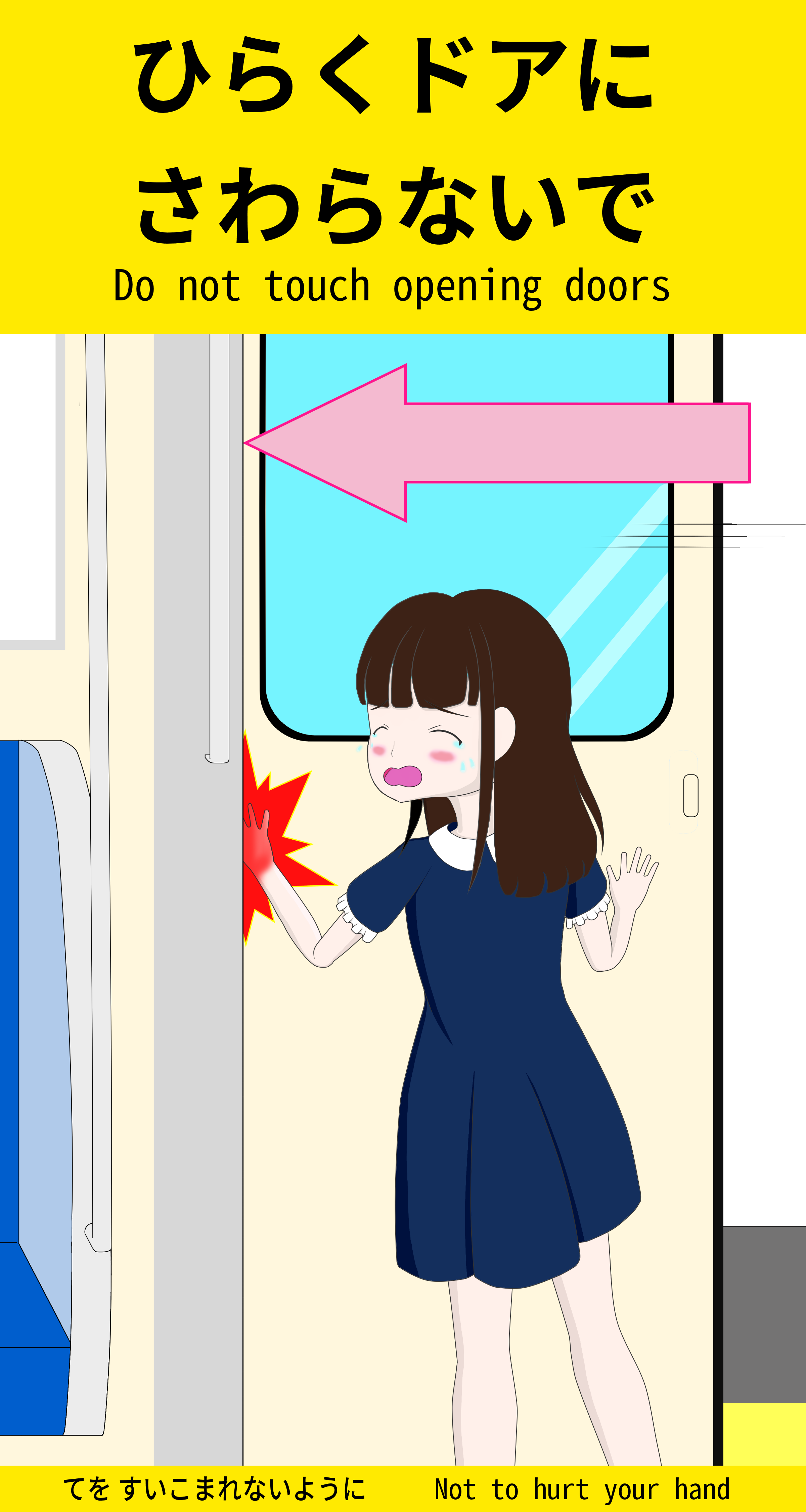
広めたいオリジナルドアステッカー第2弾
オリジナルドアステッカー 第2弾 | 花見 友紀 [pixiv] 花見友紀オリジナルのドアステッカー第2弾を描いてみた。今回も「子供の目線」「かわいらしいデザイン」「高いメッセージ性」をコンセプトとし、大阪市地下鉄などのものと同様に、女の子のキャラクターが戸袋に手を引き込まれて痛がっているイラストを使用し、貼り付け位置も同様にドアの化粧板の戸袋寄り、子供の目線に合わせたガラス下部R付近を想定している。今回の娘も、前回のロングヘアー(ハーフアップ)の娘と同様の小学校1年生という年齢設定で描いている。今回の娘は、あまり髪を長くせず、自然な6~7歳くらいの女の子らしい肩下までの長さにした。車両は今回もこれといった設定を作らず、架空の通勤型車両とした。前回はイラストのみだったが、今回は「ひらくドアにさわらないで」という注意書きを加え、イラストと文字で事故防止を呼びかける。さらにはユニバーサルデザインを意識し、外国からの観光客にも解りやすいように、英文併記とした。「ドアにちゅうい」ではなく、手を引き込まれないように具体的にどうしてほしいのかを書き表すことで、よりメッセージ性の高いステッカーとなることを狙っている。実際にも、注意書きを子供向けに事故防止のためにどうしてほしいかを解りやすい表現で書くように工夫しているステッカーを導入している事業者が見られる。一例として、「ここに てを おかないで」(広島高速交通)「ひらくドアから てをはなしてね」(京王電鉄)などがある。手をドアに「置かない」「触らない」というところが、新しいキーワードとなっている。引き込まれ事故対策としては、かつての営団地下鉄(現在の東京メトロ)や東急電鉄のように、ドアガラスを小型化したり、ドアガラスの下3分の1~半分をステッカーで覆い隠してしまうような時代もあったが、視界を遮ることでドアに貼り付いて窓から景色を見ようとする子供を減らす効果はあったかもしれないが、先ほどのようなドアに「触らない」ように警告するような文章がなかったため、現在ほど親切なものではなかったのではと思えてしまう。(参考:側ドアガラスが小さい東急初代5000系電車)(参考:側ドアガラスの下半分がステッカーで覆い隠された東急初代7000系電車)事故防止のために手をドアに「置かない」「触らない」ように呼びかけることにようやく気付いたと言えよう。貼り付けイメージ Image of the layout of the sticker on the doorsステッカーの文面にGoogle・AdobeのNoto Sans CJKを使用しています。I create my second original "mind the doors" sticker.Following the last work, this time also resembles the Osaka Municipal Subway's one, a little girl whose hand was being caught into door pocket and crying was pictured, and is planned to be laid out at the eye level of the little children to aim to be easy to see and understand for them.The character images a 6- or 7-year-old Japanese girl, the same as the girl in the last work, having shoulder-length hair, which may be the average length at these ages.The carriage door isn't the one traced from an existing commuter train's.Though the last work had an illustration only, this time consists of an illustration and messages both in Japanese and English, which is considered to warn the passengers of avoiding the accident, not to touch opening doors, which must be better than "mind the doors".Recently, some railway operators in Japan, such as Hiroshima Rapid Transit ASTRAM Line AGT and Keio Corporation (both of them Japanese only) changes or adds the sticker with this kind of message.Around 30 or 40 years ago, some railway operators such as Teito Rapid Transit Authority (Tokyo Metro) and Tokyu Corporation introduced the side doors with small glass or sticker the one-third or half size of the glass. In my opinion, they had an effect on telling the children not to come close to the doors, but seemed to be unfriendly without the message not to touch the doors.(Tokyu first 5000 Series, whose side door glasses ensmallen from Wikimedia Commons)(Tokyu first 7000 Series, whose lower half of side door glasses covered by stickers from Wikimedia Commons)It has spent so much time some railway operators can notice that it must be important to tell them not to touch the doors.Noto Sans CJK produced by Google and Adobe is used as the message in the picture.
Mar 6, 2016
コメント(0)
-

「カシオペア」 上野駅での到着から発車まで
ヒガハスで上野駅へと向かう姿をカメラに収めた後は、同日の午後に札幌駅へと旅立つ「カシオペア」を上野駅で撮影。尾久車両センターから上野駅までは、展望スイートルームとして高い人気を誇るカシオペアスイートがあるスロネフE26を先頭に、EF510形電気機関車が最後尾から客車を押す「推進運転」で入線する。停車直後は荷物の搬入作業のため、乗客は客車の車内に入ることができない。搬入作業作業が終わり、乗車できるようになると、並んでいた人々は各車両のドア前にいる駅員さんにきっぷ(乗車券・寝台券)を見せて、客車の中へと入っていく。発車までの約40分間、乗客の皆さんは、駅員さん・乗務員さんに記念写真を撮ってもらったり、ロビーカーで寛いだり、思い思いの時間を過ごしている様子がホームからも窺い知れた。僕は僕で、ホームから「カシオペア」をじっくりと観察する。少しだけ車内に入って、「カシオペア」に乗った雰囲気を味わおうかと思ったが、時折「乗車券・寝台券をお持ちでないお客様の車内見学はご遠慮ください」という駅員さんのアナウンスが入り、それに従うことにした。改めてホームから「カシオペア」の様子を見ると、各個室寝台、食堂車、ロビーカーのブラインド越しに温かく揺らめく室内灯が寝台特急列車らしい幻想的で華やかな、そして郷愁を漂わせる雰囲気を作り出していた。発車時刻の16:20が近づき、先頭に立つEF510形電気機関車に近づく。当然のことながら、「カシオペア」を見送ろうと身構えるファンで混み合っていた。「カシオペア」の引退間近という雰囲気を出すために、わざとホームにいる多くのファンに囲まれている姿を撮影。そして発車1分前のアナウンスが入り、「あぁ上野駅」の発車メロディが鳴る。「あぁ上野駅」は高度経済成長時代、集団就職列車で上野駅に降り立った地方出身の若者の胸のうちを歌った井沢八郎さんの曲。2013(平成25)年7月27日に上野駅開業130周年を記念して13番線に導入された。客車のドアが閉まり、いよいよ札幌駅へと発車しようとしたその時、EF510形電気機関車が元気よく警笛を鳴らす(音量が非常に大きいのでご注意ください)。多くの鉄道ファンに見守られながら、列車はゆっくりと、力強く上野駅を離れていく。この光景があと少しで見られなくなると思うと、寂しさでいっぱいになる。I also recorded videos of "Cassiopeia" at Ueno Station from its arrival to departure.From train shed beside Oku Station on Tohoku Main Line, E26 Series was pushed by Class EF510 electric locomotive because of the deadend.As the train stopped, the crew started to prepare compartment facilities and foodstuff. Finishing the preparation, people making the line in front of the train door started to get onto.During the 40 minutes until the departure, each passenger spend his or her own time, letting a station staff take a picture with the train, conforted by sofa in the lobby.I kept shooting videos from the platform. I tried to see the interior for a short time, but by hearing station staff's announcement that people didn't have the ticket for the couldn't get onto the train only for observing the interior.The roomlights over the blind created the fantastic, splendid, and nostalgic atmosphere.Coming the time for the train's departure, I came to the end of the platform, where many railfans stood. As the announcement informing before 1 minute to the departure and the music for departure melody "Ah Ueno Station", which had been introduced in 2013 to celebrate 130th anniversary of Ueno Station's open and originally sung by Hachiro Izawa featuring the feeling of a youngster from Tohoku Area in 1960s, were heard, I started to shoot a video of the train leaving the platform surrounded by many railfans. Just before the departure Class EF510 electric locomotive blew a big whistle (* Beware of sound volume).It made me sad that this scene couldn't be seen by no more than 1 month.
Feb 28, 2016
コメント(0)
-
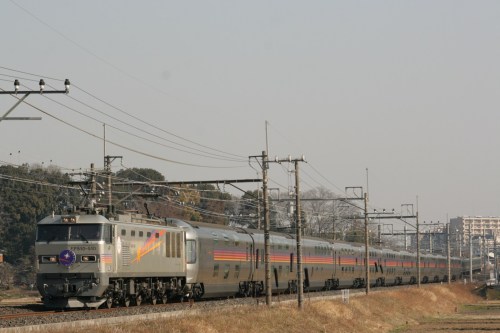
ヒガハスで「カシオペア」を撮る
2月28日、上野駅発着の最後の寝台特急列車となった「カシオペア」を、昨年これまた当時廃止直前だった「北斗星」を撮影した、「ヒガハス」こと東北本線蓮田駅~東大宮駅間で撮影した。現地はやはり人気列車のラストラン間近とだけあって、多くの撮り鉄がカメラを構えていた。「カシオペア」の現地通過時刻は8:51頃。列車の接近を知らせる踏切の警報音が鳴り、カメラを構える。先頭のEF510形電気機関車がE26系とお揃いのシルバー塗装と流れ星が描かれた「カシオペア色」の車両で、編成全体の調和が取れていた。「カシオペア」から引退するE26系客車は、1999(平成11)年デビューと比較的新しいため、それほど老朽化しているとは言えず、今後の処遇が気になるところである。最も実用的なものとしては、これまでも運行実績がある、ツアー用の臨時列車(クルーズトレイン)に転用されるというものである。「カシオペア」はE26系が1編成しか存在しないことから、毎日の運行ができず、札幌行きと上野行きが1日おきに運行される臨時列車という扱いになっていたが、日常的に運行される特急列車。「カシオペア」の廃止によって、日常的に運行される寝台特急列車は「サンライズ瀬戸」と「サンライズ出雲」のみとなり、客車列車も急行「はまなす」も「カシオペア」と同日に廃止されることから、定期列車ではゼロ、臨時列車を含めるとJR九州77系客車による「ななつ星in九州」とこのE26系客車のクルーズトレインのみになる。On February 28th, I went photographing "Cassiopeia" sleeper train which is stopping its operation on this coming March 21st at Tohoku Main Line between Hasuda and Higashi-omiya.As I came there, many photographers had already waited for the train because "Cassiopeia" is of the railfans.If it operated on schedule, it passed there around 8:51. At the same time as a crossing signal rang, the photographers including me set their camera. Class EF510 electric locomotive hauling E26 Series passenger carriage "Cassiopeia" was coloured silver and a shooting star and 5 colour lines the same as E26 Series were painted on its body.E26 Series debuted in 1999 and it is said that the carriage doesn't become deteriorated for serving, so it is said that E26 Series changes to the one for special train for tourists, which has operated several times, among railfans.Though "Cassiopeia" has been operated almost every other day, because only one set of E26 Series exists, it has been regarded as a train regularly in service. After stopping operation of "Cassiopeia", "Sunrise Seto", serving between Tokyo and Takamatsu, and "Sunrise Izumo", between Tokyo and Izumoshi, only remain as the sleeper train in Japan, and there will be no regular train hauled by locomotives because "Hamanasu" overnight express, running between Aomori and Sapporo, stops its service as well as "Cassiopeia" on the same day.
Feb 28, 2016
コメント(0)
-

西武&東急4000系 石神井公園駅発車
8両編成に短縮された東急4000系(4106F)と西武4000系が石神井公園駅をほぼ同時に発車する光景。2013(平成25)年3月の東急東横線・東京メトロ副都心線直通運転開始以来、西武と東急、両社の4000系車両が西武池袋線内で顔を合わせる光景が見られるようになった。しかし西武4000系は土休日に運行される秩父鉄道秩父本線直通の朝の快速急行列車と夕方の急行列車でのみ池袋駅~飯能駅間に姿を見せず、一方の東急4000系は、10両編成を主体とするため、西武池袋線では主に快速急行列車として運行され、練馬駅~石神井公園駅間の複々線区間は急行線を走るため、この2車種が同一方向に同時発車する光景は、東急側が8両編成の4106Fである必要があり、なかなか見られない。飯能駅で2車種が、西武秩父行き各停列車と元町・中華街行き快速急行列車として並んでいる姿を見たことは、僕も何度かあったが、西武4000系の急行列車と、1編成しかいない8両編成の東急4000系とが石神井公園駅で同時発車する光景には、今回初めて遭遇した。On February 27th, I shot the video that Seibu 4000 Series and Tokyu 4000 Series (4106F 8-carriage set) depart from Shakujii-koen Station on Seibu Ikebukuro Line at almost the same time.Since the going-through service between Tokyu Toyoko Line and Tokyo Metro Fukutoshin Line started in 2013, the two 4000 Series carriages sometimes meets on Seibu Ikebukuro Line. However, it may be rare that the two go toward the same direction at Shakujii-koen Station because both Seibu 4000 Series, running only on holiday morning and evening between Hanno and Ikebukuro, and Tokyu 4000 Series, mainly consisting of 10 carriages and being in service as rapid express train, run on express track between Shakujii-koen and Nerima. Though I have seen the two stop at Hanno Station several times, it was first time to see the two depart almost the same time toward the same direction on the quadrable track section.
Feb 27, 2016
コメント(0)
全1051件 (1051件中 201-250件目)
-
-

- がんばれ!地方競馬♪
- 11/13名古屋・園田の1点勝負+川崎
- (2024-11-12 23:11:18)
-
-
-

- アニメ・特撮・ゲーム
- 白い砂のアクアトープ 3話視聴
- (2024-11-11 22:30:40)
-
-
-
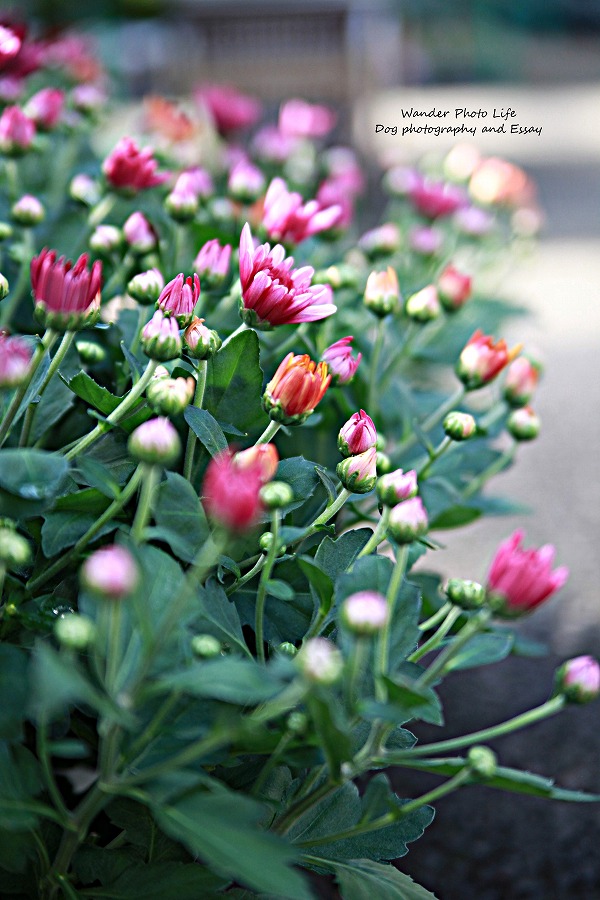
- フォトライフ
- 源氏物語〔10帖 賢木 13〕
- (2024-11-12 10:20:08)
-








